Motorola Mobility T56DP1 Portable Cellular/ PCS Transceiver (AMPS/CDMA) User Manual UG C330 GSM
Motorola Mobility LLC Portable Cellular/ PCS Transceiver (AMPS/CDMA) UG C330 GSM
Contents
- 1. Exhibit 8 Preliminary Users Manual
- 2. Supp Response to CRN231105AIHD
- 3. Users Manual per CRN 10580
Exhibit 8 Preliminary Users Manual

APPLICANT: MOTOROLA, INC. FCC ID: IHDT56DP1
EXHIBIT 8
INSTRUCTION MANUAL
A preliminary draft copy of the Users Manual follows:

User’s Guide
Vision-enabled PCS Phone
Model [xx]
Manufacturer’s
Logo
SPRINT-motorola8/27 2003.8.27 2:16 PM Page b

Table of Contents
Welcome to Sprint . . . . . . . . . . . . . . . . . . . . . . . . . . . . . . . . . . . . . . . . . . . .i
Introduction . . . . . . . . . . . . . . . . . . . . . . . . . . . . . . . . . . . . . . . . . . . . . . . . .iii
Section 1: Getting Started . . . . . . . . . . . . . . . . . . . . . . . . . . . . . . . . . . . .1
1A. Setting Up Service . . . . . . . . . . . . . . . . . . . . . . . . . . . . . . . . . . . . . . . . . . . . . . . . . . . . .3
Getting Started With PCS Service . . . . . . . . . . . . . . . . . . . . . . . . . . . . . . . . . . . . . .4
Setting Up Your Voicemail . . . . . . . . . . . . . . . . . . . . . . . . . . . . . . . . . . . . . . . . . . . .5
Getting Help . . . . . . . . . . . . . . . . . . . . . . . . . . . . . . . . . . . . . . . . . . . . . . . . . . . . . . . .5
Section 2: Understanding Your PCS Phone . . . . . . . . . . . . . . . . . . .7
2A. Your PCS Phone: The Basics . . . . . . . . . . . . . . . . . . . . . . . . . . . . . . . . . . . . . . . . . .9
Front View of Phone . . . . . . . . . . . . . . . . . . . . . . . . . . . . . . . . . . . . . . . . . . . . . . . .10
Functions . . . . . . . . . . . . . . . . . . . . . . . . . . . . . . . . . . . . . . . . . . . . . . . . . . . . . . . . .11
Viewing the Display Screen . . . . . . . . . . . . . . . . . . . . . . . . . . . . . . . . . . . . . . . . .12
Features of Your PCS Phone . . . . . . . . . . . . . . . . . . . . . . . . . . . . . . . . . . . . . . . . .13
Turning Your Phone ON and OFF . . . . . . . . . . . . . . . . . . . . . . . . . . . . . . . . . . . .14
Using Your Phone’s Battery . . . . . . . . . . . . . . . . . . . . . . . . . . . . . . . . . . . . . . . . . .14
Replacing the Convertible Covers . . . . . . . . . . . . . . . . . . . . . . . . . . . . . . . . . . .17
Displaying Your Phone Number . . . . . . . . . . . . . . . . . . . . . . . . . . . . . . . . . . . . .18
Making and Answering Calls . . . . . . . . . . . . . . . . . . . . . . . . . . . . . . . . . . . . . . . . .18
Making Calls . . . . . . . . . . . . . . . . . . . . . . . . . . . . . . . . . . . . . . . . . . . . . . . . . . . . . .18
Answering Calls . . . . . . . . . . . . . . . . . . . . . . . . . . . . . . . . . . . . . . . . . . . . . . . . . . .19
External Display (Sub LCD) . . . . . . . . . . . . . . . . . . . . . . . . . . . . . . . . . . . . . . . .20
Smart Key . . . . . . . . . . . . . . . . . . . . . . . . . . . . . . . . . . . . . . . . . . . . . . . . . . . . . . . .21
Changing the Zoom Setting . . . . . . . . . . . . . . . . . . . . . . . . . . . . . . . . . . . . . . . .21
Volume Keys . . . . . . . . . . . . . . . . . . . . . . . . . . . . . . . . . . . . . . . . . . . . . . . . . . . . . .21
Redialing a Number . . . . . . . . . . . . . . . . . . . . . . . . . . . . . . . . . . . . . . . . . . . . . . .21
Using Automatic Redial . . . . . . . . . . . . . . . . . . . . . . . . . . . . . . . . . . . . . . . . . . . .22
Caller ID . . . . . . . . . . . . . . . . . . . . . . . . . . . . . . . . . . . . . . . . . . . . . . . . . . . . . . . . . .22
Returning an Unanswered Call . . . . . . . . . . . . . . . . . . . . . . . . . . . . . . . . . . . . .22
Dialing an Emergency Number . . . . . . . . . . . . . . . . . . . . . . . . . . . . . . . . . . . . .22
Entering Numbers in the Notepad . . . . . . . . . . . . . . . . . . . . . . . . . . . . . . . . . .23
Terminating an Incoming Call . . . . . . . . . . . . . . . . . . . . . . . . . . . . . . . . . . . . . .23
Dialing With Speed Dial . . . . . . . . . . . . . . . . . . . . . . . . . . . . . . . . . . . . . . . . . . . .23
Dialing With 1-Touch Dial . . . . . . . . . . . . . . . . . . . . . . . . . . . . . . . . . . . . . . . . . .23
Dialing a Number In a Text Message . . . . . . . . . . . . . . . . . . . . . . . . . . . . . . . . .23
Additional Dialing Features . . . . . . . . . . . . . . . . . . . . . . . . . . . . . . . . . . . . . . . .24
Using Features While On a Call . . . . . . . . . . . . . . . . . . . . . . . . . . . . . . . . . . . . . . .25
SPRINT-motorola8/27 2003.8.27 2:16 PM Page d

Version . . . . . . . . . . . . . . . . . . . . . . . . . . . . . . . . . . . . . . . . . . . . . . . . . . . . . . . . . . .50
2C. Setting Your Phone’s Security . . . . . . . . . . . . . . . . . . . . . . . . . . . . . . . . . . . . . . . .51
Setting Your Phone’s Security . . . . . . . . . . . . . . . . . . . . . . . . . . . . . . . . . . . . . . . .52
Lock Phone . . . . . . . . . . . . . . . . . . . . . . . . . . . . . . . . . . . . . . . . . . . . . . . . . . . . . . .52
Change Lock Code . . . . . . . . . . . . . . . . . . . . . . . . . . . . . . . . . . . . . . . . . . . . . . . .52
Phonebook Lock . . . . . . . . . . . . . . . . . . . . . . . . . . . . . . . . . . . . . . . . . . . . . . . . . .53
Erase Phonebook . . . . . . . . . . . . . . . . . . . . . . . . . . . . . . . . . . . . . . . . . . . . . . . . .53
Restrict Calls . . . . . . . . . . . . . . . . . . . . . . . . . . . . . . . . . . . . . . . . . . . . . . . . . . . . . .53
Limit Use . . . . . . . . . . . . . . . . . . . . . . . . . . . . . . . . . . . . . . . . . . . . . . . . . . . . . . . . .54
Master Reset . . . . . . . . . . . . . . . . . . . . . . . . . . . . . . . . . . . . . . . . . . . . . . . . . . . . . .56
Master Clear . . . . . . . . . . . . . . . . . . . . . . . . . . . . . . . . . . . . . . . . . . . . . . . . . . . . . .56
2D. Controlling Your Roaming Experience . . . . . . . . . . . . . . . . . . . . . . . . . . . . . . .57
Understanding Roaming . . . . . . . . . . . . . . . . . . . . . . . . . . . . . . . . . . . . . . . . . . . .58
Setting Your Phone’s Roam Mode . . . . . . . . . . . . . . . . . . . . . . . . . . . . . . . . . . . .60
Controlling Roaming Charges Using Call Guard . . . . . . . . . . . . . . . . . . . . . . .61
2E. Navigating Through Menus . . . . . . . . . . . . . . . . . . . . . . . . . . . . . . . . . . . . . . . . . .63
Menu Navigation . . . . . . . . . . . . . . . . . . . . . . . . . . . . . . . . . . . . . . . . . . . . . . . . . . .64
Menu Structure . . . . . . . . . . . . . . . . . . . . . . . . . . . . . . . . . . . . . . . . . . . . . . . . . . . . .64
Viewing the Menus . . . . . . . . . . . . . . . . . . . . . . . . . . . . . . . . . . . . . . . . . . . . . . . . .65
2F. Managing Call History . . . . . . . . . . . . . . . . . . . . . . . . . . . . . . . . . . . . . . . . . . . . . . .67
Viewing History . . . . . . . . . . . . . . . . . . . . . . . . . . . . . . . . . . . . . . . . . . . . . . . . . . . .68
Outgoing Calls . . . . . . . . . . . . . . . . . . . . . . . . . . . . . . . . . . . . . . . . . . . . . . . . . . . .68
Incoming Calls . . . . . . . . . . . . . . . . . . . . . . . . . . . . . . . . . . . . . . . . . . . . . . . . . . . .69
Missed Calls . . . . . . . . . . . . . . . . . . . . . . . . . . . . . . . . . . . . . . . . . . . . . . . . . . . . . . .69
Erase History . . . . . . . . . . . . . . . . . . . . . . . . . . . . . . . . . . . . . . . . . . . . . . . . . . . . . .70
2G. Using the Internal Phone Book . . . . . . . . . . . . . . . . . . . . . . . . . . . . . . . . . . . . . . .73
Internal Phone Book Entry Options . . . . . . . . . . . . . . . . . . . . . . . . . . . . . . . . . .74
Entering Text . . . . . . . . . . . . . . . . . . . . . . . . . . . . . . . . . . . . . . . . . . . . . . . . . . . . . . .74
Selecting a Character Input Mode . . . . . . . . . . . . . . . . . . . . . . . . . . . . . . . . . .74
Tap Method . . . . . . . . . . . . . . . . . . . . . . . . . . . . . . . . . . . . . . . . . . . . . . . . . . . . . . .75
General Text Entry Rules . . . . . . . . . . . . . . . . . . . . . . . . . . . . . . . . . . . . . . . . . . .75
Character Chart . . . . . . . . . . . . . . . . . . . . . . . . . . . . . . . . . . . . . . . . . . . . . . . . . . .76
Entering Symbol . . . . . . . . . . . . . . . . . . . . . . . . . . . . . . . . . . . . . . . . . . . . . . . . . .76
Predictive Text Entry with iTAP™ Software . . . . . . . . . . . . . . . . . . . . . . . . .76
Enter Novel Words . . . . . . . . . . . . . . . . . . . . . . . . . . . . . . . . . . . . . . . . . . . . . . . . .77
Punctuation . . . . . . . . . . . . . . . . . . . . . . . . . . . . . . . . . . . . . . . . . . . . . . . . . . . . . .77
Using Call Waiting . . . . . . . . . . . . . . . . . . . . . . . . . . . . . . . . . . . . . . . . . . . . . . . . .25
Making a Conference Call . . . . . . . . . . . . . . . . . . . . . . . . . . . . . . . . . . . . . . . . . .25
Transferring a Call . . . . . . . . . . . . . . . . . . . . . . . . . . . . . . . . . . . . . . . . . . . . . . . . .25
Additional On-Call Features . . . . . . . . . . . . . . . . . . . . . . . . . . . . . . . . . . . . . . . .26
Saving a Phone Number . . . . . . . . . . . . . . . . . . . . . . . . . . . . . . . . . . . . . . . . . . .27
Finding a Phone Number . . . . . . . . . . . . . . . . . . . . . . . . . . . . . . . . . . . . . . . . . .27
Dialing and Saving Phone Numbers With Pauses . . . . . . . . . . . . . . . . . . . . .28
Dialing From the Internal Phone Book . . . . . . . . . . . . . . . . . . . . . . . . . . . . . .29
2B. Controlling Your Phone’s Settings . . . . . . . . . . . . . . . . . . . . . . . . . . . . . . . . . . .31
Sounds Settings . . . . . . . . . . . . . . . . . . . . . . . . . . . . . . . . . . . . . . . . . . . . . . . . . . . .32
Volume . . . . . . . . . . . . . . . . . . . . . . . . . . . . . . . . . . . . . . . . . . . . . . . . . . . . . . . . . . .32
Ringer Types . . . . . . . . . . . . . . . . . . . . . . . . . . . . . . . . . . . . . . . . . . . . . . . . . . . . . .34
Alerts . . . . . . . . . . . . . . . . . . . . . . . . . . . . . . . . . . . . . . . . . . . . . . . . . . . . . . . . . . . .36
Tones . . . . . . . . . . . . . . . . . . . . . . . . . . . . . . . . . . . . . . . . . . . . . . . . . . . . . . . . . . . .37
Display Settings . . . . . . . . . . . . . . . . . . . . . . . . . . . . . . . . . . . . . . . . . . . . . . . . . . . .40
Menu Display . . . . . . . . . . . . . . . . . . . . . . . . . . . . . . . . . . . . . . . . . . . . . . . . . . . . .40
Standby Display . . . . . . . . . . . . . . . . . . . . . . . . . . . . . . . . . . . . . . . . . . . . . . . . . . .40
Assign Keys . . . . . . . . . . . . . . . . . . . . . . . . . . . . . . . . . . . . . . . . . . . . . . . . . . . . . . .41
Backlight Control . . . . . . . . . . . . . . . . . . . . . . . . . . . . . . . . . . . . . . . . . . . . . . . . .43
Greetings . . . . . . . . . . . . . . . . . . . . . . . . . . . . . . . . . . . . . . . . . . . . . . . . . . . . . . . . .43
Contrast . . . . . . . . . . . . . . . . . . . . . . . . . . . . . . . . . . . . . . . . . . . . . . . . . . . . . . . . . .43
Font Size . . . . . . . . . . . . . . . . . . . . . . . . . . . . . . . . . . . . . . . . . . . . . . . . . . . . . . . . . .44
Time and Date . . . . . . . . . . . . . . . . . . . . . . . . . . . . . . . . . . . . . . . . . . . . . . . . . . . .44
Sleep Mode . . . . . . . . . . . . . . . . . . . . . . . . . . . . . . . . . . . . . . . . . . . . . . . . . . . . . . .44
Location Settings . . . . . . . . . . . . . . . . . . . . . . . . . . . . . . . . . . . . . . . . . . . . . . . . . . .45
Others Settings . . . . . . . . . . . . . . . . . . . . . . . . . . . . . . . . . . . . . . . . . . . . . . . . . . . . .45
Language . . . . . . . . . . . . . . . . . . . . . . . . . . . . . . . . . . . . . . . . . . . . . . . . . . . . . . . . .45
Answer Options . . . . . . . . . . . . . . . . . . . . . . . . . . . . . . . . . . . . . . . . . . . . . . . . . . .46
Speed Dial . . . . . . . . . . . . . . . . . . . . . . . . . . . . . . . . . . . . . . . . . . . . . . . . . . . . . . . .47
Abbrev.Dial . . . . . . . . . . . . . . . . . . . . . . . . . . . . . . . . . . . . . . . . . . . . . . . . . . . . . . .47
Auto Redial . . . . . . . . . . . . . . . . . . . . . . . . . . . . . . . . . . . . . . . . . . . . . . . . . . . . . . .47
Airplane Mode . . . . . . . . . . . . . . . . . . . . . . . . . . . . . . . . . . . . . . . . . . . . . . . . . . . .47
TTY Settings . . . . . . . . . . . . . . . . . . . . . . . . . . . . . . . . . . . . . . . . . . . . . . . . . . . . . .48
Phonebook Match . . . . . . . . . . . . . . . . . . . . . . . . . . . . . . . . . . . . . . . . . . . . . . . . .49
Phone Info . . . . . . . . . . . . . . . . . . . . . . . . . . . . . . . . . . . . . . . . . . . . . . . . . . . . . . . . .49
My Phone Number . . . . . . . . . . . . . . . . . . . . . . . . . . . . . . . . . . . . . . . . . . . . . . . .49
Icon Glossary . . . . . . . . . . . . . . . . . . . . . . . . . . . . . . . . . . . . . . . . . . . . . . . . . . . . .49
SPRINT-motorola8/27 2003.8.27 2:16 PM Page f

2K. Using Your Phone’s Shortcuts . . . . . . . . . . . . . . . . . . . . . . . . . . . . . . . . . . . . . . . .97
Creating a Shortcut . . . . . . . . . . . . . . . . . . . . . . . . . . . . . . . . . . . . . . . . . . . . . . . . .98
Editing a Shortcut . . . . . . . . . . . . . . . . . . . . . . . . . . . . . . . . . . . . . . . . . . . . . . . . . .98
Using Shortcuts . . . . . . . . . . . . . . . . . . . . . . . . . . . . . . . . . . . . . . . . . . . . . . . . . . . .99
Delete a Shortcut . . . . . . . . . . . . . . . . . . . . . . . . . . . . . . . . . . . . . . . . . . . . . . . . . . .99
Section 3: Using PCS Service Features . . . . . . . . . . . . . . . . . . . .101
3A. PCS Service Features: The Basics . . . . . . . . . . . . . . . . . . . . . . . . . . . . . . . . . .103
Using Voicemail . . . . . . . . . . . . . . . . . . . . . . . . . . . . . . . . . . . . . . . . . . . . . . . . . . .104
Setting Up Your Voicemail . . . . . . . . . . . . . . . . . . . . . . . . . . . . . . . . . . . . . . . . .104
Voicemail Notification . . . . . . . . . . . . . . . . . . . . . . . . . . . . . . . . . . . . . . . . . . .104
Retrieving Your Voicemail Messages . . . . . . . . . . . . . . . . . . . . . . . . . . . . . . .104
Voicemail Options . . . . . . . . . . . . . . . . . . . . . . . . . . . . . . . . . . . . . . . . . . . . . . .105
Clearing the Message Icon . . . . . . . . . . . . . . . . . . . . . . . . . . . . . . . . . . . . . . . .108
Voicemail Menu Key . . . . . . . . . . . . . . . . . . . . . . . . . . . . . . . . . . . . . . . . . . . . .109
Using Caller ID . . . . . . . . . . . . . . . . . . . . . . . . . . . . . . . . . . . . . . . . . . . . . . . . . . . .110
Responding to Call Waiting . . . . . . . . . . . . . . . . . . . . . . . . . . . . . . . . . . . . . . . . .110
Making a Three-Way Call . . . . . . . . . . . . . . . . . . . . . . . . . . . . . . . . . . . . . . . . . . .110
Using Call Forwarding . . . . . . . . . . . . . . . . . . . . . . . . . . . . . . . . . . . . . . . . . . . . .111
3B. PCS VisionSM . . . . . . . . . . . . . . . . . . . . . . . . . . . . . . . . . . . . . . . . . . . . . . . . . . . . . . . . .113
Messaging . . . . . . . . . . . . . . . . . . . . . . . . . . . . . . . . . . . . . . . . . . . . . . . . . . . . . . . .114
Compose . . . . . . . . . . . . . . . . . . . . . . . . . . . . . . . . . . . . . . . . . . . . . . . . . . . . . . . .114
Inbox . . . . . . . . . . . . . . . . . . . . . . . . . . . . . . . . . . . . . . . . . . . . . . . . . . . . . . . . . . .115
Outbox . . . . . . . . . . . . . . . . . . . . . . . . . . . . . . . . . . . . . . . . . . . . . . . . . . . . . . . . .116
Sent Folder . . . . . . . . . . . . . . . . . . . . . . . . . . . . . . . . . . . . . . . . . . . . . . . . . . . . . .117
Drafts Folder . . . . . . . . . . . . . . . . . . . . . . . . . . . . . . . . . . . . . . . . . . . . . . . . . . . . .118
Quick Notes . . . . . . . . . . . . . . . . . . . . . . . . . . . . . . . . . . . . . . . . . . . . . . . . . . . . .118
Settings . . . . . . . . . . . . . . . . . . . . . . . . . . . . . . . . . . . . . . . . . . . . . . . . . . . . . . . . .119
PCS Business ConnectionSM Personal Edition . . . . . . . . . . . . . . . . . . . . . . . . .120
3C. PCS Voice CommandSM . . . . . . . . . . . . . . . . . . . . . . . . . . . . . . . . . . . . . . . . . . . . . . .121
Getting Started With PCS Voice CommandTM . . . . . . . . . . . . . . . . . . . . . . . . . .122
Creating Your Own Address Book . . . . . . . . . . . . . . . . . . . . . . . . . . . . . . . . . . .122
Making a Call With PCS Voice Command . . . . . . . . . . . . . . . . . . . . . . . . . . . .123
Section 4: Safety Guidelines and Warranty Information . . .125
4A. Safety . . . . . . . . . . . . . . . . . . . . . . . . . . . . . . . . . . . . . . . . . . . . . . . . . . . . . . . . . . . . . . .127
Getting the Most Out of Your Reception . . . . . . . . . . . . . . . . . . . . . . . . . . . . .128
Maintaining Safe Use of and Access to Your Phone . . . . . . . . . . . . . . . . . . . .129
Capitalization . . . . . . . . . . . . . . . . . . . . . . . . . . . . . . . . . . . . . . . . . . . . . . . . . . . . .77
Enter Numbers . . . . . . . . . . . . . . . . . . . . . . . . . . . . . . . . . . . . . . . . . . . . . . . . . . . .78
Delete Letters and Words . . . . . . . . . . . . . . . . . . . . . . . . . . . . . . . . . . . . . . . . . .78
Adding a New Internal Phone Book Entry . . . . . . . . . . . . . . . . . . . . . . . . . . . .79
Finding Internal Phone Book Entries . . . . . . . . . . . . . . . . . . . . . . . . . . . . . . . . .79
Find Name . . . . . . . . . . . . . . . . . . . . . . . . . . . . . . . . . . . . . . . . . . . . . . . . . . . . . . . .79
My Phone # . . . . . . . . . . . . . . . . . . . . . . . . . . . . . . . . . . . . . . . . . . . . . . . . . . . . . . . .80
Speed Dial #’s . . . . . . . . . . . . . . . . . . . . . . . . . . . . . . . . . . . . . . . . . . . . . . . . . . . . . .81
Voice Names . . . . . . . . . . . . . . . . . . . . . . . . . . . . . . . . . . . . . . . . . . . . . . . . . . . . . . .81
Long Phone #’s . . . . . . . . . . . . . . . . . . . . . . . . . . . . . . . . . . . . . . . . . . . . . . . . . . . . .82
Services . . . . . . . . . . . . . . . . . . . . . . . . . . . . . . . . . . . . . . . . . . . . . . . . . . . . . . . . . . .82
Phone Book Status . . . . . . . . . . . . . . . . . . . . . . . . . . . . . . . . . . . . . . . . . . . . . . . . . .82
Erase Phone Book . . . . . . . . . . . . . . . . . . . . . . . . . . . . . . . . . . . . . . . . . . . . . . . . . .83
2H. Personal Organizer . . . . . . . . . . . . . . . . . . . . . . . . . . . . . . . . . . . . . . . . . . . . . . . . . . .85
Datebook . . . . . . . . . . . . . . . . . . . . . . . . . . . . . . . . . . . . . . . . . . . . . . . . . . . . . . . . . .86
Adding a Datebook Event . . . . . . . . . . . . . . . . . . . . . . . . . . . . . . . . . . . . . . . . . .86
Changing Event Information . . . . . . . . . . . . . . . . . . . . . . . . . . . . . . . . . . . . . . .87
Alarm Clock . . . . . . . . . . . . . . . . . . . . . . . . . . . . . . . . . . . . . . . . . . . . . . . . . . . . . . . .87
Changing Alarm Information . . . . . . . . . . . . . . . . . . . . . . . . . . . . . . . . . . . . . . .88
Calculator . . . . . . . . . . . . . . . . . . . . . . . . . . . . . . . . . . . . . . . . . . . . . . . . . . . . . . . . .89
Calculator Options . . . . . . . . . . . . . . . . . . . . . . . . . . . . . . . . . . . . . . . . . . . . . . . .89
World Clock . . . . . . . . . . . . . . . . . . . . . . . . . . . . . . . . . . . . . . . . . . . . . . . . . . . . . . . .90
Stopwatch/Timer . . . . . . . . . . . . . . . . . . . . . . . . . . . . . . . . . . . . . . . . . . . . . . . . . .90
2I. Using Your Phone’s Voice Services . . . . . . . . . . . . . . . . . . . . . . . . . . . . . . . . . .91
Recording Voice Memos . . . . . . . . . . . . . . . . . . . . . . . . . . . . . . . . . . . . . . . . . . . .92
Play Voice Memo . . . . . . . . . . . . . . . . . . . . . . . . . . . . . . . . . . . . . . . . . . . . . . . . . . .92
Erasing Voice Memos . . . . . . . . . . . . . . . . . . . . . . . . . . . . . . . . . . . . . . . . . . . . . . .92
2J. Using Your Phone’s Games . . . . . . . . . . . . . . . . . . . . . . . . . . . . . . . . . . . . . . . . . . .93
Bejeweled . . . . . . . . . . . . . . . . . . . . . . . . . . . . . . . . . . . . . . . . . . . . . . . . . . . . . . . . .94
Play a Game . . . . . . . . . . . . . . . . . . . . . . . . . . . . . . . . . . . . . . . . . . . . . . . . . . . . . . .94
Game Menus . . . . . . . . . . . . . . . . . . . . . . . . . . . . . . . . . . . . . . . . . . . . . . . . . . . . . .94
Bowling . . . . . . . . . . . . . . . . . . . . . . . . . . . . . . . . . . . . . . . . . . . . . . . . . . . . . . . . . . .95
Play a Game . . . . . . . . . . . . . . . . . . . . . . . . . . . . . . . . . . . . . . . . . . . . . . . . . . . . . . .95
Game Menus . . . . . . . . . . . . . . . . . . . . . . . . . . . . . . . . . . . . . . . . . . . . . . . . . . . . . .95
Football . . . . . . . . . . . . . . . . . . . . . . . . . . . . . . . . . . . . . . . . . . . . . . . . . . . . . . . . . . . .96
Play a Game . . . . . . . . . . . . . . . . . . . . . . . . . . . . . . . . . . . . . . . . . . . . . . . . . . . . . . .96
Game Menus . . . . . . . . . . . . . . . . . . . . . . . . . . . . . . . . . . . . . . . . . . . . . . . . . . . . . .96
SPRINT-motorola8/27 2003.8.27 2:16 PM Page h

Caring for the Battery . . . . . . . . . . . . . . . . . . . . . . . . . . . . . . . . . . . . . . . . . . . . . .132
Acknowledging Special Precautions and the FCC Notice . . . . . . . . . . . . .133
Consumer Information on Wireless Phones . . . . . . . . . . . . . . . . . . . . . . . . .135
Owner’s Record . . . . . . . . . . . . . . . . . . . . . . . . . . . . . . . . . . . . . . . . . . . . . . . . . . .153
User Guide Proprietary Notice . . . . . . . . . . . . . . . . . . . . . . . . . . . . . . . . . . . . .153
4B. Warranty . . . . . . . . . . . . . . . . . . . . . . . . . . . . . . . . . . . . . . . . . . . . . . . . . . . . . . . . . . . .155
Manufacturer’s Warranty . . . . . . . . . . . . . . . . . . . . . . . . . . . . . . . . . . . . . . . . . . .156
Index . . . . . . . . . . . . . . . . . . . . . . . . . . . . . . . . . . . . . . . . . . . . . . . . . . . . . . .160
Welcome to Sprint
Sprint built the largest all-digital,all-PCS nationwide network with
advanced multimedia services,reaching more than 230 million
people for clarity you can see and hear.We built our network to give you
what we believe you really want from a wireless phone,clear sound,
private conversations,and time-saving features.
But with Sprint,you can do something even more far-reaching :simplify
your life.Our advanced technology is designed to grow with your
communications needs so that one day you'll be able to rely entirely on
your PCS Phone to stay connected.
This guide will familiarize you with our technology and your new
Vision-enabled PCS Phone through simple,easy-to-follow instructions.
If you have already reviewed the Start Here Guide,which was packaged
with your new phone,then you're ready to explore the advanced
features outlined in this guide.
If you have not read your Start Here Guide,go to Section One - Getting
Started.This section provides all the information you need to quickly
activate your phone,set up your voicemail,and much more.It also
contains information on how to contact Sprint should you have
questions about service,wish to check your account balance,
or want to purchase additional products or services.
Thank you for choosing Sprint.
i
SPRINT-motorola8/27 2003.8.27 2:16 PM Page j

Introduction
This User's Guide introduces you to PCS Service and all the features
of your new phone.It's divided into four sections:
Section 1: Getting Started
Section 2: Understanding Your Phone
Section 3: Using PCS Service Features
Section 4: Safety Guidelines and Warranty Information
Throughout the guide,you'll find tips that highlight special shortcuts
and timely reminders to help you make the most of your new phone
and service.The Table of Contents and Index will help you locate
specific information quickly.
You'll get the most out of your phone if you read each section.However,
if you'd like to get right to a specific feature,simply turn to that page.
Follow the instructions in that section and you'll be ready to use your
phone in no time.
Tip: You can print this guide to keep on hand or view it online. If you're
viewing it online, simply click on a topic in the Table of Contents or Index on
any page reference within a section. The PDF will automatically display the
appropriate page.
iiiii
SPRINT-motorola8/27 2003.8.27 2:16 PM Page ii

Getting Started
Section 1
SPRINT-motorola8/27 2003.8.27 2:16 PM Page iv

Section 1A
Setting Up Service
In This Section
Getting Started With PCS Service
Setting Up Your Voicemail
Getting Help
This section walks you through setting up service for your
PCS Phone,unlocking your phone,setting up your voicemail,
and contacting Sprint for assistance with your PCS Service.
Section 1: Getting Started
1A: Setting Up Service 3
SPRINT-motorola8/27 2003.8.27 2:16 PM Page 2

Setting Up Your Voicemail
All unanswered calls to your PCS Phone are automatically transferred
to voicemail,even if your phone is in use or turned off.Therefore,you
will want to set up your voicemail and personal greeting as soon as
your PCS Phone is activated.
To set up voicemail:
1. Press (Menu) to access the main menu.
2. Select Voice Mail,press (OK) or (Select).
3. Follow the system prompts to create your pass code,record your
greeting,record your name announcement,and choose whether
to activate One-Touch Message Access (a feature that lets you
access messages simply by pressing and holding ,bypassing
the need for you to enter your pass code).
Note: The voicemail setup process may vary in certain Affiliate areas.
For more information about using your voicemail,
see “Using Voicemail” on pa ge 104.
Getting Help
Visiting Our Web Site
Stop by www.sprintpcs.comand log on to get up-to-date information on
PCS Services,options and more.
You can also:
Review coverage maps
Learn how to use voicemail
Access your account information
Purchase accessories
Add additional options to your service plan
Check out frequently asked questions
And more
Section 1: Getting Started
1A: Setting Up Service 5
Getting Started With PCS Service
Determine if Your Phone is Already Activated
If you received your phone in the mail or purchased it at a Sprint
Store,it probably has been activated.All you need to do is unlock your
phone.
If your phone is not activated,please refer to the Start Here Guide
included with your phone.
Unlocking Your Phone
Follow these steps to unlock your phone:
1. Press and hold to turn the phone on.
2. When “Password”appears on the display enter your 4-digit
password to unlock your phone.
Tip: If you can’t recall your lock code, try using the last four digits of either your
Social Security number or PCS Phone Number or try 0000. If none of these
work, call PCS Customer Service SolutionsSM at 1-888-211-4PCS (4727).
Activating Your Phone
To activate your phone,follow the directions in the Start Here Guide
included with your phone.You can also visit
http://activate.sprintpcs.comand activate your phone online.
Section 1: Getting Started
1A: Setting Up Service 4
SPRINT-motorola8/27 2003.8.27 2:16 PM Page 4

Understanding Your
PCS Phone
Section 2
Reaching PCS Customer Service SolutionsSM
You can reach PCS Customer Service Solutions by:
Dialing on your PCS Phone
Logging on to your account at www.sprintpcs.com
Calling us toll-free at 1-888-211-4727 (Consumer customers),
1-877-CLEARPY (253-2779) (Clear Pay customers),or
1-888-788-4727 (Business customers)
Writing to us at PCS Customer Solutions,P.O.Box 8077,
London,KY 40742
Receiving Automated Usage and Invoicing Information
For your convenience,your phone gives you access to invoicing
information on your PCS Account.This information includes
balance due,payment received,invoicing cycle,and the number of
minutes used since your last invoicing cycle.(Normal airtime usage
will apply.)
To access this information:
Press .
Note: This service may not be available in all Affiliate markets.
PCS Directory Assistance
PCS Directory Assistance provides a variety of services,including
residential,business,and government listings;assistance with local
or long-distance calls;movie listings;hotel,restaurant,shopping,and
major local event information.There is a per-call charge and you will
be billed for airtime.
Press .
PCS Operator Services
PCS Operator Services can provide assistance in placing collect calls
or calls billed to a local telephone calling card or third party.
Press .
For more information or to see the latest in products and services,
visit us online at www.sprintpcs.com.
Note: PCS Operator Services may not be available in all Affiliate markets.
Section 1: Getting Started
1A: Setting Up Service 6
SPRINT-motorola8/27 2003.8.27 2:16 PM Page 6

Section 2A
Your PCS Phone:The Basics
In This Section
Front View of Phone
Viewing the Display Screen
Features of Your PCS Phone
Turning Your Phone On and Off
Using Your Phone’s Battery
Replacing the Convertible Covers
Displaying Your Phone Number
Making and Answering Calls
Using Features While On a Call
Your PCS Phone is packed with features that simplify your life and
expand your ability to stay connected to the people and
information that are important to you.This section will guide you
through the basic functions and calling features of your phone.
Section 2: Understanding Your PCS Phone
2A:Your PCS Phone – The Basics 9
SPRINT-motorola8/27 2003.8.27 2:16 PM Page 8
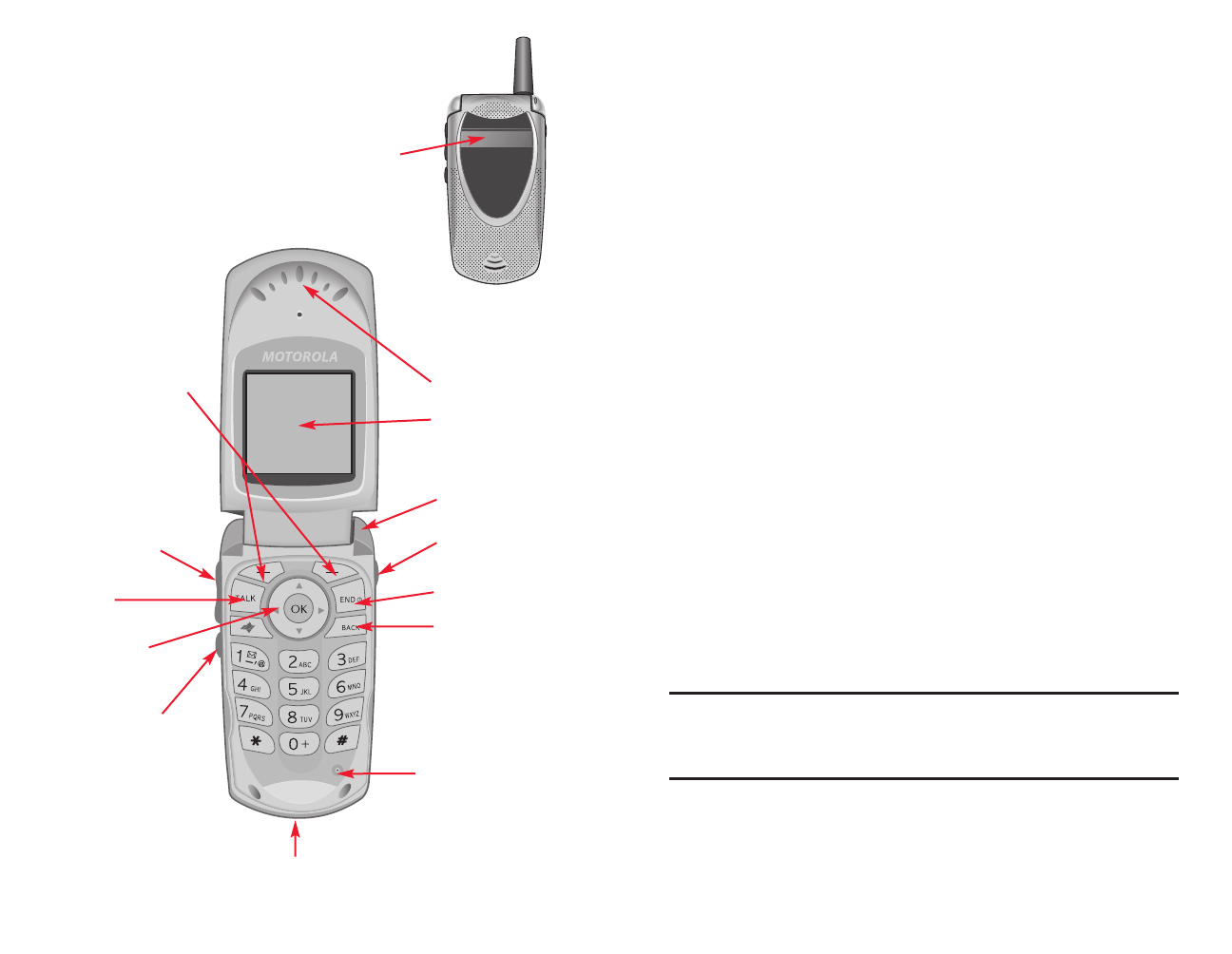
Functions
1. Soft Key: (Left) Lets you select the menu (option) corresponding
to the bottom left line on the Display Screen.(Right) Lets you
select the menu (option) corresponding to the bottom right
line on the Display Screen.
2. Volume Key: Use the upper and lower volume keys to adjust your
phone’s earpiece and ringer volume,and to mute the incoming
call alert.You can also use the volume keys to scroll up or down
through menus and lists.
3. Send Key: Send and answer calls,view recent dialed calls list.
4. Navigation Key:Move through menus and lists.
5. Smart Key: Select menu items,send and end calls.
6. Accessory Connector Port: Insert charger and phone accessories.
7. Microphone: You should speak into this microphone.
8. Back Key: Allows you to clear characters from the screen,mute
ringer when receiving incoming calls,back up menu levels or
display Time/Date while the phone is in use.
9. End (Power) Key: Press to turn the phone on/off,end phone calls
exit menu system.
10. Voice Key: Record voice notes,phonebook and shortcut names.
11. Status Light: The status light tells you when you have an
incoming call or message,or when your phone is roaming (using
a non-home system).The light changes color to indicate different
states:alternating red/green: incoming call, flashing green:
in service,home system, flashing yellow: roaming,non-home
system,flashing red: no service, alternating yellow/green: text or
voicemail message received.
Note: By default, the status light indicator is turned off to extend battery life.
Turning on the status light will substantially reduce your phone’s standby time
(the length of time that your phone’s battery retains power when the phone is
turned on but is not in use).
12. Main LCD (display): Displays the phone’s main menu,features,
modes,etc.
13. Earpiece: Lets you hear the caller’s voice and voice prompts.
Section 2: Understanding Your PCS Phone
2A:Your PCS Phone – The Basics 11
Front View of Phone
Section 2: Understanding Your PCS Phone
2A:Your PCS Phone – The Basics 10
Section 2: Understanding Your PCS Phone
2A:Your PCS Phone – The Basics 11
1. Softkey Buttons
3. Send
4. Navigation
Key
5. Smart Key
6. Accessory Connector Port
2. Volume Key
9. End (Power)
8. Back Key
7. Microphone
10. Voice Key
11. Status Light
12. Main LCD
13. Earpiece
14. Sub LCD
SPRINT-motorola8/27 2003.8.27 2:16 PM Page 10

Features of Your PCS Phone
Congratulations on the purchase of your PCS Phone.This phone is
lightweight,easy-to-use,and reliable.It also offers many significant
features and service options:
Dual-band capability provides access to other PCS Digital and
Analog Networks where Sprint has implemented roaming
agreements (page 57).
The built-in organizer lets you schedule alerts to remind you of
important events (page 86).
Three hundred internal phone book entries store up to five
phone numbers each (page 79).
You can dial Speed Dial entries using one key press for locations
1-9 or two key presses for locations 10-20 (page 81).
Your PCS Phone is equipped with a Location feature which will
allow the network to detect your position,making some PCS
Applications easier to use.(page 45).
Section 2: Understanding Your PCS Phone
2A:Your PCS Phone – The Basics 13
Section 2: Understanding Your PCS Phone
2A:Your PCS Phone – The Basics 12
14. Sub LCD (display): When the clamshell is closed,it’s useful to see
the various status of the phone on this screen.All the Sub LCD
indications are deleted when you open the clamshell except
previewing several settings.
Viewing the Display Screen
This list identifies the symbols you’ll see on your display screen.
Shows the strength of your phone’s connection with the
network.You cannot send or receive calls when the “no signal”
indicator is displayed.
Appears when a call is in progress.
Appears when your phone uses another network system
outside your home network.When you leave your home network
area,your phone roams or seeks another network.
Appears when your phone receives a text message.
Appears when you receive a voicemail message.
Shows the amount of charge left in your battery.The more
segments visible,the greater the charge.Recharge your battery as
soon as possible when you see the “Low Battery”warning
message.
Tip: When you charge the battery, the battery level indicator instead shows
how much of the charging process is complete.
GPRS Your service provider may use one of these indicators
to indicate that a GPRS packet data connection is active.This type
of connection may be used by your service provider to allow
faster data transfer speeds.The GPRS indicator does not mean that
you are in a call;it indicates only that you are registered on the
network via a GPRS connection.
Shows the current selected alert profile.The default alert
setting is a ringer. Loud ring, Soft ring, Vibrate,
Ring and vibrate, Silent.
Tip: Display indicators let you know when you’re off the enhanced
Sprint Nationwide PCS Network
and whether you’re operating in digital
or analog mode.
SPRINT-motorola8/27 2003.8.27 2:16 PM Page 12
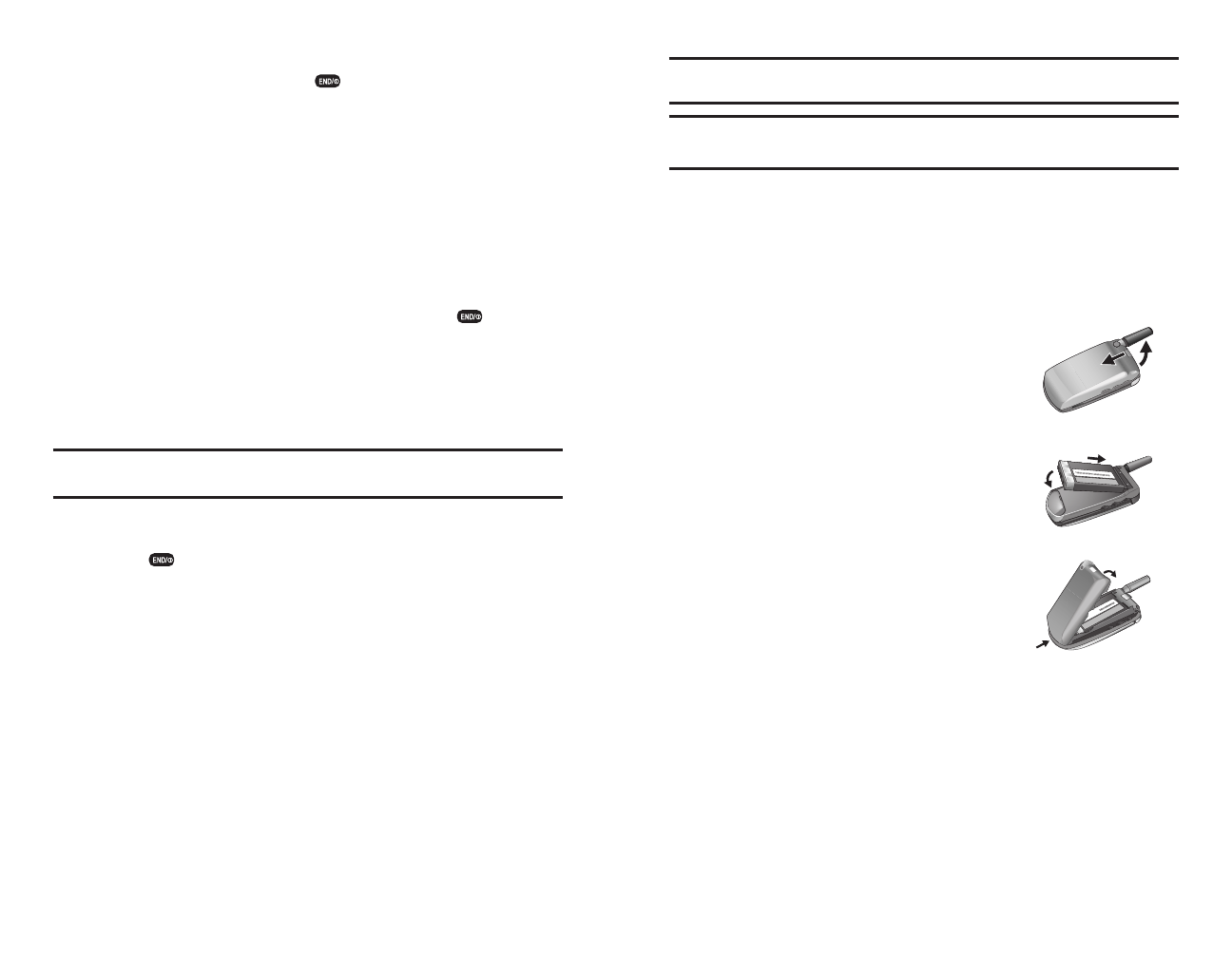
Original batteries and accessories.We recommend that you store
batteries in their protective cases when not in use.
Note: Long backlight settings, searching for service, vibrate mode, and
browser use affect the battery’s talk and standby times.
Tip: Be sure to watch your phone’s battery level indicator and charge the
battery before it runs out of power.
Installing the Battery
Before you can use your phone,you need to install and charge the
battery.
1. Remove the battery from its protective clear plastic case.
2. If the phone’s battery door is already in
place,push down the battery door
release latch and lift the battery door off
of the phone.
3. Insert the battery,printed arrow first,
into the battery compartment and
push down.
4. Insert the ridge at the bottom of the
battery door into the base of the
phone,then push the door down
and snap it into place.
Charging the Battery
Your PCS Phone comes with a rechargeable battery.You should
charge the battery as soon as possible so you can begin using your
phone.
Keeping track of your battery’s charge is important.If your battery
level becomes too low,your phone automatically turns off and you
will lose all the information you were just working on.For a quick
check of your phone’s battery level,glance at the battery charge
Section 2: Understanding Your PCS Phone
2A:Your PCS Phone – The Basics 15
Turning Your Phone ON and OFF
Turning Your Phone ON
To turn your phone on,press for approximately
two seconds.
Once your phone is ON,it displays “Searching for Service”which
indicates that your phone is searching for a signal.When your phone
finds a signal,it automatically enters standby mode – the phone’s idle
state.At this point,you are ready to begin making and receiving calls.
If your phone is unable to find a signal after 15 minutes of searching,a
Power Save feature is automatically activated.
When a signal is found,your phone automatically returns to standby
mode.
If necessary,enter your four-digit unlock code and press (OK).The
unlock code is originally set to 1234.Your service provider may change
this number before you receive your phone.
In Power Save mode,your phone searches for a signal periodically
without your intervention.You can also initiate a search for PCS
Service by pressing any key (when your phone is turned ON).
Tip: The Power Save feature helps to conserve your battery power when you
are in an area where there is no signal.
Turning Your Phone OFF
Press for two seconds until you see the powering down
animation on the display screen.
Your screen remains blank while your phone is off (unless the battery
is charging).
Using Your Phone’s Battery
Battery Capacity
Your PCS Phone is equipped with a Lithium Ion (Li-Ion) battery.
It allows you to recharge your battery before it is fully drained.The
battery provides approximately 150 minutes of continuous digital
talk time (103minutes in analog) or approximately 103 hours of
continuous digital standby time (25 hours in analog).
Your phone is designed to be used only with Motorola
Section 2: Understanding Your PCS Phone
2A:Your PCS Phone – The Basics 14
u
u
u
v
v
v
SPRINT-motorola8/27 2003.8.27 2:16 PM Page 14
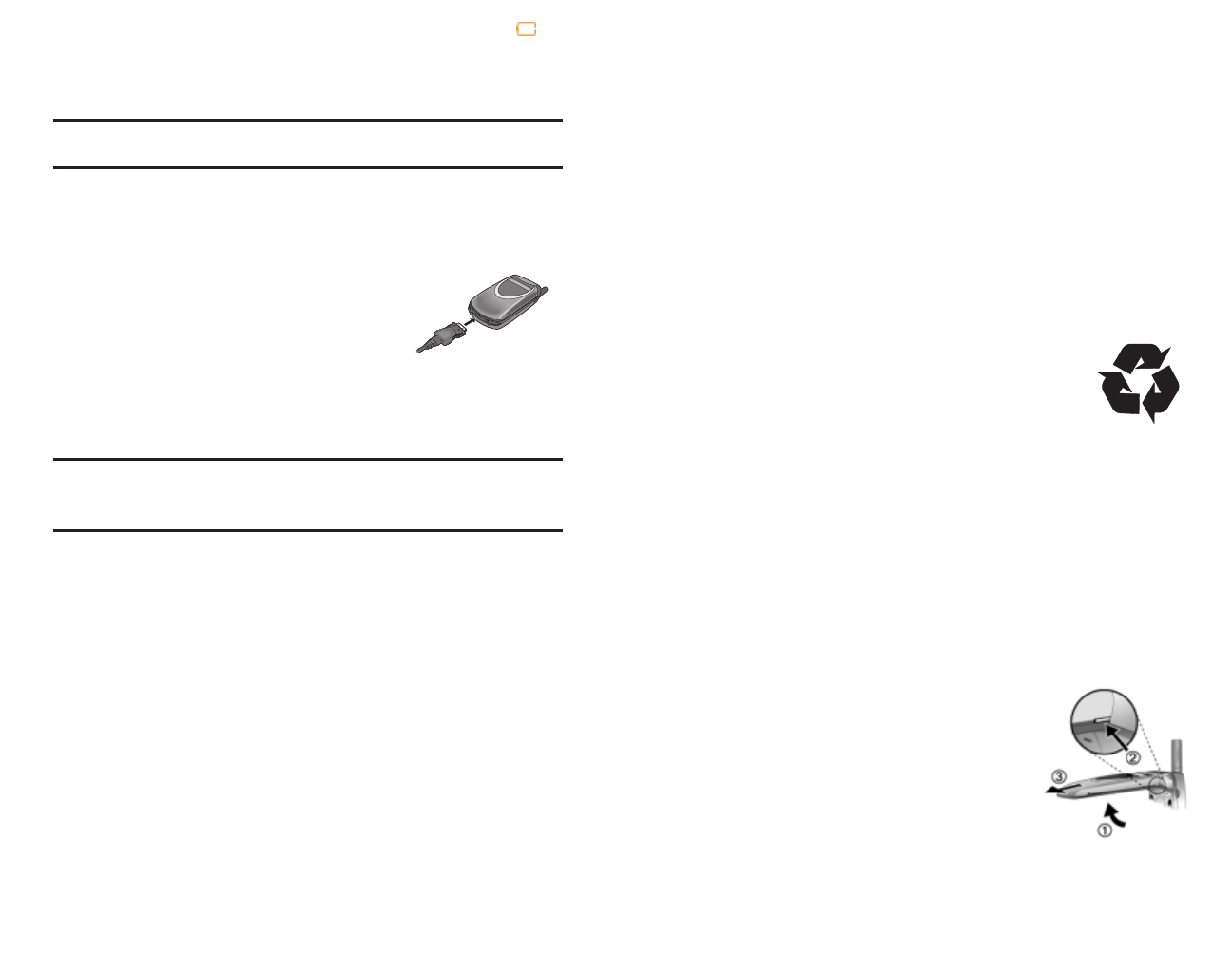
Maintain the battery at or near room temperature when charging.
Do not expose batteries to temperatures below -10°C (14°F) or
above 45°C (113°F).Always take your phone with you when you
leave your vehicle.
When you do not intend to use a battery for a while,store it
uncharged in a cool,dark,dry place,such as a refrigerator.
Over extended periods of time,batteries gradually wear down
and require longer charging times.This is normal.If you charge
your battery regularly and notice a decrease in talk time or an
increase in charging time,then it is probably time to purchase a
new battery.
The more you talk on the phone or use phone features (like
sending text messages),the less standby time your battery has.
You can also extend battery life by turning off the status light.
The rechargeable batteries that power this product
must be disposed of properly and may need to be
recycled.Refer to your battery’s label for battery type.
Contact your local recycling center for proper disposal
methods.Never dispose of batteries in a fire because
they may explode.
Replacing the Convertible Covers
You can replace the flip cover and battery cover on your phone to
personalize its appearance.Matching front and back cover sets are
available in a variety of colors and designs.
Your phone is designed to be used only with Motorola Original
accessories.See your Motorola retailer for new or replacement
covers.
To remove a flip cover:
1. Open your flip phone half way.
2. Press in the tiny silver release button
with your fingernail.This button is on
the side of the top half of the phone.
While pressing the silver button in,
slide the cover off the phone.
Section 2: Understanding Your PCS Phone
2A:Your PCS Phone – The Basics 17
indicator located in the upper-right corner of your phone’s display
screen.If the battery charge is getting too low,the battery icon
blinks and the phone sounds a warning tone.
Always use a Sprint-approved travel charger,or vehicle power
adapter to charge your battery.
Warning! Using the wrong battery charger could cause damage to your
phone and void the warranty.
Using the Travel Charger
To use the travel charger provided with your phone:
1. Plug the travel charger into your phone
with the release tab facing up.
2. Plug the other end of the travel charger
into the appropriate electrical outlet.
3. When your phone indicates that the battery is fully charged
“Charge Complete”,press the release tab and remove the travel
charger.
Note: When you charge the battery, the battery level indicator in the upper
right corner of the display shows how much of the charging process is
complete.
It takes approximately 3 hours to fully recharge a completely
rundown battery.With the Sprint-approved Li-Ion battery,
you can recharge the battery before it becomes completely
run down.
Battery Use
To prevent injuries or burns,do not allow metal objects to contact or
short-circuit the battery terminals.To maximize your battery’s
performance:
Always use Motorola Original™ batteries and battery chargers.
The phone warranty does not cover damage caused from using
non-Motorola batteries and/or battery chargers.
New batteries or batteries that have been stored for long periods
of time may require a longer charge time.
Section 2: Understanding Your PCS Phone
2A:Your PCS Phone – The Basics 16
SPRINT-motorola8/27 2003.8.27 2:16 PM Page 16
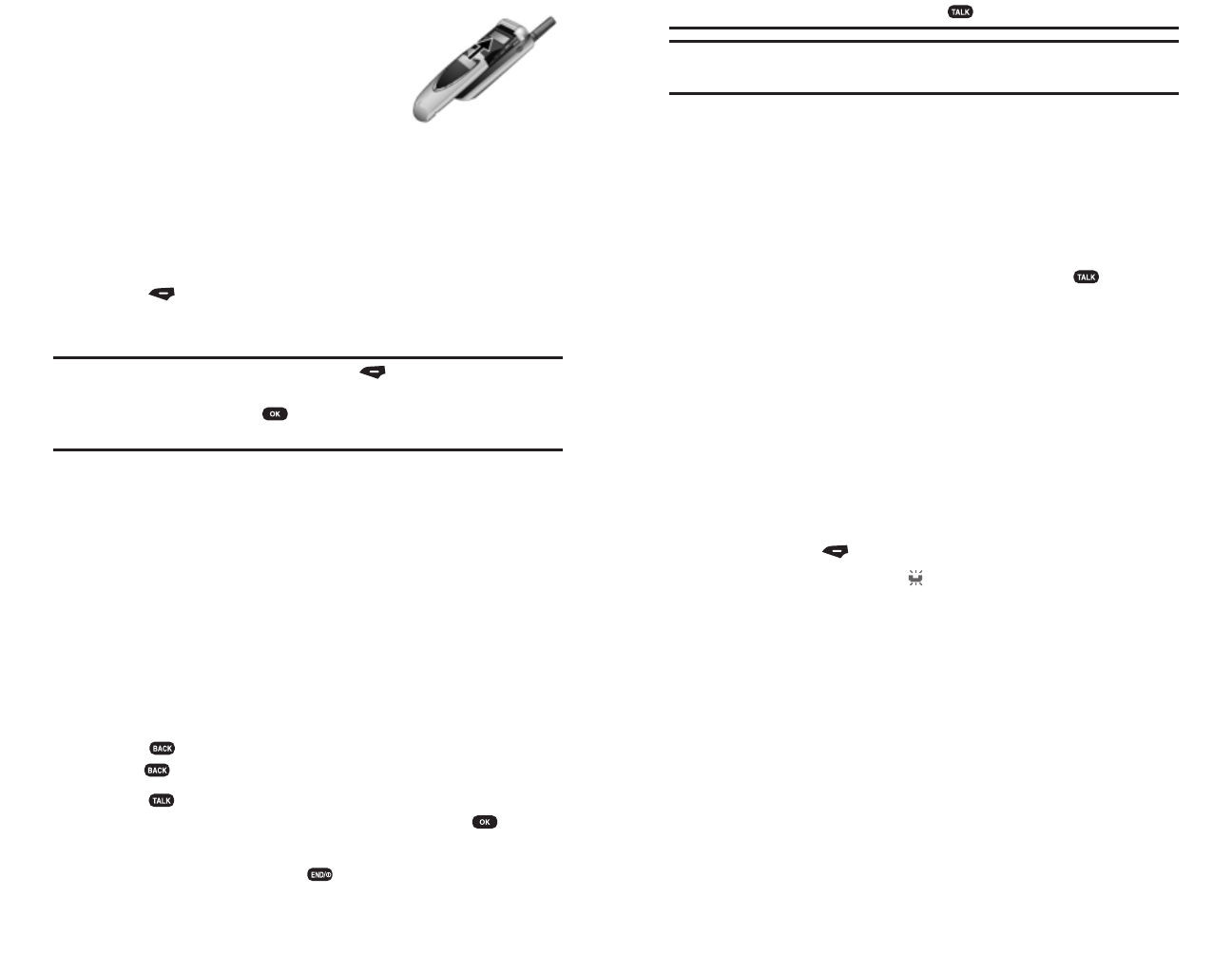
Tip: To redial your last outgoing call, press twice.
Tip: When making calls off the enhanced Sprint Nationwide PCS Network,
always dial using 11 digits (1 + area code + phone number).
Answering Calls
1. To receive a call,your phone must be turned on and have a
network connection with adequate signal strength.If your
phone is locked,you must unlock the phone to answer the call.
When you receive a call,your phone rings and/or vibrates and
displays an incoming call message.
2. When a call comes in,answer the call by pressing .
Depending on your settings,your PCS Phone notifies you of
incoming calls in the following ways:
The phone rings or vibrates.
The LED flashes.
The backlight illuminates.
The screen displays an incoming call message.
If available,the phone number of the caller is displayed.
If the phone number is in your Internal Phone Book,the Phone
Book entry’s name is displayed.
The following options are also displayed.To select an option,press
the corresponding .
Holdyour phone displays a (flashing phone) indicator to
indicate that the call is on hold.
My Tel. Numbers see your phone number.
Received Calls or Dialed Calls view the telephone numbers from
calls you have recently received or dialed.
Messages view or send messages from the message center.
Datebook view your schedule of events stored in the datebook.
Other Information view a list of feature specifications for your
phone.
Answering a Roam Call With Call Guard Enabled
To answer a call when you are roaming and Call Guard is enabled:
Section 2: Understanding Your PCS Phone
2A:Your PCS Phone – The Basics 19
To attach a flip cover:
1. Close your flip phone.
2. Line up the ridges on each side of the
new cover so that they align with the
slots on the phone.
3. Slide the new cover onto the phone until it snaps into place.
Displaying Your Phone Number
Just in case you forget your phone number,your PCS Phone can
remind you.
To display your phone number:
Press (Menu) to access the main menu and select Settings
then Phone Info then My Phone number.Your phone number will
be displayed.
Note: To access the phone’s main menu, press (Menu) softkey button
from standby mode. Menu items may be selected by highlighting them with
the navigation key and pressing , or you can press the number
corresponding to the menu item on your keypad.
Making and Answering Calls
Making Calls
Your PCS Phone offers many different ways to make calls,including
PCS Voice CommandSM (page 121), Speed Dialing(page 81), and using
Call History (page 67).
To call a number,your phone must be turned on,be unlocked,and
have a network connection with adequate signal strength.
To make a call using your keypad:
1. Make sure your phone is on.
2. Enter a phone number.(If you make a mistake while dialing,
press (Delete) to erase one digit at a time.Press and
hold (Delete) to erase the entire number.)
3. Press .(To make a call when you are roaming and
Call Guard is enabled,highlight Roam Calland press .
See “Call Guard”on page 61)
4. When you’re finished,press or close the phone.
Section 2: Understanding Your PCS Phone
2A:Your PCS Phone – The Basics 18
SPRINT-motorola8/27 2003.8.27 2:16 PM Page 18

Note: Because the microphone and earpiece are unavailable when the phone
is closed, you must use a headset or other hands-free device with this
feature.
Smart Key
The smart key gives you another way to perform many basic phone
functions.It’s called the smart key because it anticipates the next
action you are likely to perform.For example,if you highlight an item
and press the smart key,the smart key selects the highlighted item.
You can use the smart key to send and end calls,select menu items,
toggle features on and off,and open your phonebook.The smart key
usually performs the same function as the right soft key ( ).
Note: The smart key provides an optional way to do some things faster. It is
never the only way to perform a task.
Changing the Zoom Setting
You can set your phone’s display to show either three lines or two
lines of text plus soft key labels.Three lines of text display more
information,while two lines increase text size.
Volume Keys
Use the upper and lower volume keys to adjust your phone’s
earpiece and ringer volume,and to mute the incoming call alert.
When you are in a call - increase or decrease earpiece speaker
volume.
The idle display is showing - increase or decrease ringer volume.
Note: You can also use the volume keys to scroll up or down through menus
and lists.
Redialing a Number
You can redial a previously dialed phone number,whether the call
was connected or busy.From the idle display:
1. Press - go directly to the dialed calls list and scroll to the
entry you want to call with navigation key.
2. Press .
Section 2: Understanding Your PCS Phone
2A:Your PCS Phone – The Basics 21
Section 2: Understanding Your PCS Phone
2A:Your PCS Phone – The Basics 20
Select Answerto answer the call.(See “Call Guard”on page 61
for additional information.)
Note: If your phone is off, incoming calls go to voicemail.
Ending a Call
To disconnect a call when you are finished:
Close the phone or press .
External Display (Sub LCD)
When your phone is on and the flip is closed,the external display
shows the time and date.It also displays messages to notify you of
events (like incoming calls) that need your attention.
Set Phone Alert
To change your phone’s alert in the external display:
Press volume keys scroll to “Alert”.
Press smart key select an “Alert Type”.
Press again volume keys return to the “Idle Display”.
Adjust Voice Call Forwarding
To activate or deactivate voice call forwarding in the external display:
Press volume keys scroll to “Forward”.
Press smart key select “All Calls” or “Of f ”.
Press again volume keys return to the “Idle Display”.
Note: You must store a forwarding number to use this feature.
Return an Unanswered Call
When you cannot answer a call,your phone keeps a record of your
unanswered calls and displays the message “X Missed Calls”,where
“X”is the total number of missed calls.When you see the “X Missed
Calls”message in the external display:
Press smart key see the received calls list.
Press volume keys scroll through the list and select a call that you
want to return.
Press again smart key send the call.
SPRINT-motorola8/27 2003.8.27 2:16 PM Page 20

Section 2: Understanding Your PCS Phone
2A:Your PCS Phone – The Basics 23
Using Automatic Redial
If you receive a busy signal,your phone displays the message “Call
Failed”.When automatic redial is turned on,your phone automatically
makes a number of redial attempts until the call goes through.When
the call goes through,your phone rings or vibrates one time,displays
the message “Redial Successful”,and then connects the call.
When automatic redial is turned off,you can manually activate the
feature to redial a phone number.When you hear a busy signal and see
the Call Failed message:
Press or to activate automatic redial.
Caller ID
The calling line identification (caller ID) feature lets you see who is
calling before you answer.
If the caller’s name is stored in your phonebook,the phone
automatically displays the name.Otherwise,the phone displays
the caller’s phone number.
If caller ID information is not available,your phone displays the
message “Incoming Call”.
Returning an Unanswered Call
Your phone keeps a record of your unanswered calls.When you
cannot answer a call,your phone displays indicator and the
message “X Missed Calls”,where “X”is the total number of missed
calls.
1. Press
(View)
- to see the received calls list,with the most
recent call at the top and scroll through the list and select a call
that you want to return with navigation key.
2. Press .
Dialing an Emergency Number
Your service provider programs one or more emergency phone
numbers (such as 911) that you can call under any circumstances.You
can dial and call the emergency number even when your phone is
locked,when you are prompted to enter a code or password,
To call the emergency number at any time:
1. Dial the emergency number (such as 911)
2. Press .
Section 2: Understanding Your PCS Phone
2A:Your PCS Phone – The Basics 22
Note: Emergency numbers vary by country. Your phone’s emergency
number(s) may not work in all locations.
Entering Numbers in the Notepad
Your phone stores the most recent string of digits entered on the
keypad in a temporary memory location called the notepad.These
digits can be the last phone number that you called,or a phone
number that you simply entered but did not call.These digits remain
in the notepad even when you turn off the phone.You can use the
notepad to store a phone number that you intend to call later (such as
a phone number told to you by the other party during a call).
Terminating an Incoming Call
While the phone is ringing or vibrating:
1. Press or
(Ignore)
.
Depending on your phone settings and the type of subscription you
have with your service provider,the call may be forwarded to another
number,or the calling party may hear a busy signal.
Dialing With Speed Dial
The speed dial feature lets you dial any phonebook entry with a
minimal number of keypresses.Whenever you store an entry in your
phonebook,the entry is assigned a unique speed dial number.If you
know the speed dial number for the phonebook entry you want to
call,you can use the speed dial feature.
1. Enter the one-,two-,or three-digit speed dial number for the
entry you want to dial and press .
Dialing With 1-Touch Dial
You can call phonebook entries 1 through 9 with the push of a single
key.Just press and hold the one-digit speed dial number for one
second.
Dialing a Number In a Text Message
If you receive a text message with an embedded phone number,you
can dial the number directly.If the message contains more than one
phone number, to scroll to a number with navigation key and then
press
(Select)
to dial.
1. Press (Menu) to access the main menu.
SPRINT-motorola8/27 2003.8.27 2:16 PM Page 22

Press and release the voice key on the right side of your phone
and say the entry’s name (in two seconds).
Press (Menu)and select “Service Dial” and entry to call.
Press (Menu)and select “Fixed Dial” and entry to call.
Press (Menu)and select “Recent Calls” and select “Received
Calls or Dialed Calls” and entry to call.
Using Features While On a Call
Using Call Waiting
If you subscribe to call waiting,an alert tone sounds while you are on
a call to indicate that you have received a second call.
To put the first call on hold and answer the second call:
1. Press to answer the new call.
2. Press (Switch)to switch back to the first call (you can any
time to switch between calls) or press (Link)to connect the
two calls or press (Menu) and select (End Call On Hold) to end
the call that is on hold.
Making a Conference Call
To talk to more than one person on a call,you can make a conference
call.Call the first person,call the second person,then link the two
calls.
1. Dialing the first person’s number,then press .
2. Press (Hold)or press (Menu) and select (Hold) put the first
call on hold.Your phone displays a (flashing phone)
indicator next to the call on.
3. Dialing the next person’s number,then press .Your phone
displays a (active call) indicator next to the new active call.
4. Press (Link) to connect the two calls.
5. Press end the entire call.
Transferring a Call
While you are on a call,you can transfer the call to another phone by
first talking to the person who answers the other phone,or by
directly transferring the call.
Section 2: Understanding Your PCS Phone
2A:Your PCS Phone – The Basics 25
2. Select Messaging,press (OK) or (Select).
3. Select Inbox,press (OK) or (Select).
4. Scroll to the message with the number.
5. Press (Inbox Menu).
6. Press (Call Back).
7. dial the number in the message.
Additional Dialing Features
In addition to pressing numbers on your keypad,you can insert
numbers or characters and send calls in a variety of ways.
To insert the local international access code:
To change your phone’s alert in the external display:
Press for two seconds insert the international access code for
the country from which you are calling.
While dialing (with digits visible in the display):
To change your phone’s alert in the external display:
Press (Menu) and select “Attach Number” attach a number from
the phonebook or recent call lists to the end of the digits you
entered.
Press (Menu) and select “Hide ID/Show ID” Hide (or show) your
caller ID for the next call.
Press (Menu) and select “Send Message” create a text message
addressed to the number entered.
Press (Menu) and select “Talk Then Fax” talk and then send a fax
to the same phone number within the same call.
Press (Menu) and select “Insert Pause” tells your phone to wait
until the call connects before it automatically sends the next
digit(s) in a series.
Press (Menu) and select “Insert Wait” tells your phone to wait
until the call connects,and then to prompt you for confirmation
before it sends the next digit(s).
Press (Menu) and select “Insert 'n'” tells your phone to prompt
you for a number before dialing the call.The number you enter is
inserted into the dialing sequence in place of the n character.
You can also call numbers using these features:
Section 2: Understanding Your PCS Phone
2A:Your PCS Phone – The Basics 24
SPRINT-motorola8/27 2003.8.27 2:16 PM Page 24

Press (Menu) and select “Other Information” view a list of feature
specifications for your phone.
Saving a Phone Number
A phone number or email address is required for a phonebook entry.
All other information is optional.To save a number from standby
mode:
1. Enter a phone number.
2. Press (Store).
3. Choose “New Entr y” or “Existing Entr y”.press (OK) or
(Select).
4. The Phone # will appear next to a list of icons,press (OK) or
(Select).The name of the icon is displayed above the list.
Use the Navigation key to choose the type of # you’re adding,as
indicated by the icon then use the Navigation key,press
(OK) or (Select).
5. Enter a different speed number.Use the Navigation key (Left or
Right) to choose the speed number then use the Navigation key
(Up or Down) to save.
6. Enter a “voice name”,press (OK).Appears message “press
voice key then say name”then press “Voice Key”.“say name
now”follow the voice prompts to user saying voice name.
7. Press (Done) to move “Entry Form”.
8. Enter a “Name”to display the name editor and enter a name.
To change the input mode,press (Options) and Press
(Browse) search the name from “Phonebook”.Press (OK) or
(OK)to store the name.
9. Use the Navigation key to scroll through more options for the
entry (Ringer ID,Email,Add more phone number).
10. To store the entry,press (Done) “Stored”will be displayed.
Finding a Phone Number
You can search Internal Phone Book entries for phone numbers that
contain a specific string of numbers.
To find a phone number:
1. Press (Menu) to access the main menu.
Section 2: Understanding Your PCS Phone
2A:Your PCS Phone – The Basics 27
Announce the Call Transfer
You can talk to the person who answers the other phone before you
transfer the call,to tell them whom you are transferring.
1. Press (Menu) and select (Hold).
2. Enter the phone number where you are transferring the call
then press .Speak to the person who answers the target
phone.
3. Press (Menu) and select (Transfer)and press (Select).
4. Press (OK).Your phone displays the message “Transfer:
Complete”when the call is transferred.You can hang up the
phone when you see this message.
Do Not Announce the Call Transfer
You can directly transfer a call without talking to the person who
answers.
1. Press (Menu) and select (Transfer) press .
2. Your phone displays the message “Transfer:Complete”when the
call is transferred.You can hang up the phone when you see this
message.
Additional On-Call Features
While you are on a call,you can perform the following tasks:
Press (Hold)or press (Menu) and select (Hold) put a call on
hold.Your phone displays a (flashing phone) indicator to
indicate that the call is on hold.
Press (Menu) and select “My Tel. Numbers” see your phone
number.
Press (Menu) and select “Received Calls or Dialed Calls” view the
telephone numbers from calls you have recently received or
dialed.
Press (Menu) and select “Messages” view or send messages
from the message center.
Press (Menu) and select “Datebook” view your schedule of
events stored in the datebook.
Press (Menu) and select “Messages” view or send messages
from the message center.
Section 2: Understanding Your PCS Phone
2A:Your PCS Phone – The Basics 26
SPRINT-motorola8/27 2003.8.27 2:16 PM Page 26

Dialing From the Internal Phone Book
To dial directly from an Internal Phone Book entry:
1. Press (Menu) to access the main menu.
2. Select Phonebook,press (OK) or (Select).
3. Select Find Name,press (OK) or (Select).
4. Enter the name or part of the name,All matched entries will be
displayed.Use the navigation key to select the entry.
5. Press (OK) or (View).
6. To display the Internal Phone Book entry that contains the
phone number and display details information and press
(Call).
Section 2: Understanding Your PCS Phone
2A:Your PCS Phone – The Basics 29
2. Select Phonebook,press (OK) or (Select).
3. Select Find Name,press (OK) or (Select).
4. Enter the name or part of the name,All matched entries will be
displayed.Use the navigation key to select the entry.
5. Press (OK) or (View).
6. To display the Internal Phone Book entry that contains the
phone number and display details information and press
(Edit).To edit the phone number.
Dialing and Saving Phone Numbers With Pauses
You can dial or save phone numbers with pauses for use with
automated systems,such as voicemail or credit card billing numbers.
If you select a hard pause,the next set of numbers are sent.If you
select a Time Pause,your phone automatically sends the next set of
numbers after setted seconds.
Note:You can have multiple pauses in a phone number and combine
2-second and hard pauses.
To dial or save phone numbers with pauses:
1. Enter the phone number and press (Options).
2. Select either “Hard Pause”or “2Sec.Pause”and
press (Select).Hard Pauses are displayed as a “P”and 2Sec.
Pause as a “T”.
3. Enter additional numbers.
4. Press (Options) then (Select) “Call”to dial the number
or press the (Store) to save the number in your Internal
Phone Book.
Section 2: Understanding Your PCS Phone
2A:Your PCS Phone – The Basics 28
SPRINT-motorola8/27 2003.8.27 2:16 PM Page 28

Section 2B
Controlling Your Phone’s Settings
In This Section
Sounds Settings
Display Settings
Location Settings
Others Settings
Phone Info
This section describes how you can change your phone’s settings to
best suit your needs.Take a few moments to review these options
and add or adjust the settings that are right for you.
Section 2: Understanding Your PCS Phone
2B: Controlling Your Phone’s Settings 31
Section 2: Understanding Your PCS Phone
2A:Your PCS Phone – The Basics 30
SPRINT-motorola8/27 2003.8.27 2:16 PM Page 30
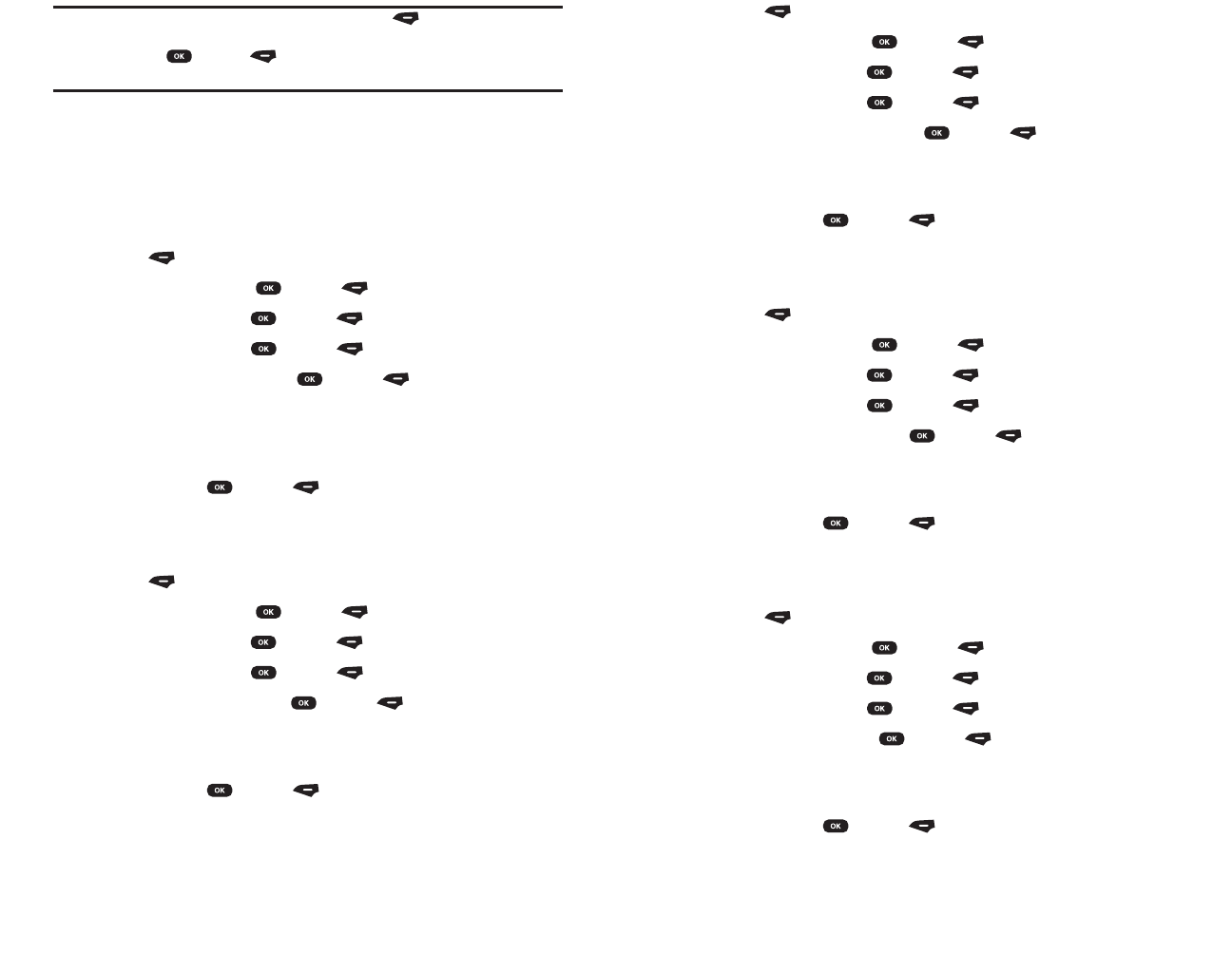
Section 2: Understanding Your PCS Phone
2B: Controlling Your Phone’s Settings 33
Section 2: Understanding Your PCS Phone
2B: Controlling Your Phone’s Settings 32
1. Press (Menu) to access the main menu.
2. Select Settings,press (OK) or (Select).
3. Select Sounds,press (OK) or (Select).
4. Select Volume,press (OK) or (Select).
5. Select Headset Volume,press (OK) or (Select).
6. Adjust the ringer volume with the Navigation key.
Level 0~7
7. To save,press (OK) or (Done).
Alarm Volume
To adjust Alarm volume:
1. Press (Menu) to access the main menu.
2. Select Settings,press (OK) or (Select).
3. Select Sounds,press (OK) or (Select).
4. Select Volume,press (OK) or (Select).
5. Select Alarm Volume,press (OK) or (Select).
6. Adjust the ringer volume with the Navigation key.
Level 0~7
7. To save,press (OK) or (Done).
Key Beep
To adjust keypad tone:
1. Press (Menu) to access the main menu.
2. Select Settings,press (OK) or (Select).
3. Select Sounds,press (OK) or (Select).
4. Select Volume,press (OK) or (Select).
5. Select Key Beep,press (OK) or (Select).
6. Adjust the ringer volume with the Navigation key.
Level 0~7
7. To save,press (OK) or (Done).
Reminder: To access the phone’s main menu, press (Menu) from standby
mode. Menu items may be selected by highlighting them with the navigation
key and pressing (OK) or (Select), or you can press the number
corresponding to the menu item on your keypad.
Sounds Settings
Volume
Ringer Volume
To adjust Ringer volume:
1. Press (Menu) to access the main menu.
2. Select Settings,press (OK) or (Select).
3. Select Sounds,press (OK) or (Select).
4. Select Volume,press (OK) or (Select).
5. Select Ringer Volume,press (OK) or (Select).
6. Adjust the ringer volume with the Navigation key.
Silence All / Ringer Off / Vibrate / Low / Medium / High /
High & Vibrate / Escalating
7. To save,press (OK) or (Select).
Voice Volume
To adjust earpiece volume:
1. Press (Menu) to access the main menu.
2. Select Settings,press (OK) or (Select).
3. Select Sounds,press (OK) or (Select).
4. Select Volume,press (OK) or (Select).
5. Select Voice Volume,press (OK) or (Select).
6. Adjust the ringer volume with the Navigation key.
Level 0~7
7. To save,press (OK) or (Done).
Headset Volume
To adjust headset volume:
SPRINT-motorola8/27 2003.8.27 2:16 PM Page 32

2. Select Settings,press (OK) or (Select).
3. Select Sounds,press (OK) or (Select).
4. Select Ringer Types,press (OK) or (Select).
5. Select Messages,press (OK) or (Select).
6. Select “Voicemail” or “Text” then press (OK) or (Select).
7. Select your desired ringer type and,press (OK) or
(Select) to save it.
Badineri / Big Ben / Blues Riff / Bumblebee / Dance / Falling /
Flying Carpet / Gliss / Invention / Pop / Rag Tag / Rock It / Rock-a-
Billy / Samba / Smooth Music / Trumpet Call / Vibrate / Silent
Selecting Ringer Types for Alarm
1. Press (Menu) to access the main menu.
2. Select Settings,press (OK) or (Select).
3. Select Sounds,press (OK) or (Select).
4. Select Ringer Types,press (OK) or (Select).
5. Select Alarm,press (OK) or (Select).
6. Select your desired ringer type and,press (OK) or
(Select) to save it.
Badineri / Big Ben / Blues Riff / Bumblebee / Dance / Falling /
Flying Carpet / Gliss / Invention / Pop / Rag Tag / Rock It / Rock-a-
Billy / Samba / Smooth Music / Trumpet Call / Vibrate / Silent
Roam Ringer
1. Press (Menu) to access the main menu.
2. Select Settings,press (OK) or (Select).
3. Select Sounds,press (OK) or (Select).
4. Select Ringer Types,press (OK) or (Select).
5. Select Roam Ringer,press (OK) or (Select).
6. Select “Distinctive”or “Normal”with the Navigation key.
Distinctive –Sounds a different ringer type.
Normal –Sounds the same ringer type as used in Home area.
7. To save,press (OK) or (Select).
Section 2: Understanding Your PCS Phone
2B: Controlling Your Phone’s Settings 35
Auto Volume
To adjust auto volume:
1. Press (Menu) to access the main menu.
2. Select Settings,press (OK) or (Select).
3. Select Sounds,press (OK) or (Select).
4. Select Volume,press (OK) or (Select).
5. Select Auto Volume,press (OK) or (Select).
6. Select “On” or “Off ” then press (OK) or (Select) to save it.
RingerTypes
Ringer types help you identify incoming calls and messages.You can
assign ringer types to individual phone book entries,types of calls
and types of messages.
Preprogrammed Ringersinclude a variety of standard ringer types
and familiar music.
Vibrating Ringeralerts you to calls or messages without
disturbing others.
Selecting Ringer Types for Voice Calls
1. Press (Menu) to access the main menu.
2. Select Settings,press (OK) or (Select).
3. Select Sounds,press (OK) or (Select).
4. Select Ringer Types,press (OK) or (Select).
5. Select Voice Calls,press (OK) or (Select).
6. Select “With Caller ID”,“Restricted ID”or “Without Caller ID”
then press (OK).
7. Select your desired ringer type and,press (OK) or
(Select) to save it.
Badineri / Big Ben / Blues Riff / Bumblebee / Dance / Falling /
Flying Carpet / Gliss / Invention / Pop / Rag Tag / Rock It / Rock-a-
Billy / Samba / Smooth Music / Trumpet Call / Vibrate / Silent
Selecting Ringer Types for Messages
1. Press (Menu) to access the main menu.
Section 2: Understanding Your PCS Phone
2B: Controlling Your Phone’s Settings 34
SPRINT-motorola8/27 2003.8.27 2:16 PM Page 34

7. To save,press (OK) or (Select).
Messaging Alerts
1. Press (Menu) to access the main menu.
2. Select Settings,press (OK) or (Select).
3. Select Sounds,press (OK) or (Select).
4. Select Alerts,press (OK) or (Select).
5. Select Messaging,press (OK) or (Select).
6. Select “Once”,“Repeat”or “Off” with the Navigation key.
7. To save,press (OK) or (Select).
Call Lost Alerts
1. Press (Menu) to access the main menu.
2. Select Settings,press (OK) or (Select).
3. Select Sounds,press (OK) or (Select).
4. Select Alerts,press (OK) or (Select).
5. Select Call Lost,press (OK) or (Select).
6. Select “On”or “Off”with the Navigation key.
7. To save,press (OK) or (Select).
Tones
Tone Length
To adjust tone length:
1. Press (Menu) to access the main menu.
2. Select Settings,press (OK) or (Select).
3. Select Sounds,press (OK) or (Select).
4. Select Tones,press (OK) or (Select).
5. Select Tone Length,press (OK) or (Select).
6. Select “Long”or “Short”with the Navigation key.
7. To save,press (OK) or (Select).
Section 2: Understanding Your PCS Phone
2B: Controlling Your Phone’s Settings 37
Alerts
Allows you to set an alert that sounds when any handset changes
occur.
Service Alerts
Sounds an alert when leaving a service area and entering a roaming
service area.
1. Press (Menu) to access the main menu.
2. Select Settings,press (OK) or (Select).
3. Select Sounds,press (OK) or (Select).
4. Select Alerts,press (OK) or (Select).
5. Select Service Alerts,press (OK) or (Select).
6. Select “On”or “Off”with the Navigation key.
7. To save,press (OK) or (Select).
Minute Beep
Sounds an alert every minute of a phone call.
1. Press (Menu) to access the main menu.
2. Select Settings,press (OK) or (Select).
3. Select Sounds,press (OK) or (Select).
4. Select Alerts,press (OK) or (Select).
5. Select Minute Beep,press (OK) or (Select).
6. Select “On”or “Off”with the Navigation key.
7. To save,press (OK) or (Select).
Voicemail Alerts
1. Press (Menu) to access the main menu.
2. Select Settings,press (OK) or (Select).
3. Select Sounds,press (OK) or (Select).
4. Select Alerts,press (OK) or (Select).
5. Select Voicemail,press (OK) or (Select).
6. Select “Once”,“Repeat”or “Off” with the Navigation key.
Section 2: Understanding Your PCS Phone
2B: Controlling Your Phone’s Settings 36
SPRINT-motorola8/27 2003.8.27 2:16 PM Page 36
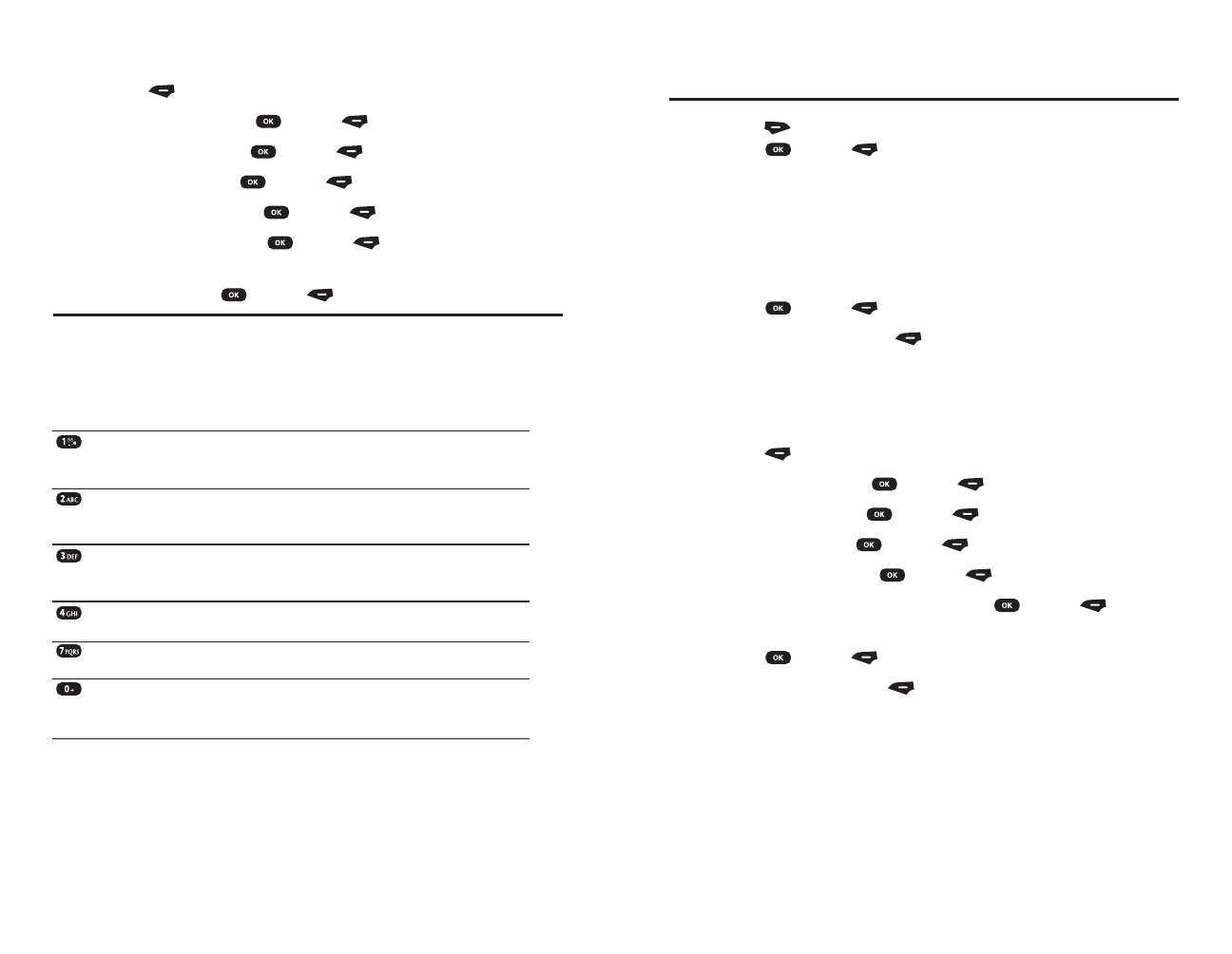
The new length applies to the note and all following notes until you change it
again.
Add a rest : Enter one or more rests (R characters) as needed in the tone
sequence. You can set the length of the rest by entering a q, h, or w character after
the rest, just as you can for a note.
8. Press (Options) to select (Play/Save/Clear/Help) submenu,
press (OK) or (Select).
Play : The phone displays the playback meter and plays the tone.
Save : Store the tone.
Clear : To delete a custom tone that you created.
Help : To display my tone user guide.
9. Select Name,enter the name for the tone and store the name,
press (OK) or (OK).
10. To store the tone,press (Done).
Editing a Tone
You cannot edit the standard alert tones included with your phone.
To edit a custom tone that you created:
1. Press (Menu) to access the main menu.
2. Select Settings,press (OK) or (Select).
3. Select Sounds,press (OK) or (Select).
4. Select Tones,press (OK) or (Select).
5. Select My Tones,press (OK) or (Select).
6. Select the tone you want to edit,press (OK) or (Edit).
7. Select the details you want to edit,enter new Name or Notes,
press (OK) or (OK).
8. To store the tone,press (Done).
Section 2: Understanding Your PCS Phone
2B: Controlling Your Phone’s Settings 39
My Tones
You can create up to 32 custom alert tones for your phone.
The tones you create appear in the list of available alerts.
1. Press (Menu) to access the main menu.
2. Select Settings,press (OK) or (Select).
3. Select Sounds,press (OK) or (Select).
4. Select Tones,press (OK) or (Select).
5. Select My Tones,press (OK) or (Select).
6. Select New Tone,press (OK) or (Select).
7. Select Note,enter notes for the tone by using keypad and store
the notes,press (OK) or (OK).
Entering Notes Method: To create a new tone, use the keypad keys to enter
each note. Press a key multiple times to cycle through its available notes or
options (pitch, octave, or length). The default setting for a new tone is a
quarter note in octave two.
1 set octave one
2 set octave two
3 set octave three
A note A
B note B
C note C
D note D
E note E
F note F
G note G
R rest
# sharp
b flat
q quarter note or quarter rest
h half note or half rest
w whole note or whole rest
Enter a note as follows
Change the octave : Set the new octave (1, 2, or 3) before selecting the note. The
new octave applies to the note and all following notes until you change it again.
Select the note : Press a keypad key to enter a note.
Change a note to a sharp or flat : Enter a sharp or flat (# or b) after selecting the
note. Some sharps and flats are played as standard notes.
Change a note’s length : Set the new length (q, h, or w) after selecting the note.
Section 2: Understanding Your PCS Phone
2B: Controlling Your Phone’s Settings 38
Keys Phone Display Description
SPRINT-motorola8/27 2003.8.27 2:16 PM Page 38

6. Select your desired screensaver and,press (Preview) to
preview select screensaver,press (OK) or (Select) to
save it.
Animation Flower / Animation Alien
Wallpaper
1. Press (Menu) to access the main menu.
2. Select Settings,press (OK) or (Select).
3. Select Display,press (OK) or (Select).
4. Select Standby Display,press (OK) or (Select).
5. Select Wallpaper,press (OK) or (Select).
6. Select your desired wallpaper and,press (Preview) to
preview select wallpaper,press (OK) or (Select) to save
it.
Wallpaper Flower / Wallpaper Alien / Calendar / Clock /
World Clock
Navigation Icon
1. Press (Menu) to access the main menu.
2. Select Settings,press (OK) or (Select).
3. Select Display,press (OK) or (Select).
4. Select Standby Display,press (OK) or (Select).
5. Select Navigation Icon,press (OK) or (Select).
6. Read the message,and press (OK) or (OK).
7. Select “Show”or “Hide”with the Navigation key
8. To save,press (OK) or (Select).
Assign Keys
Navigation Key
1. Press (Menu) to access the main menu.
2. Select Settings,press (OK) or (Select).
3. Select Display,press (OK) or (Select).
4. Select Assign Keys,press (OK) or (Select).
Section 2: Understanding Your PCS Phone
2B: Controlling Your Phone’s Settings 41
Section 2: Understanding Your PCS Phone
2B: Controlling Your Phone’s Settings 40
Display Settings
Menu Display
Allows you to customize display.
Menu Theme
1. Press (Menu) to access the main menu.
2. Select Settings,press (OK) or (Select).
3. Select Display,press (OK) or (Select).
4. Select Menu Display,press (OK) or (Select).
5. Select Menu Theme,press (OK) or (Select).
6. Select your desired menu theme and,press (OK) or
(Select) to save it.
Pacific / Mandarin / Evergreen / Autumn / Dusk / Silver
Menu Style
1. Press (Menu) to access the main menu.
2. Select Settings,press (OK) or (Select).
3. Select Display,press (OK) or (Select).
4. Select Menu Display,press (OK) or (Select).
5. Select Menu Style,press (OK) or (Select).
6. Select your desired menu style and,press (OK) or
(Select) to save it.
Desktop / List View
Standby Display
Screensaver
1. Press (Menu) to access the main menu.
2. Select Settings,press (OK) or (Select).
3. Select Display,press (OK) or (Select).
4. Select Standby Display,press (OK) or (Select).
5. Select Screensaver,press (OK) or (Select).
Section 2: Understanding Your PCS Phone
2B: Controlling Your Phone’s Settings 40
SPRINT-motorola8/27 2003.8.27 2:16 PM Page 40

Section 2: Understanding Your PCS Phone
2B: Controlling Your Phone’s Settings 43
Section 2: Understanding Your PCS Phone
2B: Controlling Your Phone’s Settings 42
Backlight Control
The backlight setting lets you select how long the display screen and
keypad are backlight after any key press is made.
1. Press (Menu) to access the main menu.
2. Select Settings,press (OK) or (Select).
3. Select Display,press (OK) or (Select).
4. Select Backlight Control,press (OK) or (Select).
5. Select “Display”or “Keypad”with the Navigation key
6. Select one of the following options and,press (OK) or
(Select) to save it.
Continuous / Always off / 8 seconds / 15 seconds
Greetings
The text greeting can be up to 15 characters and is displayed on your
phone’s screen in standby mode.You may choose to display a custom
greeting or you may display your PCS User Name on the phone’s
screen (the default setting).
To display or change your custom greeting:
1. Press (Menu) to access the main menu.
2. Select Settings,press (OK) or (Select).
3. Select Display,press (OK) or (Select).
4. Select Greetings,press (OK) or (Select).
5. Input user name or customize greeting,using the Alpha Editor,
press (Options) to change the input mode.
6. Press (OK) or (OK) to save it.
Contrast
To adjust the display’s contrast:
1. Press (Menu) to access the main menu.
2. Select Settings,press (OK) or (Select).
3. Select Display,press (OK) or (Select).
4. Select Contrast,press (OK) or (Select).
5. Select Navigation Keys,press (OK) or (Select).
6. Select “Up”,“Down”,“Left”or “Right”with the Navigation key
7. Select your desired new function to relabel and,press (OK)
or (Select) to save it.
Recent Calls / Phonebook / Messaging / Voicemail / Datebook /
Games / Alarm Clock / Calculator / World Time / Stopwatch/Timer
/ Voice Memo / Settings
Smart Key
1. Press (Menu) to access the main menu.
2. Select Settings,press (OK) or (Select).
3. Select Display,press (OK) or (Select).
4. Select Assign Keys,press (OK) or (Select).
5. Select Smart Key,press (OK) or (Select).
6. Select your desired new function to relabel and,press (OK)
or (Select) to save it.
Recent Calls / Phonebook / Messaging / Voicemail / Datebook /
Games / Alarm Clock / Calculator / World Time / Stopwatch/Timer
/ Voice Memo / Settings / Main Menu
Softkeys
1. Press (Menu) to access the main menu.
2. Select Settings,press (OK) or (Select).
3. Select Display,press (OK) or (Select).
4. Select Assign Keys,press (OK) or (Select).
5. Select Softkeys,press (OK) or (Select).
6. Select “Left”or “Right”with the Navigation key
7. Select your desired new function to relabel and,press (OK)
or (Select) to save it.
Recent Calls / Phonebook / Messaging / Voicemail / Datebook /
Games / Alarm Clock / Calculator / World Time / Stopwatch/Timer
/ Voice Memo / Settings / Main Menu
SPRINT-motorola8/27 2003.8.27 2:16 PM Page 42
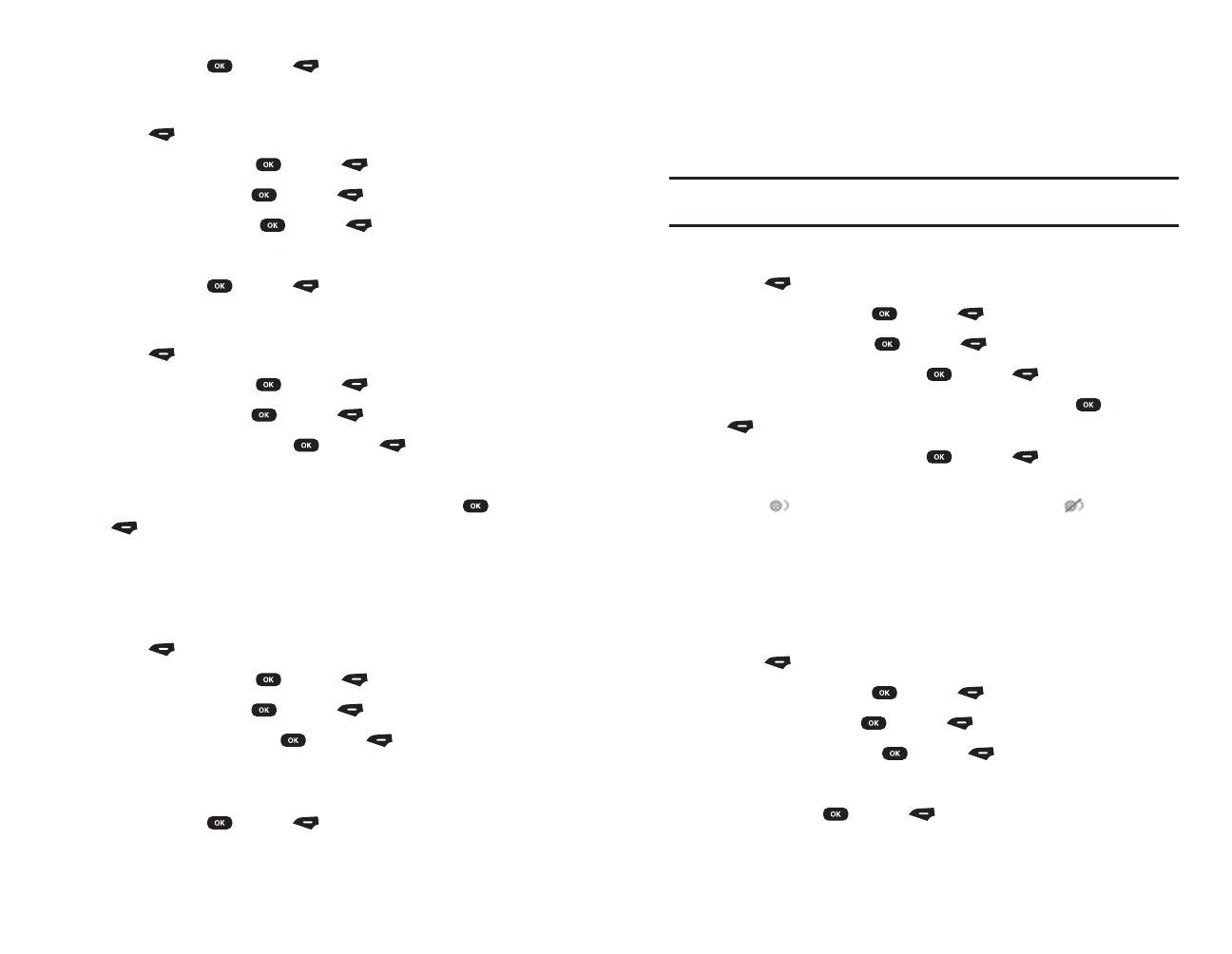
Location Settings
Your PCS Phone is equipped with a Location feature for use in
connection with location-based services that may be available
in the future.
The Location feature allows the network to detect your position.
Turning Location off will hide your location from everyone
except 911.
Note: Even if the Location feature is enabled, no service may use your
location without your expressed permission.
To enable your phone’s Location feature:
1. Press (Menu) to access the main menu.
2. Select Settings,press (OK) or (Select).
3. Select Location,press (OK) or (Select).
4. Read the message,and press (OK) or (OK).
5. Select “On”or “Off”with the Navigation key,press (OK) or
(Select).
6. Read the message,and press (OK) or (OK) to save it.
When the Location feature is on,you phone’s standby screen will
display the icon.When Location is turned off,the icon will
display.
Others Settings
Language
To assign a language for the phone’s display:
1. Press (Menu) to access the main menu.
2. Select Settings,press (OK) or (Select).
3. Select Others,press (OK) or (Select).
4. Select Language,press (OK) or (Select).
5. Select “English”or “Español”with the Navigation key.
6. To save,press (OK) or (Select).
Section 2: Understanding Your PCS Phone
2B: Controlling Your Phone’s Settings 45
5. Adjust the ringer volume with the Navigation key.
Level 0~6
6. To save,press (OK) or (Done).
Font Size
1. Press (Menu) to access the main menu.
2. Select Settings,press (OK) or (Select).
3. Select Display,press (OK) or (Select).
4. Select Font Size,press (OK) or (Select).
5. Select “Zoom In”or “Zoom Out”with the Navigation key.
6. To save,press (OK) or (Select).
Time and Date
1. Press (Menu) to access the main menu.
2. Select Settings,press (OK) or (Select).
3. Select Display,press (OK) or (Select).
4. Select Time and Date,press (OK) or (Select).
5. Select “Time Format”or “Date Format”with the Navigation key.
6. Select your desired time and date mode and,press (OK) or
(Select) to save it.
Time Format : 12 hrs AM/PM / 24 hrs
Date Format : MM/DD/YY / DD/MM/YY
Sleep Mode
1. Press (Menu) to access the main menu.
2. Select Settings,press (OK) or (Select).
3. Select Display,press (OK) or (Select).
4. Select Sleep Mode,press (OK) or (Select).
5. Select “After 5 sec.”,“After 30 sec.”,“After 60 sec.”or “Off”
with the Navigation key.
6. To save,press (OK) or (Select).
Section 2: Understanding Your PCS Phone
2B: Controlling Your Phone’s Settings 44
SPRINT-motorola8/27 2003.8.27 2:16 PM Page 44
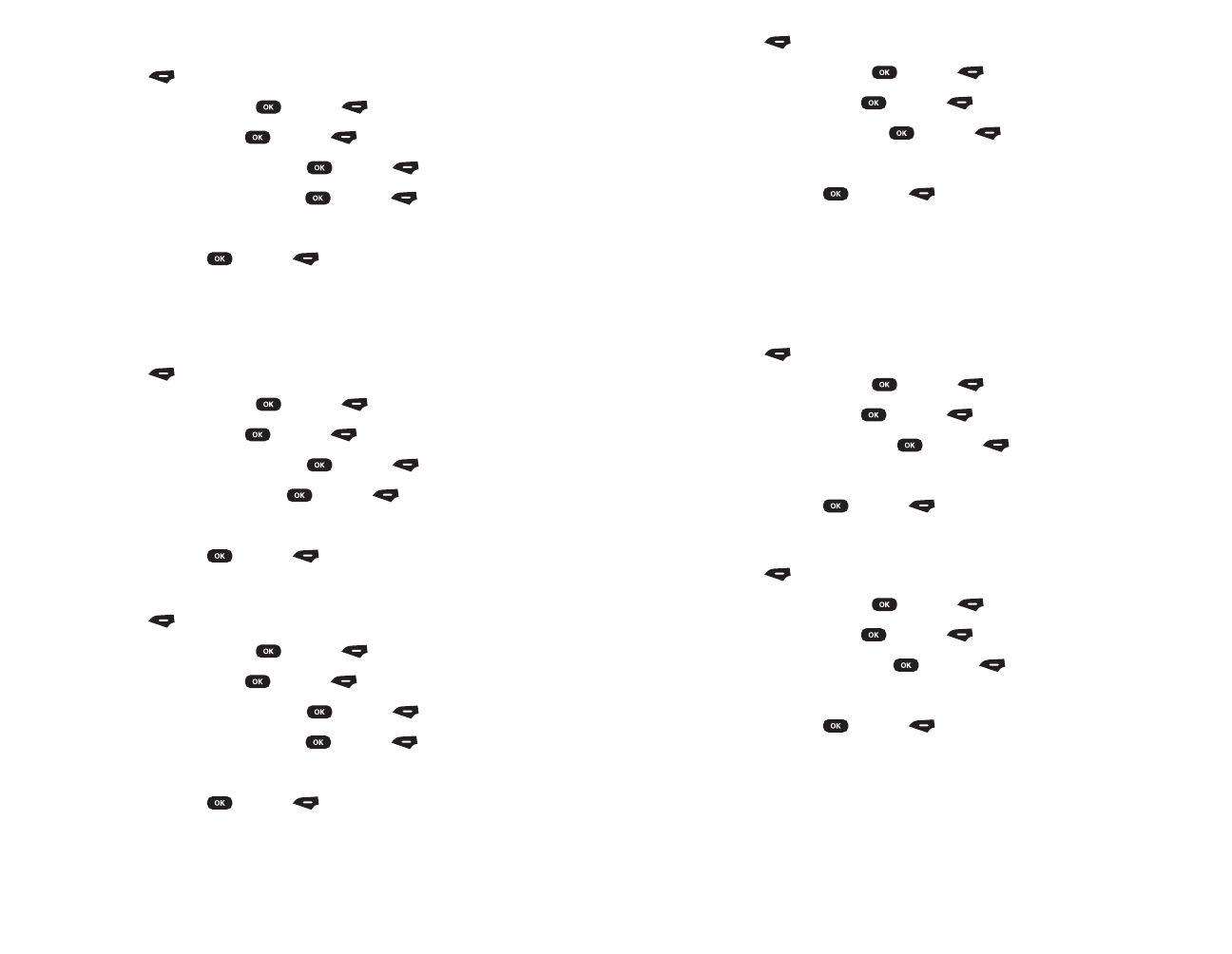
Speed Dial
1. Press (Menu) to access the main menu.
2. Select Settings,press (OK) or (Select).
3. Select Others,press (OK) or (Select).
4. Select Speed Dial,press (OK) or (Select).
5. Select “On”or “Off”with the Navigation key.
6. To save,press (OK) or (Select).
Abbrev. Dial
Abbreviated Dialing is another form of speed dialing.If the last four
digits you enter do not match any stored phone book entry,the digits
are automatically prepended with the digits specified using the
following steps.
1. Press (Menu) to access the main menu.
2. Select Settings,press (OK) or (Select).
3. Select Others,press (OK) or (Select).
4. Select Abbrev. Dial,press (OK) or (Select).
5. Select “On”or “Off”with the Navigation key.
6. To save,press (OK) or (Select).
Auto Redial
1. Press (Menu) to access the main menu.
2. Select Settings,press (OK) or (Select).
3. Select Others,press (OK) or (Select).
4. Select Auto Redial,press (OK) or (Select).
5. Select “On”or “Off”with the Navigation key.
6. To save,press (OK) or (Select).
Airplane Mode
When your phone is in Airplane Mode,it cannot send or receive any
calls or access online information.You may still use the phone’s other
features,such as Games,Notepad,Voice Memos,etc.,while you are in
Airplane Mode.
Section 2: Understanding Your PCS Phone
2B: Controlling Your Phone’s Settings 47
Section 2: Understanding Your PCS Phone
2B: Controlling Your Phone’s Settings 46
Answer Options
Anykey Answer
1. Press (Menu) to access the main menu.
2. Select Settings,press (OK) or (Select).
3. Select Others,press (OK) or (Select).
4. Select Answer Options,press (OK) or (Select).
5. Select Anykey Answer,press (OK) or (Select).
6. Select “On”or “Off”with the Navigation key.
7. To save,press (OK) or (Select).
Auto Answer
Automatically answers a call after a preset number of rings.
An ideal setting for the hands-free car kit.
1. Press (Menu) to access the main menu.
2. Select Settings,press (OK) or (Select).
3. Select Others,press (OK) or (Select).
4. Select Answer Options,press (OK) or (Select).
5. Select Auto Answer,press (OK) or (Select).
6. Select “On”or “Off”with the Navigation key.
7. To save,press (OK) or (Select).
Open to Answer
1. Press (Menu) to access the main menu.
2. Select Settings,press (OK) or (Select).
3. Select Others,press (OK) or (Select).
4. Select Answer Options,press (OK) or (Select).
5. Select Open to Answer,press (OK) or (Select).
6. Select “On”or “Off”with the Navigation key.
7. To save,press (OK) or (Select).
SPRINT-motorola8/27 2003.8.27 2:16 PM Page 46
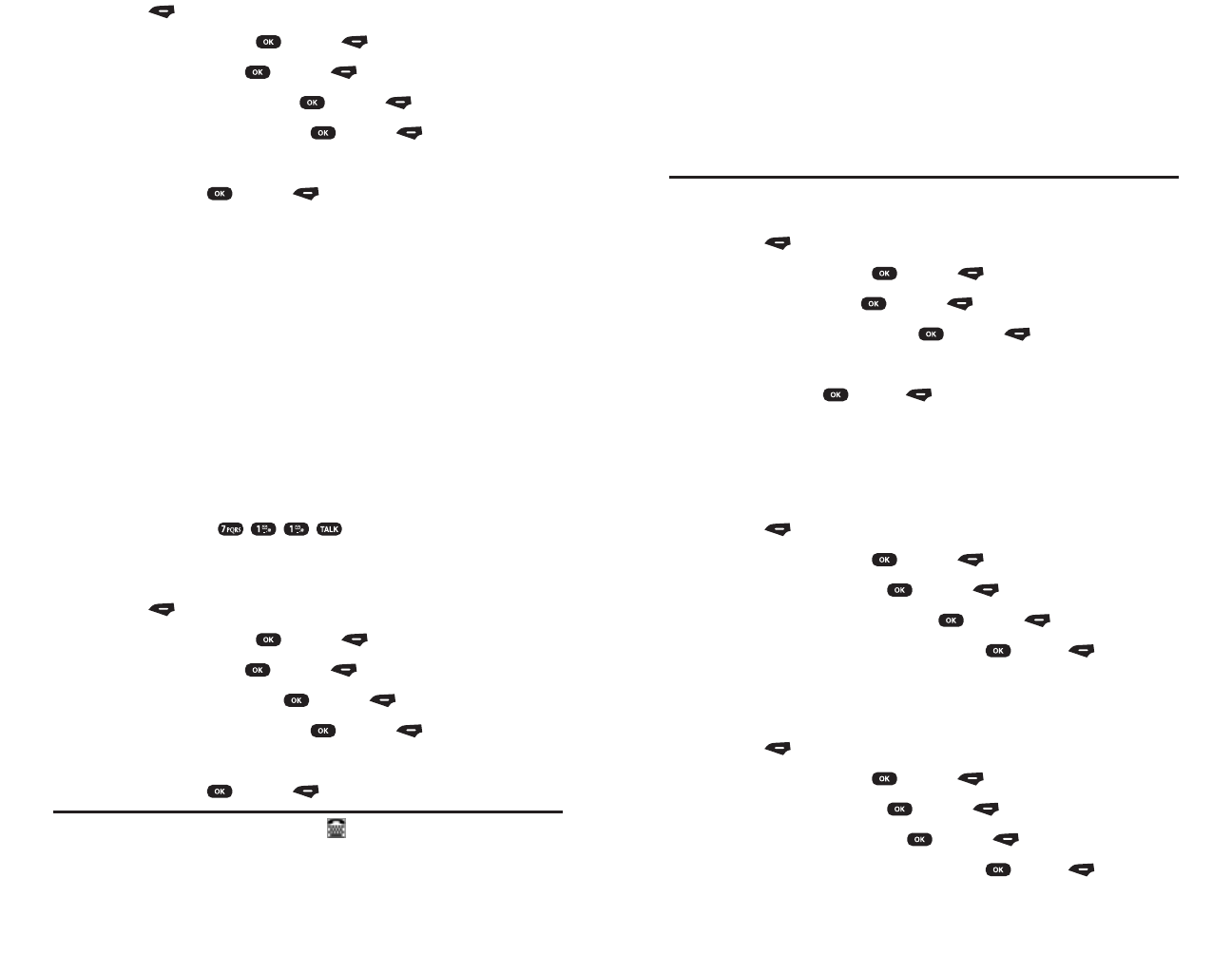
IMPORTANT NOTICE: 911 Emergency Calling
Sprint recommends that TTY users make emergency calls by other means
including Telecommunications Relay Services (TRS), analog cellular, and
landline communications. Wireless TTY calls to 911 may be corrupted when
received by public safety answering points (PSAPs) rendering some
communications unintelligible. The problem encountered appears related to
TTY equipment or software used by PSAPs. This matter has been brought to
the attention of the FCC, and the wireless industry and PSAP community are
currently working to resolve this.
Phonebook Match
1. Press (Menu) to access the main menu.
2. Select Settings,press (OK) or (Select).
3. Select Others,press (OK) or (Select).
4. Select Ph.Book Match,press (OK) or (Select).
5. Select “On”or “Off”with the Navigation key.
6. To save,press (OK) or (Select).
Phone Info
My Phone Number
Displays the Phone Number and MS ID of your phone.
1. Press (Menu) to access the main menu.
2. Select Settings,press (OK) or (Select).
3. Select Phone Info,press (OK) or (Select).
4. Select My Phone Number,press (OK) or (Select).
5. To return to the previous page,press (OK) or (OK).
Icon Glossary
Shows list identifies the symbols you’ll see on your display screen.
1. Press (Menu) to access the main menu.
2. Select Settings,press (OK) or (Select).
3. Select Phone Info,press (OK) or (Select).
4. Select Icon Glossary,press (OK) or (Select).
5. To return to the previous page,press (OK) or (OK).
Section 2: Understanding Your PCS Phone
2B: Controlling Your Phone’s Settings 49
1. Press (Menu) to access the main menu.
2. Select Settings,press (OK) or (Select).
3. Select Others,press (OK) or (Select).
4. Select Airplane Mode,press (OK) or (Select).
5. Read the message,and press (OK) or (OK).
6. Select “On”or “Off”with the Navigation key.
7. To save,press (OK) or (Select).
TTY Settings
A TTY (also known as a TDD or Text Telephone),is a
telecommunications device that allows people who are deaf or hard
of hearing,or who have speech or language disabilities,to
communicate via a telephone.
Your phone is compatible with select TTY devices.Please check with
the manufacturer of your TTY device to ensure that it supports digital
wireless transmission.Your phone and TTY device will connect via a
special cable that plugs into your phone's headset jack.If this cable
was not provided with your TTY device,contact your TTY device
manufacturer to purchase the connector cable.
When establishing your PCS Service,please call PCS Customer
Service SolutionsSM via the state Telecommunications Relay Service
(TRS) by first dialing .Then provide the state TRS
with this number:866-727-4889.
To turn TTY Mode on or off:
1. Press (Menu) to access the main menu.
2. Select Settings,press (OK) or (Select).
3. Select Others,press (OK) or (Select).
4. Select TTY Settings,press (OK) or (Select).
5. Read the message,and press (OK) or (OK).
6. Select “Enable TTY”or “Disable TTY”with the Navigation key.
7. To save,press (OK) or (Save).
Note:In TTY Mode, your phone will display . If TTY mode is enabled, the audio
quality of non-TTY devices connected to the headset jack may be impaired.
Section 2: Understanding Your PCS Phone
2B: Controlling Your Phone’s Settings 48
SPRINT-motorola8/27 2003.8.27 2:16 PM Page 48

Section 2C
Setting Your Phone’s Security
In This Section
Setting Your Phone’s Security
By adjusting the security settings on your PCS Phone,you receive
peace of mind without sacrificing flexibility.With several options
available,you can customize your phone to meet your personal needs.
Section 2: Understanding Your PCS Phone
2C: Setting Your Phone’s Security 51
Version
Displays the various Software Version of your phone.
1. Press (Menu) to access the main menu.
2. Select Settings,press (OK) or (Select).
3. Select Phone Info,press (OK) or (Select).
4. Select Version,press (OK) or (Select).
5. To return to the previous page,press (OK) or (OK).
Section 2: Understanding Your PCS Phone
2B: Controlling Your Phone’s Settings 50
SPRINT-motorola8/27 2003.8.27 2:16 PM Page 50
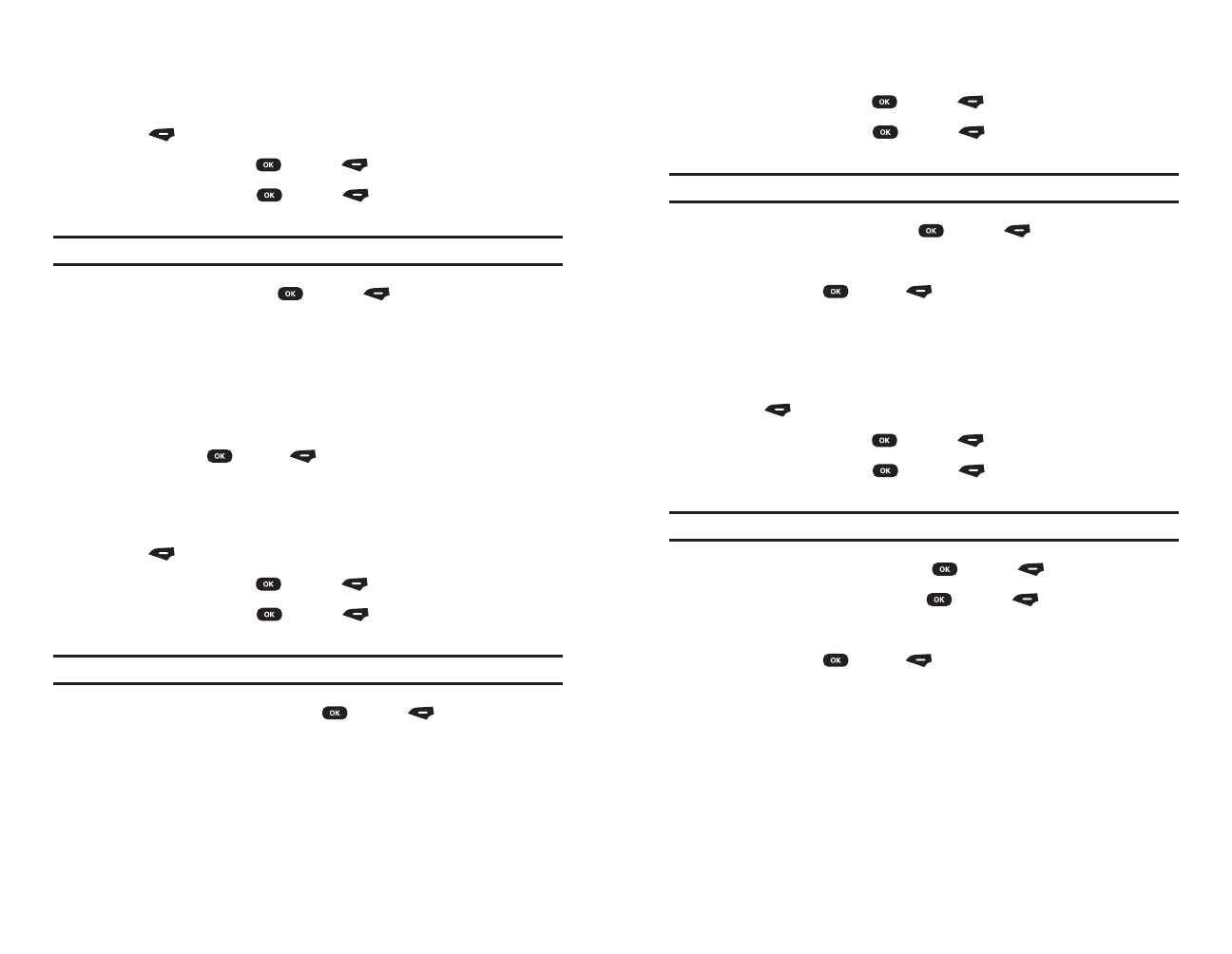
Phonebook Lock
Prevents others from using phonebook without permission.
1. Press (Menu) to access the main menu.
2. Select Settings,press (OK) or (Select).
3. Select Security,press (OK) or (Select) and enter
“Password”.
Note: The default password is “1234”.
4. Select Phonbook Lock,press (OK) or (Select).
5. Select “On”or “Off”with the Navigation key.
6. To save,press (OK) or (Select).
Erase Phonebook
To erase all the names and phone numbers in your Internal Phone
Book:
1. Press (Menu) to access the main menu.
2. Select Settings,press (OK) or (Select).
3. Select Security,press (OK) or (Select) and enter
“Password”.
Note: The default password is “1234”.
4. Select Erase Phonebook,press (OK) or (Select).
5. Read the message,and press (OK) or (OK).
6. Select “Yes”or “No”with the Navigation key.
7. To save,press (OK) or (Yes).
Restrict Calls
Enables you to restrict certain features with the pass-word.You are to
unlock it to use the features.
Outgoing Calls
Blocks all outgoing calls except emergency calls from being placed,
but allows incoming calls to be answered.
Section 2: Understanding Your PCS Phone
2C: Setting Your Phone’s Security 53
Setting Your Phone’s Security
Lock Phone
When your phone is locked,you can only receive incoming calls or
make calls to 911,PCS Customer Solutions,or special numbers.
1. Press (Menu) to access the main menu.
2. Select Settings,press (OK) or (Select).
3. Select Security,press (OK) or (Select) and enter
“Password”.
Note: The default password is “1234”.
4. Select Lock Phone,press (OK) or (Select).
5. Select “Unlock”,“Lock Now”or “Lock On Power Up”with the
Navigation key.
Unlock – Do not lock the phone.
Lock Now – Lock the phone now.
Lock On Power - Up – Lock the phone whenever it is turned on.
6. To save,press (OK) or (Select).
Change Lock Code
To change your lock code:
1. Press (Menu) to access the main menu.
2. Select Settings,press (OK) or (Select).
3. Select Security,press (OK) or (Select) and enter
“Password”.
Note: The default password is “1234”.
4. Select Change Lock Code,press (OK) or (Select).
5. Enter a new lock code.
6. Re-enter a new lock code.
Section 2: Understanding Your PCS Phone
2C: Setting Your Phone’s Security 52
SPRINT-motorola8/27 2003.8.27 2:16 PM Page 52
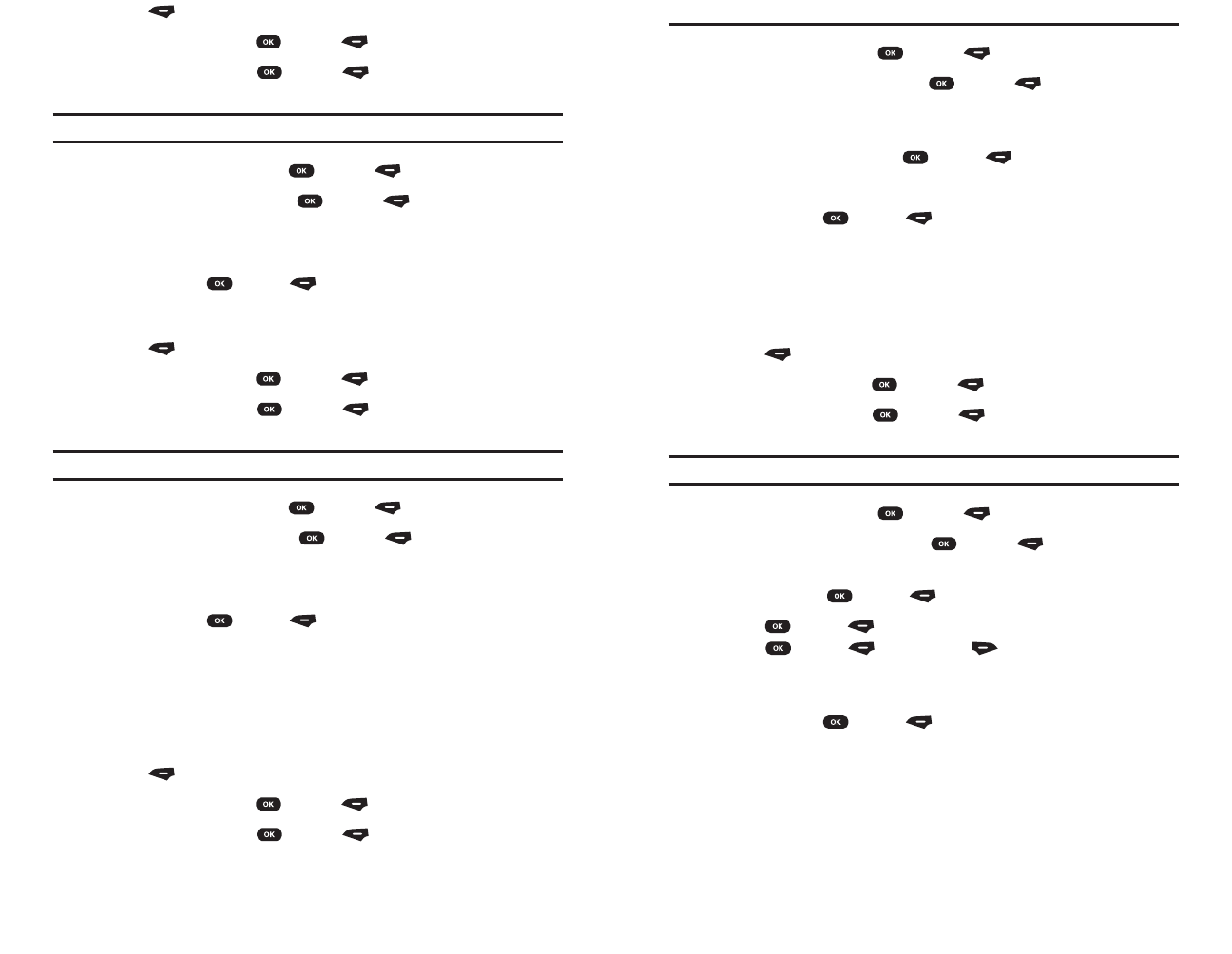
Section 2: Understanding Your PCS Phone
2C: Setting Your Phone’s Security 55
Section 2: Understanding Your PCS Phone
2C: Setting Your Phone’s Security 54
Note: The default password is “1234”.
4. Select Limit Use,press (OK) or (Select).
5. Select Lock Application,press (OK) or (Select).
6. Select one of the following options (Call
History/Phonebook/Messaging/Datebook/Alarm Clock) with
the Navigation key,press (OK) or (Select).
7. Select “Unlocked”or “Locked”with the Navigation key.
8. To save,press (OK) or (Select).
Special Numbers
You can save three special numbers in addition to your Internal
Phone Book entries.You can make and receive calls from special
numbers even when your phone is locked.
1. Press (Menu) to access the main menu.
2. Select Settings,press (OK) or (Select).
3. Select Security,press (OK) or (Select) and enter
“Password”.
Note: The default password is “1234”.
4. Select Limit Use,press (OK) or (Select).
5. Select Special Numbers,press (OK) or (Select).
6. Select the entry number where you would like to store the
number,press (OK) or (Select).
7. Press (OK) or (Edit),then enter the phone number and
press (OK) or (OK) or Press (Browse) select
“Phonebook”,“Outgoing Calls”,“Incoming Calls”or “Missed
Calls”with the Navigation key and search the phone number.
8. To save,press (OK) or (OK).
1. Press (Menu) to access the main menu.
2. Select Settings,press (OK) or (Select).
3. Select Security,press (OK) or (Select) and enter
“Password”.
Note: The default password is “1234”.
4. Select Restrict Calls,press (OK) or (Select).
5. Select Outgoing Calls,press (OK) or (Select).
6. Select “None”,“All”or “Phonebook only”with the Navigation
key.
7. To save,press (OK) or (Select).
Incoming Calls
1. Press (Menu) to access the main menu.
2. Select Settings,press (OK) or (Select).
3. Select Security,press (OK) or (Select) and enter
“Password”.
Note: The default password is “1234”.
4. Select Restrict Calls,press (OK) or (Select).
5. Select Incoming Calls,press (OK) or (Select).
6. Select “None”,“All”or “Phonebook only”with the Navigation
key.
7. To save,press (OK) or (Select).
Limit Use
Prevents using “Application”or “Special Numbers” without
permission.
Lock Application
1. Press (Menu) to access the main menu.
2. Select Settings,press (OK) or (Select).
3. Select Security,press (OK) or (Select) and enter
“Password”.
SPRINT-motorola8/27 2003.8.27 2:16 PM Page 54
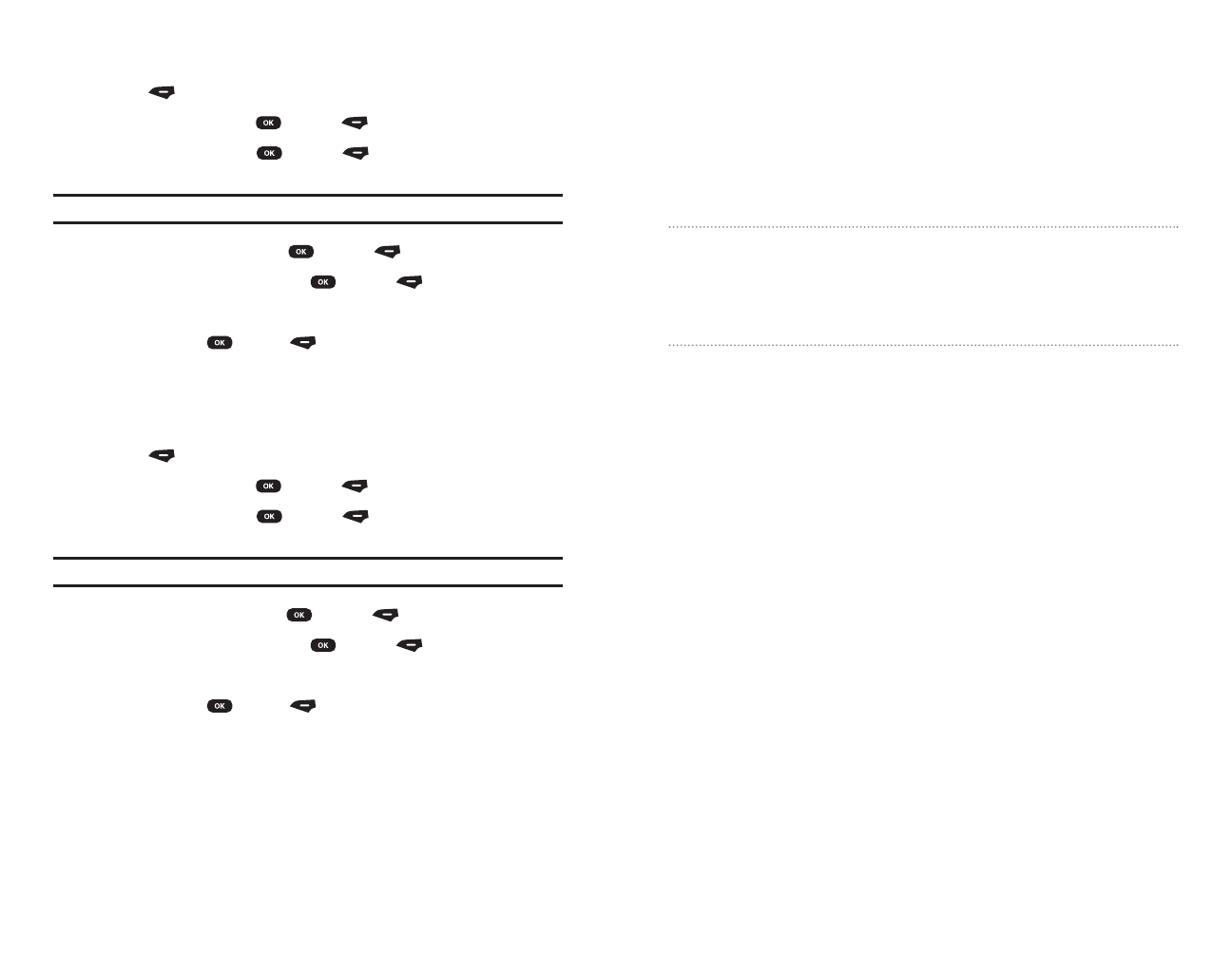
Section 2D
Controlling Your Roaming
Experience
In This Section
Understanding Roaming
Setting Your Phone’s Roam Mode
Controlling Roaming Charges Using Call Guard
Roaming is the ability to make or receive calls when you’re off the
enhanced Sprint Nationwide PCS Network.Your new PCS Phone
works anywhere on the enhanced Sprint Nationwide PCS Network and
allows you to roam virtually anywhere in the U.S.where compatible
wireless service is available.
This section explains how roaming works as well as special features that
let you manage your roaming experience.
Section 2: Understanding Your PCS Phone
2D: Controlling Your Roaming Experience 57
Master Reset
Use this feature to reset all user-selectable options back to their
original factory settings.
1. Press (Menu) to access the main menu.
2. Select Settings,press (OK) or (Select).
3. Select Security,press (OK) or (Select) and enter
“Password”.
Note: The default password is “1234”.
4. Select Master Reset,press (OK) or (Select).
5. Read the message,and press (OK) or (OK).
6. Select “Yes”or “No”with the Navigation key.
7. To save,press (OK) or (Yes).
Master Clear
Use Master Clear to clear all user-selectable options,the resettable
timer,the Phone Book and the Messaging memory.
1. Press (Menu) to access the main menu.
2. Select Settings,press (OK) or (Select).
3. Select Security,press (OK) or (Select) and enter
“Password”.
Note: The default password is “1234”.
4. Select Master Clear,press (OK) or (Select).
5. Read the message,and press (OK) or (OK).
6. Select “Yes”or “No”with the Navigation key.
7. To save,press (OK) or (Yes).
Section 2: Understanding Your PCS Phone
2C: Setting Your Phone’s Security 56
SPRINT-motorola8/27 2003.8.27 2:16 PM Page 56
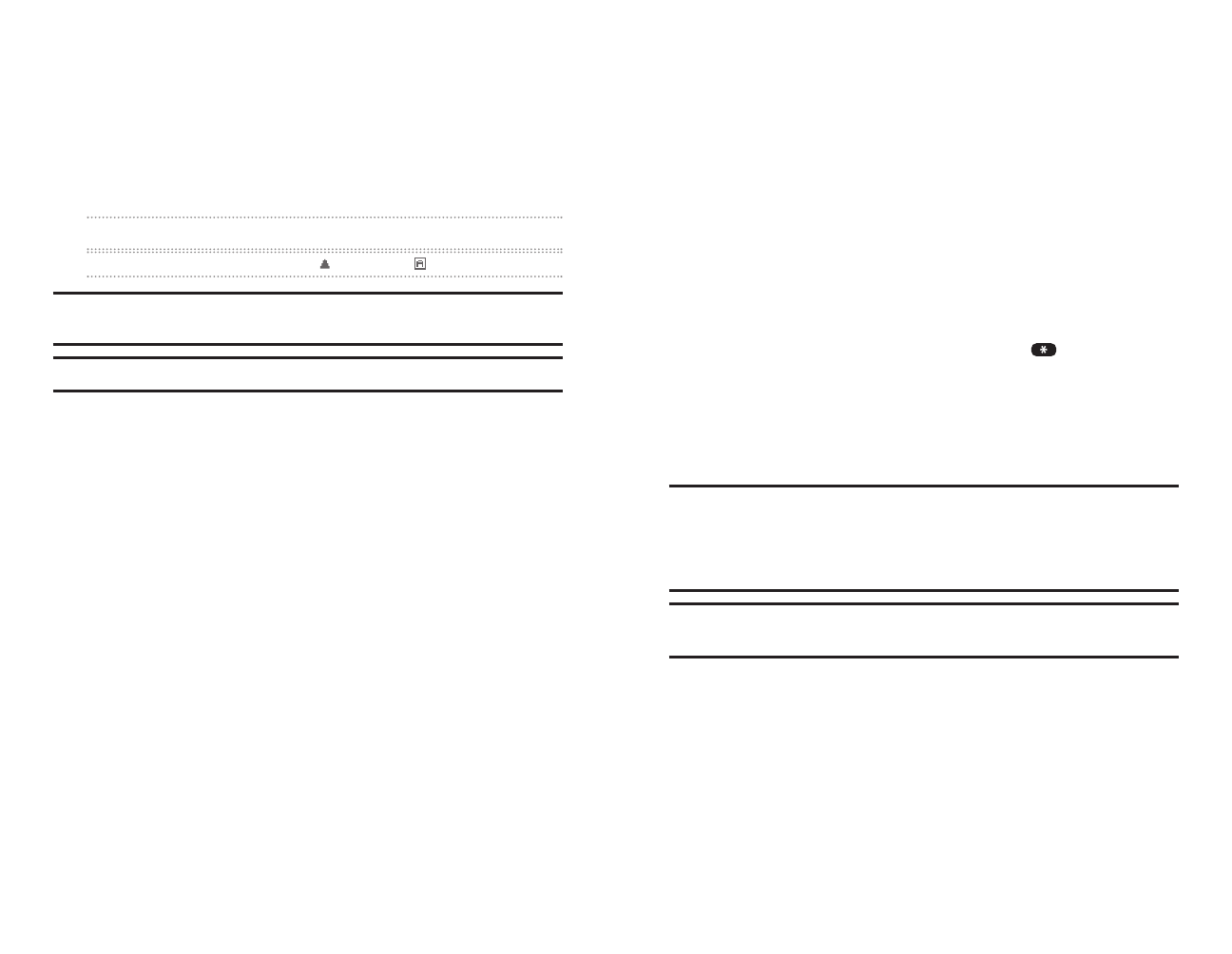
Roaming on Analog Networks
When you roam on analog networks,you will experience a similar
quality provided by other analog carriers today.Although some
features,such as PCS Vision and PCS Voice Command,will be
unavailable,you can still make and receive calls and access voicemail.
You will experience a few differences:
You are more likely to experience static,cross-talk,fade-out,and
dropped calls.
Some features which are standard on the enhanced
Sprint Nationwide PCS Network,such as call waiting,
PCS Vision,and direct international dialing,are unavailable.
Though callers can leave voicemail messages while you are
roaming,you will not receive notification until you return to the
Sprint Nationwide PCS Network.While roaming,you can
periodically check your voicemail for new messages by dialing
1+area code+your PCS Phone Number.Press when you hear
your greeting and enter your pass code at the prompt.
There are security and privacy risks (eavesdropping and cloning)
that exist with conventional analog services today.
Your battery needs recharging sooner when you use your phone
for analog roaming.
Note: If you’re on a call when you leave the Sprint Nationwide PCS Network
and enter an area where roaming is available (whether digital or analog), your
call is dropped. If your call is dropped in an area where you think PCS Service
is available, turn your phone off and on again to reconnect to the Sprint
Nationwide PCS Network.
Note: When using your phone in analog mode, the handset may feel warm.
This behavior is normal for analog operation.
Section 2: Understanding Your PCS Phone
2D: Controlling Your Roaming Experience 59
Understanding Roaming
Recognizing Icons on the Display Screen
Your phone’s display screen always lets you know when you’re off
the enhanced Sprint Nationwide PCS Network and whether your
phone is operating in analog or digital mode.The following chart
indicates what you’ll see depending on where you’re using your
phone. Roaming Analog
Indicator Indicator
Sprint Nationwide PCS Network
Other Digital / Analog Networks
Tip: Remember, when you are using your phone off the Sprint Nationwide PCS
Network, always dial numbers using 11 digits (1 + area code + number).
Note: You will pay a higher per-minute rate for roaming calls.
Roaming on Digital Networks
When you’re roaming on digital networks,your call quality and
security will be similar to the quality you receive when making calls
on the enhanced Sprint Nationwide PCS Network.You may not be
able to access certain features,such as PCS Vision.
Section 2: Understanding Your PCS Phone
2D: Controlling Your Roaming Experience 58
SPRINT-motorola8/27 2003.8.27 2:16 PM Page 58
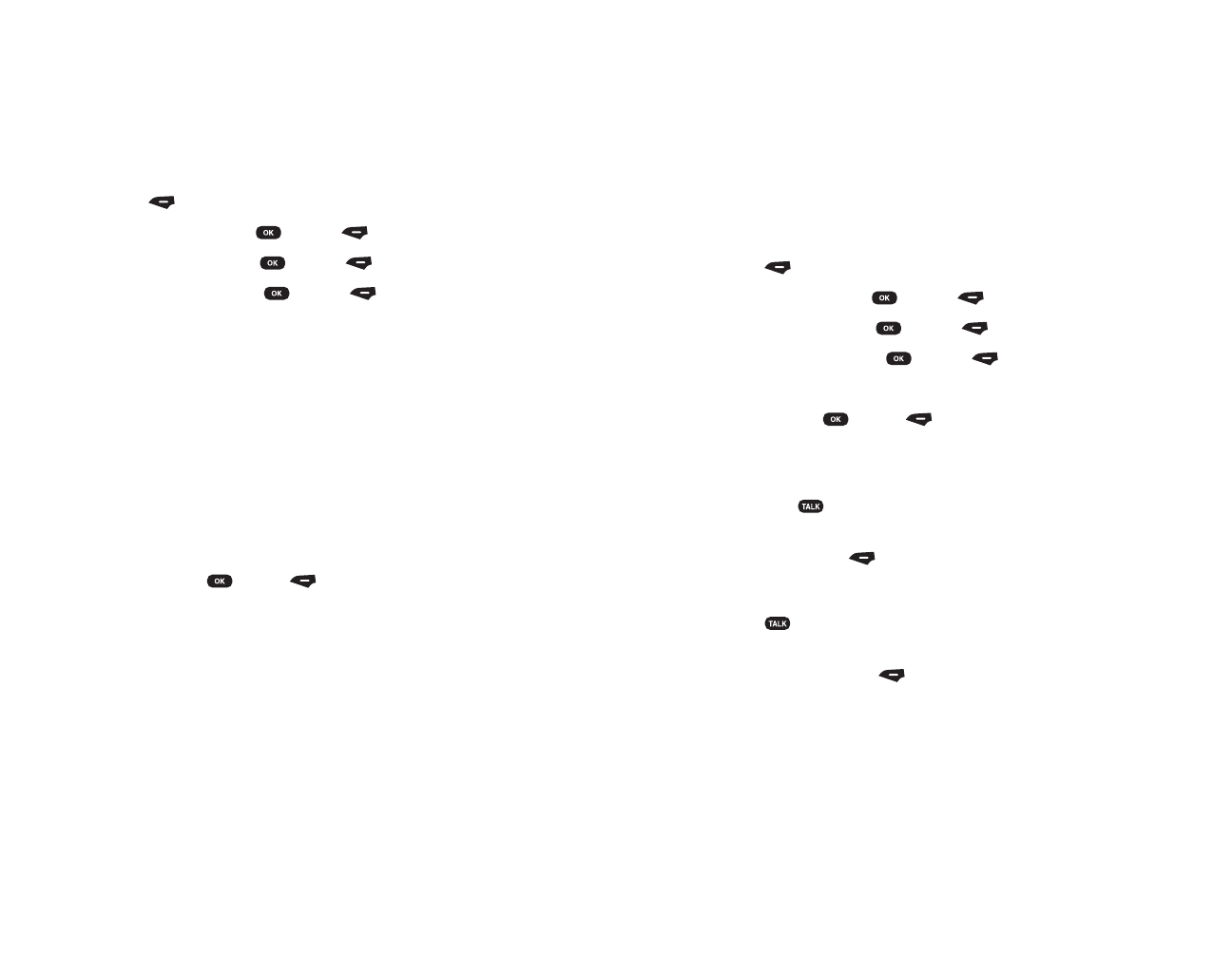
Controlling Roaming Charges Using
Call Guard
In addition to the roaming icon,Call Guard alerts you when roaming
charges apply.This feature makes it easy to manage your roaming
charges by reminding you when you make or receive roaming calls.It
also requires you to take an additional step before placing or
answering a roaming call.This additional step is not required when
you make or receive calls while on the enhanced Sprint Nationwide
PCS Network.
To Turn Call Guard On or Off:
1. Press (Menu) to access the main menu.
2. Select Settings,press (OK) or (Select).
3. Select Roaming,press (OK) or (Select).
4. Select Call Guard,press (OK) or (Select).
5. Select “On”or “Off” with the Navigation key.
6. To save,press (OK) or (Select).
To Place Roaming Calls With Call Guard On:
1. From standby mode,dial 1 + area code + the seven-digit number
and press .(You can also initiate a call from the Internal
Phone Book,Call History,or Messaging.)
2. Select Roam Call().
To Answer Incoming Roaming Calls With Call Guard On:
1. Press .
2. A message will appear notifying you that roaming charges will
apply.Select Answer().
Remember if the Call Guard feature is set to On,you need to take extra
steps to make and receive roaming calls even if you have selected the
Analog setting (see page 60).
Section 2: Understanding Your PCS Phone
2D: Controlling Your Roaming Experience 61
Setting Your Phone’s Roam Mode
Your PCS Phone allows you to control your ability to roam.By using
the Roamingmenu option,you can determine which signals your
phone accepts.
Set Mode
Choose from three different settings on your phone to control your
roaming experience:
1. Press (Menu) to access the main menu.
2. Select Settings,press (OK) or (Select).
3. Select Roaming,press (OK) or (Select).
4. Select Set Mode,press (OK) or (Select).
5. Select “Sprint Only”,“Automatic” or “Analog Only” with the
Navigation key.
Sprint Only :
This setting allows you to access the enhanced
Sprint Nationwide PCS Network only and prevents roaming
on other networks.
Automatic :This setting seeks PCS Service.When PCS Service
is unavailable,the phone searches for an alternate system.
Analog Only :This setting forces the phone to seek an analog
roaming system.The previous setting (Sprint Only or
Automatic) is restored the next time the phone is turned
on.
6. To save,press (OK) or (Select).
Section 2: Understanding Your PCS Phone
2D: Controlling Your Roaming Experience 60
SPRINT-motorola8/27 2003.8.27 2:16 PM Page 60

Section 2E
Navigating Through Menus
In This Section
Menu Navigation
Menu Structure
Viewing the Menus
This section is a road map to using your PCS Phone.Every function
and feature can be accessed through an onscreen menu.Take
a few moments to learn your way around and you’ll find your phone
easier to use.
Section 2: Understanding Your PCS Phone
2E: Navigating Through Menus 63
SPRINT-motorola8/27 2003.8.27 2:16 PM Page 62

Section 2: Understanding Your PCS Phone
2E: Navigating Through Menus 65
MenuNavigation
The navigation key on your PCS Phone allows you to scroll through
menus quickly and easily.The scroll bar at the right of the menu keeps
track of your position in the menu at all times.
To navigate through a menu,simply press the navigation key up or
down.If you are in a first-level menu,such as Settings,you may also
navigate to the next or previous first-level menu by pressing the
navigation key right or left.
Menu Structure
Selecting Menu Items
As you navigate through the menu,menu options are highlighted.
Select any numbered option by simply pressing the corresponding
number on the phone’s keypad.You may also select any item by
highlighting it and pressing .
For example,if you want to view your last incoming call:
1. Press (Menu) to access the main menu.
2. Select Recent Calls,press (OK) or (Select).
3. Select Outgoing Calls,press (OK) or (Select).If you have
received any calls,they are displayed on the screen.
Backing Up Within a Menu
To go to the previous menu:
Press .
To return to standby mode:
Press .
Section 2: Understanding Your PCS Phone
2E: Navigating Through Menus 64
Viewing the Menus
Menu Diagram
The following list outlines your phone’s menu structure.
[SAMPLE MENU]
Recent Calls
Outgoing Calls
Incoming Calls
Missed Calls
Erase History Outgoing Calls/Incoming Calls/Missed Calls/All Calls
Phone Book
Find Name
Add New Entry
My Phone #
Speed Dial #’s
Voice Names
Long Phone #’s
Services
Phone book Status
Erase Phone book
Messaging
Compose
Inbox
Outbox
Sent Folder
Drafts Folder
Quick Notes
Settings
Voice Mail
Call Voicemail
Clear Icon
Games
Bejeweled
Bowling
Football
Tools
Datebook
Alarm Clock
Calculator
World Clock
Stopwatch/Timer
Voice Memo
Shortcuts
SPRINT-motorola8/27 2003.8.27 2:16 PM Page 64

Section 2F
Managing Call History
In This Section
Viewing History
The Call History keeps track of incoming calls,calls made from your
PCS Phone,and missed calls.This section guides you through
accessing and making the most of your Call History.
Section 2: Understanding Your PCS Phone
2F: Managing Call History 67
Settings
Sounds Volume/Ringer Types/Alerts/Tone
Display Menu Display/Standby Display/Assign Keys/
Backlight Control/Greetings/Contrast/Font Size/
Time and Date/Sleep Mode
Roaming Set Mode/Call Guard
Location
Security Lock Phone/Change Lock Code/Phonebook Lock/
Erase Phonebook/Restrict Calls/Limit Use/Master Reset/
Master Clear
Others Language/Answer Options/Speed Dial/Abbrev. Dial/
Auto Redial/Airplane Mode/TTY Settings/Ph.Book Match
Phone Info. My Phone Number/Icon Glossary/Version
Section 2: Understanding Your PCS Phone
2E: Navigating Through Menus 66
SPRINT-motorola8/27 2003.8.27 2:16 PM Page 66
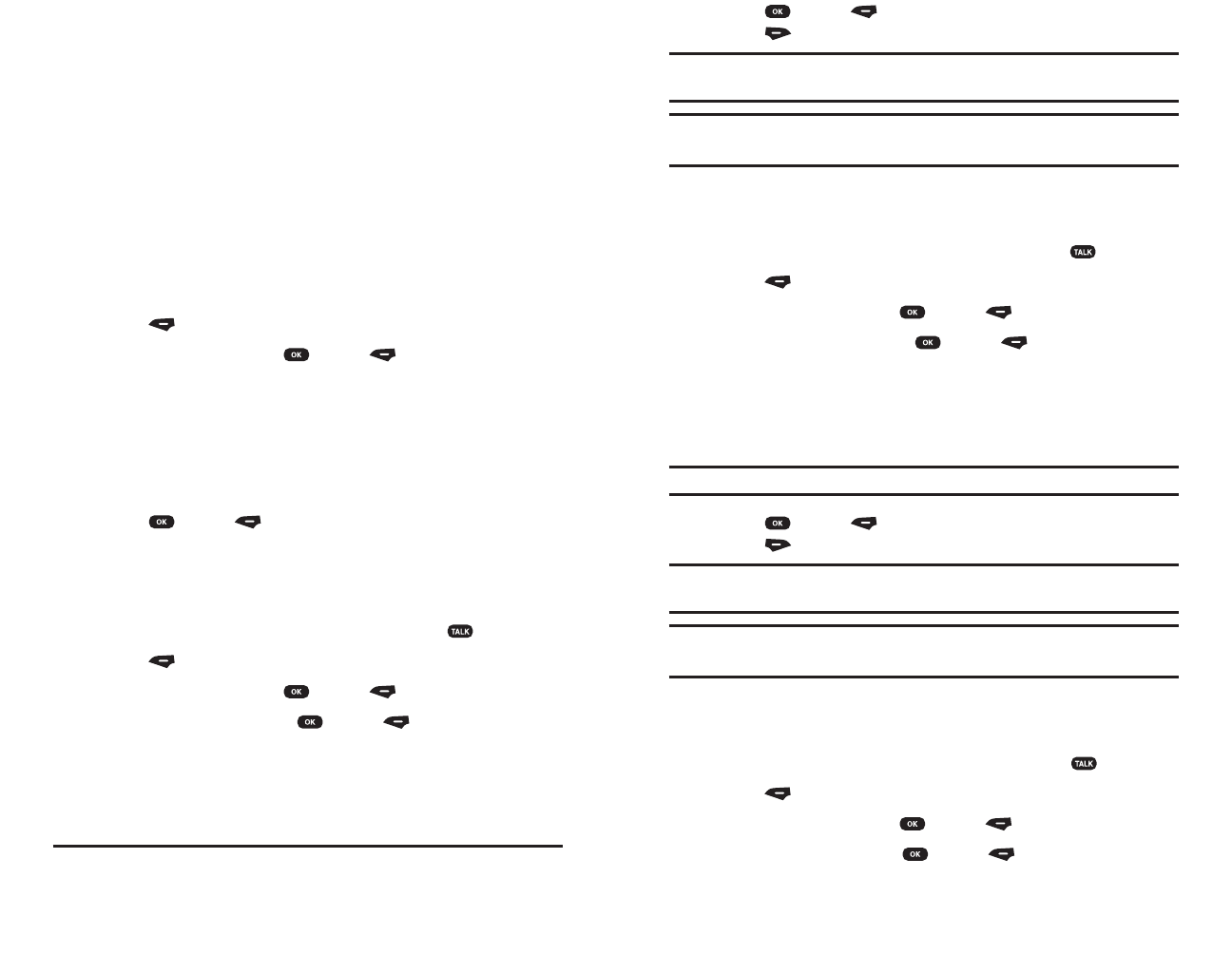
6. Press (OK) or (Store) again to save it or
press (Delete) to delete it.
Tip: “Phone # is already saved in phone book”or “Move to phone book save
mode?”will appear.
Note: After the twenty outgoing call, the oldest call will automatically be
erased from the history.
Incoming Calls
Displays information of the twenty most recently answered calls.
Saves the numbers and places calls by simply pressing .
1. Press (Menu) to access the main menu.
2. Select Recent Calls,press (OK) or (Select).
3. Select Incoming Calls,press (OK) or (Select).
4. If the number is already stored in your phone book,only the
name appears.If the number is not stored,only the phone
number appears.
5. To view incoming call details,press the Navigation Key.
Tip: Call details include date, time and phone number.
6. Press (OK) or (Store) again to save it or
press (Delete) to delete it.
Tip: “Phone # is already saved in phone book”or “Move to phone book save
mode?”will appear.
Note: After the tenth incoming call, the oldest call will automatically be
erased from the history.
Missed Calls
Displays information of the 10 most recently missed calls.
Place a call to a missed call number by simply pressing .
1. Press (Menu) to access the main menu.
2. Select Recent Calls,press (OK) or (Select).
3. Select Missed Calls,press (OK) or (Select).
Section 2: Understanding Your PCS Phone
2F: Managing Call History 69
Section 2: Understanding Your PCS Phone
2F: Managing Call History 68
Viewing History
You’ll find the Call History feature very helpful.It is a list of the last 20
phone numbers (or Internal Phone Book entries) for calls you placed,
accepted,or missed.Call History makes redialing a number fast and
easy.It is continually updated as new numbers are added to the
beginning of the list and the oldest entries are removed from the
bottom of the list.
Each entry contains the phone number (if it is available) and Internal
Phone Book entry name (if the phone number is in your Internal
Phone Book).Duplicate calls (same number and type of call) may
only appear once on the list.
To view a Call History entry:
1. Press (Menu) to access the main menu.
2. Select Recent Calls,press (OK) or (Select).
3. Select one of the following options.
Outgoing Calls
Incoming Calls
Missed Calls
Erase History
4. Press (OK) or (Select).
Outgoing Calls
Displays information about the twenty most recently dialed
numbers.
Saves the numbers and places call by simply pressing .
1. Press (Menu) to access the main menu.
2. Select Recent Calls,press (OK) or (Select).
3. Select Outgoing Calls,press (OK) or (Select).
4. If the number is already stored in your phone book,only the
name appears.If the number is not stored,only the phone
number appears.
5. To view outgoing call details,press the Navigation Key.
Tip: The detail includes date, time, and phone number of outgoing calls.
SPRINT-motorola8/27 2003.8.27 2:16 PM Page 68
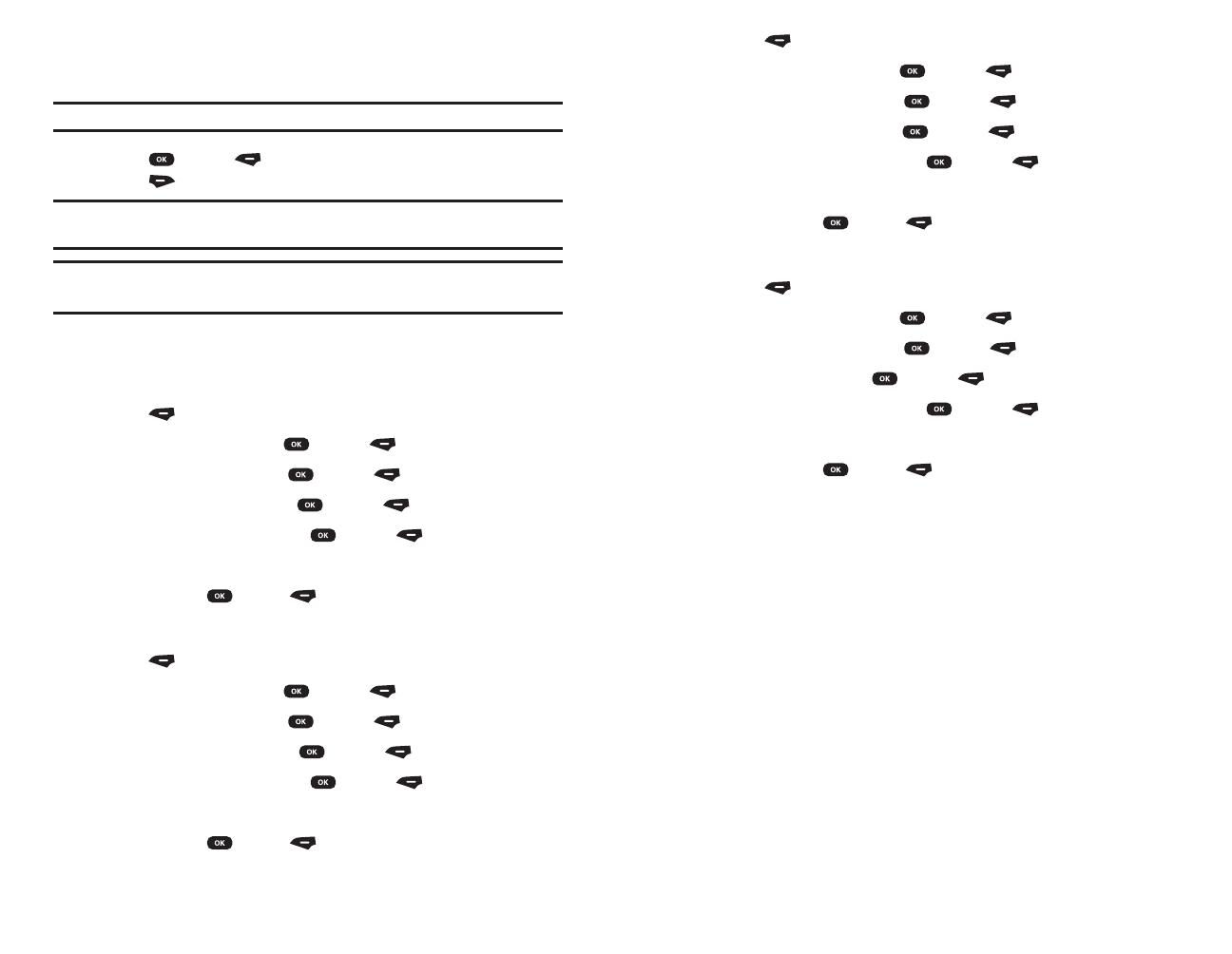
Missed Calls
1. Press (Menu) to access the main menu.
2. Select Recent Calls,press (OK) or (Select).
3. Select Erase History,press (OK) or (Select).
4. Select Missed Calls,press (OK) or (Select).
5. Read the message,and press (OK) or (OK).
6. Select “Yes”or “No”with the Navigation key.
7. To save,press (OK) or (Yes).
All Calls
1. Press (Menu) to access the main menu.
2. Select Recent Calls,press (OK) or (Select).
3. Select Erase History,press (OK) or (Select).
4. Select All Calls,press (OK) or (Select).
5. Read the message,and press (OK) or (OK).
6. Select “Yes”or “No”with the Navigation key.
7. To save,press (OK) or (Yes).
Section 2: Understanding Your PCS Phone
2F: Managing Call History 71
4. If the number is already stored in your phone book,only the
name appears.If the number is not stored,only the phone
number appears.
5. To view missed call details,press the Navigation Key.
Tip: Call details include date, time and phone number.
6. Press (OK) or (Store) again to save it or
press (Delete) to delete it.
Tip: “Phone # is already saved in phone book”or “Move to phone book save
mode?”will appear.
Note: After the tenth missed call, the oldest call will automatically be erased
from the history.
Erase History
Outgoing Calls
1. Press (Menu) to access the main menu.
2. Select Recent Calls,press (OK) or (Select).
3. Select Erase History,press (OK) or (Select).
4. Select Outgoing Calls,press (OK) or (Select).
5. Read the message,and press (OK) or (OK).
6. Select “Yes”or “No”with the Navigation key.
7. To save,press (OK) or (Yes).
Incoming Calls
1. Press (Menu) to access the main menu.
2. Select Recent Calls,press (OK) or (Select).
3. Select Erase History,press (OK) or (Select).
4. Select Incoming Calls,press (OK) or (Select).
5. Read the message,and press (OK) or (OK).
6. Select “Yes”or “No”with the Navigation key.
7. To save,press (OK) or (Yes).
Section 2: Understanding Your PCS Phone
2F: Managing Call History 70
SPRINT-motorola8/27 2003.8.27 2:16 PM Page 70

Section 2G
Using the Internal Phone Book
In This Section
Internal Phone Book Entry Options
Entering Text
Adding a New Internal Phone Book Entry
Finding Internal Phone Book Entries
My Phone #
Speed Dial #’s
Voice Names
Long Phone #’s
Services
Phone Book Status
Erase Phone Book
Now you know the basics that make it easier to stay in touch with
people and information.This section helps you make the most of
your contacts and time when you are trying to connect with the
important people in your life.
Section 2: Understanding Your PCS Phone
2G: Using the Internal Phone Book 73
Section 2: Understanding Your PCS Phone
2F: Managing Call History 72
SPRINT-motorola8/27 2003.8.27 2:16 PM Page 72

Tap Method
Tap method is the default standard mode for entering text on your
phone.To activate tap method from any text entry screen,press
(Options) and select the Tap Method menu option.To enter text using
the tap method:
Press a number key one or more timescycle through the characters
associated with the key and select the character you want.
Continue to press number keysenter the rest of the characters in
the text message.
Press (OK) or (OK) accept and store the text when you
are finished.
General Text Entry Rules
Use the keypad to enter letters,numbers,symbols,and other
characters with the tap method.Press the same key repeatedly to
cycle through available characters
Press a number key as many times as necessary to enter the
desired character.
Press and hold a number key to cycle between tap method and
numeric text entry mode.
Space
Switch between lowercase to uppercase letters
If you do not press a key for two seconds,the character in the
block cursor is accepted,and the cursor moves to the next
position.
The first character of every sentence is capitalized unless you
manually change it.(Press to force the character to
lowercase while it is highlighted by the block cursor.)
Section 2: Understanding Your PCS Phone
2G: Using the Internal Phone Book 75
Internal Phone Book Entry Options
To access an Internal Phone Book Entry’s options,display the entry.
To select an option,highlight it and press .
[Add number]to add a phone number to the entry.
(See “Adding a New Internal Phone Book Entry”on page 79)
[Name]to add an name to the entry.
[Address]to add an address to the entry.
Tip: You can view the next entry by pressing the navigation key right or view the
previous entry by pressing the navigation key left.
Entering Text
Various text entry methods make it easy for you to enter names,
numbers,and text messages on your phone.You can enter all
characters (letters,numbers,and symbols) using the standard tap
method.Other text modes let you easily enter numbers and symbols,
or insert text already stored on your phone.Finally,a predictive text
mode lets you enter text messages with a minimum of keypresses.
Selecting a Character Input Mode
To activate a text mode,press (Options) from any text entry
screen and select the text mode from the Entry Method menu:
1. When you display a screen where you can enter text,
press (Options).
2. Select a character input mode:
iTAP Let the phone predict each word as you enter it,then
choose the word from a list.
Tap MethodEnter characters one at a time by pressing the
key for the letter,number,or symbol.This is the standard
mode for entering text on your phone.
NumericEnter only the number that appears on each key.
Symbol Enter symbols only.
BrowseBrowse through your phonebook lists to select a
name or number to enter.
Note: The text mode you select remains active until you change it by selecting
another mode.
Section 2: Understanding Your PCS Phone
2G: Using the Internal Phone Book 74
SPRINT-motorola8/27 2003.8.27 2:16 PM Page 74

Section 2: Understanding Your PCS Phone
2G: Using the Internal Phone Book 77
Character Chart
Use this chart as a guide for entering spaces,numbers,letters,
symbols,and other characters with the tap method.
.,@1 ? ! *#/
A B C 2ÀÃÁÂÇ
D E F 3ÉÈÊ
G H I 4Í
J K L 5
M N O 6ÑÒÕÓÔ
P Q R S 7
T U V 8ÙÚÜ
W X Y Z 9
0
Entering Symbol
Your phone provides an alternate way to find and enter symbol
characters in a text message.You can view and select from a variety of
available symbols.To activate symbol mode from any text entry
screen,press (Options)and select the Symbol menu option.To
enter a symbol in symbol mode:
Move cursor with navigation keyand select the symbol you want.
. , : ; ! - @ ’ ” ? + * = / \ $ & # ( ) ˆ ˜ ` < > % _ | [ ] :) SP ¶ { }
Press (OK) or (Select) accept symbol.
Predictive Text Entry with iTAP™ Software
iTAP™ software provides a predictive text entry method that lets you
enter the letters of a word using only one keypress per letter.You
must activate iTAP software prior to entering letters.You can do this
from any text entry screen by pressing (Options) to open the
Entry Method menu and selecting the iTAP menu option.
Press a number key one timeenter the first letter of the word.The
letters associated with the key you pressed are shown at the
bottom of the display.
Section 2: Understanding Your PCS Phone
2G: Using the Internal Phone Book 76
Press number keysenter the rest of the word.Alternative words
and letter combinations are shown at the bottom of the display
based on the keys you press.These word choices are updated
with each keypress.
When you have entered all the letters of the word, press navigation
keylocate and highlight the word you want.
Press (OK) or (Select) add the highlighted word to the
text area at the top of the display.A space is automatically
inserted after the word.
Enter Novel Words
You may enter a word that is not in the iTAP software dictionary.If
you enter all the letters of a word but the word is not displayed:
Press one or more times delete one or more letters until you
see a letter combination that matches the start of the word.
Press navigation key highlight the letter or letter combination.
Press (OK) or (Select) shift the text entry cursor to the
left and “lock”the selected portion of the word.
Continue entering letters and highlighting letter combinations spell
the word.
Punctuation
The iTAP software automatically adds a space after each word.When
you enter punctuation,this space is removed.To enter punctuation
with iTAP software:
Press or enter punctuation or other characters.
Capitalization
The first word of a sentence is automatically capitalized,with
following words in lowercase.To set or adjust character capitalization
with iTAP software:
Press change the words to initial character capitalized,all
uppercase characters,or all lowercase characters.
SPRINT-motorola8/27 2003.8.27 2:16 PM Page 76

Adding a New Internal Phone Book Entry
Your PCS Phone can store up to 300 Internal Phone Book entries.
Phone book entries can store up to a total of 300phone numbers and
the entry’s name can contain sixteen characters.
To add a new entry:
1. Press (Menu) to access the main menu.
2. Select Phone Book,press (OK) or (Select).
3. Select Add New Entry,press (OK) or (Select).
4. Enter a “Name”to display the name editor and enter a name.
To change the input mode,press (Options) and Press
(Browse) search the name from “Phonebook”.Press (OK) or
(OK)to store the name.
5. Enter a “No.”to enter a phone number.To press (Options)
select either “Hard Pause”or “2Sec.Pause”(Hard Pauses are
displayed as a “P”and 2Sec.Pause as a “T”),press (OK) or
(OK)to store the phone number.
6. The Phone # will appear next to a list of icons,press (OK) or
(Select).The name of the icon is displayed above the list.
Use the Navigation key to choose the type of # you’re adding,as
indicated by the icon then use the Navigation key,press
(OK) or (Select).
7. Enter a speed number.Use the Navigation key to choose the
speed number then,press (OK) or (Select).
8. Press (Done) to move “Entry Form”.
9. Use the Navigation key to scroll through more options for the
entry (Ringer ID,Email,Add more phone number).
10. To store the entry,press (Done) “Stored”will be displayed.
Finding Internal Phone Book Entries
There are several ways to display your Internal Phone Book entries.
Follow the steps outlined in the sections below to display entries
from the Internal Phone Book menu.
Find Name
You can search Internal Phone Book entries for phone numbers that
contain a specific string of numbers.
Section 2: Understanding Your PCS Phone
2G: Using the Internal Phone Book 79
Enter Numbers
To enter a number with iTAP software:
Enter the first digit and then highlight itput the iTAP software in
number entry mode.
Press number keysadd digits to the number.
Press (OK) or (Select) enter the number at the insertion
point.
Delete Letters and Words
Place the cursor to the right of the text that you want to delete,and
then do the following:
Press delete one letter at a time.
Continue to hold delete the entire message.
Section 2: Understanding Your PCS Phone
2G: Using the Internal Phone Book 78
SPRINT-motorola8/27 2003.8.27 2:16 PM Page 78

Speed Dial #’s
1. Press (Menu) to access the main menu.
2. Select Phone Book,press (OK) or (Select).
3. Select Speed Dial #’s,press (OK) or (Select).
4. Select the empty location,press (OK) or (Assign).
5. Select the phone number from “Phone Book”and press (OK)
or (Select).
6. To remove “Speed Dial #’s”,select the assign location press
(Remove).
7. Select “Yes”or “No”with the Navigation key.
8. To save,press (OK) or (Yes).
Voice Names
1. Press (Menu) to access the main menu.
2. Select Phone Book,press (OK) or (Select).
3. Select Voice Names,press (OK) or (Select).
4. Select the “Add Voice Name”,press (OK) or (Select).
5. Select the phone number from “Phone Book”and press (OK)
or (Select).
6. Appears message “press voice key then say name”then press
“Voice Key”.“say name now”follow the voice prompts to user
saying voice name.
7. Press (Edit) to select submenu.
Record : To re-record voice name.
Delete : To delete recorded voice name.
Section 2: Understanding Your PCS Phone
2G: Using the Internal Phone Book 81
To find a phone number:
1. Press (Menu) to access the main menu.
2. Select Phone Book,press (OK) or (Select).
3. Select Find Name,press (OK) or (Select).
4. Enter the name or part of the name,All matched entries will be
displayed.Use the navigation key to select the entry.
5. Press (OK) or (View).
6. To display the Internal Phone Book entry that contains the
phone number and display details information and press
(Edit).To edit the phone number.
7. Press (Options) to select submenu,press (OK) or
(Select).
New : Adding a new internal phone book entry.
Edit : To change the entry’s phone number, label, name, entry
number, secret mode, speed dial number.
Delete : To delete the entry.
Send Message : To send the message.
Secret : To make an entry secret.
Prepend : To add number to the beginning of the phone number.
Add Digits : To add a phone number to the entry.
Attach Number
Set Primary
8. To call the selected number,press .
My Phone #
To display your phone number.
1. Press (Menu) to access the main menu.
2. Select Phone Book,press (OK) or (Select).
3. Select My Phone #,press (OK) or (Select).
4. To display your phone number.
5. To return to the previous page,press (OK) or (OK).
Section 2: Understanding Your PCS Phone
2G: Using the Internal Phone Book 80
SPRINT-motorola8/27 2003.8.27 2:16 PM Page 80
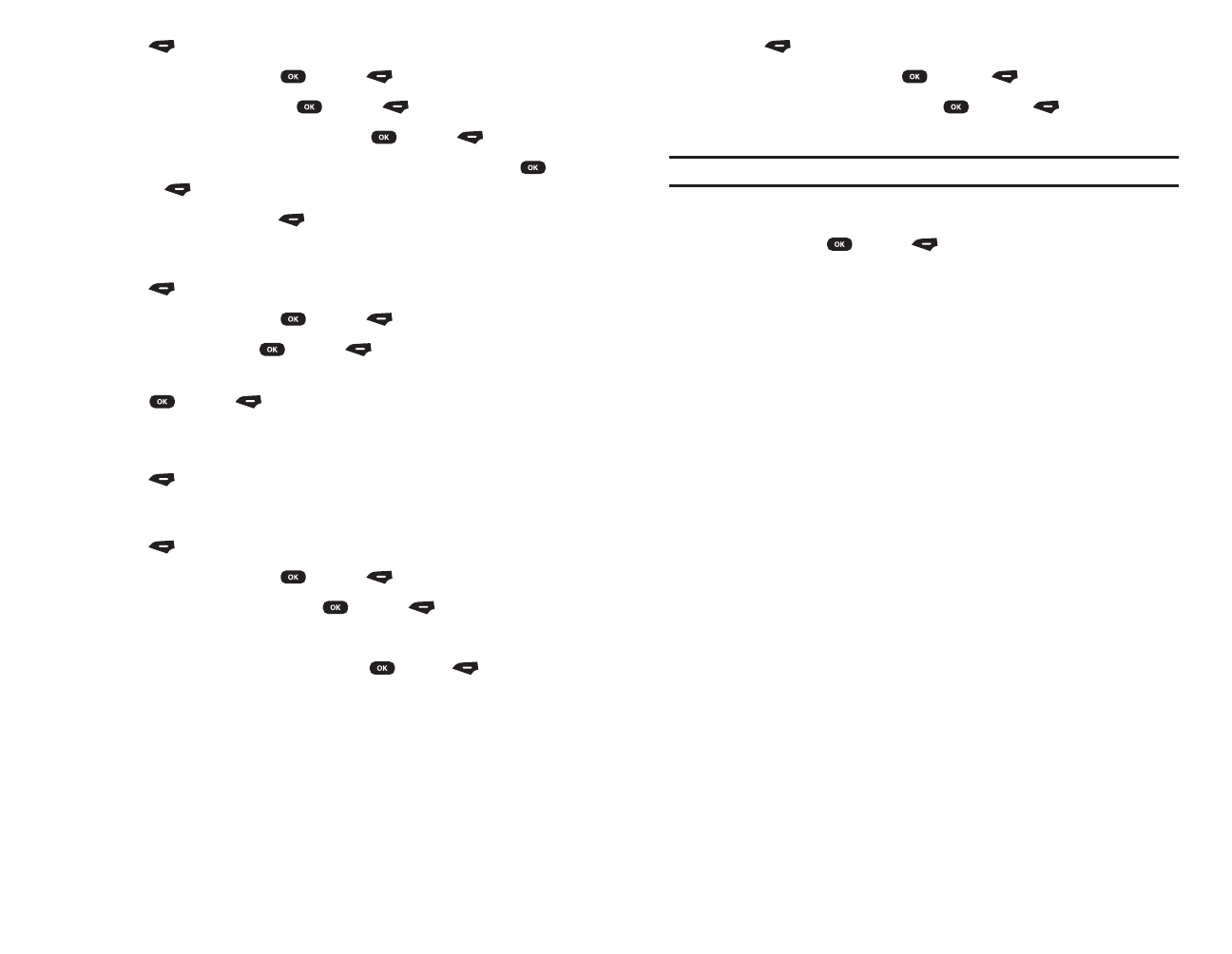
Erase Phone Book
1. Press (Menu) to access the main menu.
2. Select Phone Book,press (OK) or (Select).
3. Select Erase Phone Book,press (OK) or (Select).
4. Enter Unlock Code.
Note: The default unlock code is “1234”.
5. Select “Yes”or “No”with the Navigation key.
6. To save,press (OK) or (Yes).
Section 2: Understanding Your PCS Phone
2G: Using the Internal Phone Book 83
Long Phone #’s
1. Press (Menu) to access the main menu.
2. Select Phone Book,press (OK) or (Select).
3. Select Long Phone #’s,press (OK) or (Select).
4. Enter long phone #’s name and press (OK) or (OK).
5. Enter long phone #’s phone number with pause and press
(OK) or (OK).
6. To store the entry,press (Done) “Stored”will be displayed.
Services
1. Press (Menu) to access the main menu.
2. Select Phone Book,press (OK) or (Select).
3. Select Services,press (OK) or (Select).
4. Select one of the following options with the navigation key and
press (OK) or (Select).
Cust. Solutions / Dir. Assistance / Account Info. / Sprint Operator /
Voice Command
5. Press (Call) to connecting call.
Phone Book Status
1. Press (Menu) to access the main menu.
2. Select Phone Book,press (OK) or (Select).
3. Select Phone book Status,press (OK) or (Select).
4. Display phone book storage status.
5. To return to the previous page,press (OK) or (OK).
Section 2: Understanding Your PCS Phone
2G: Using the Internal Phone Book 82
SPRINT-motorola8/27 2003.8.27 2:16 PM Page 82

Section 2H
Personal Organizer
In This Section
Datebook
Alarm Clock
Calculator
World Clock
Stopwatch/Timer
Your PCS Phone is equipped with several personal information
management features that help you manage your busy lifestyle.
These features turn your phone into a time management planner that
helps you keep up with your contacts,schedules,and commitments.
It takes productivity to a whole new level.
Section 2: Understanding Your PCS Phone
2H: Personal Organizer 85
Section 2: Understanding Your PCS Phone
2G: Using the Internal Phone Book 84
SPRINT-motorola8/27 2003.8.27 2:16 PM Page 84

Alarm :Off / 5 min before / 10 min before / 30 min before
/ 1 hour before / 1 day before / 1 week before / Custom.
8. To save,press (OK) or (Done).
Changing Event Information
1. Press (Menu) to access the main menu.
2. Select Tools,press (OK) or (Select).
3. Select Datebook,press (OK) or (Select).
4. Press (View) to scroll to the you want to change,
press (OK) or (View).
5. Press (Options) to select submenu,press (OK) or
(Select).
Go to Today
New
Edit
Delete
Copy
Setup
6. Select Edit,press (OK) or (Select).
7. Enter new information.
Press (OK) or (Done) to store the event.
Alarm Clock
1. Press (Menu) to access the main menu.
2. Select Tools,press (OK) or (Select).
3. Select Alarm Clock,press (OK) or (Select).
4. To select “New Alarm”,press (OK) or (Select).
5. Enter a “Name”to display the title editor and enter a title.
To change the input mode,press (Options).Press (OK) or
(OK) to store the name.
6. Enter a “Time”to display the time editor and enter a time.
Press (OK) or (Done) to store the time.
Navigation Key (Left/Right) :Move input area.
Section 2: Understanding Your PCS Phone
2H: Personal Organizer 87
Datebook
The datebook is a calendar that lets you schedule and organize events
such as appointments and meetings.You can set the datebook to send
a reminder alarm for specific events.
Adding a Datebook Event
1. Press (Menu) to access the main menu.
2. Select Tools,press (OK) or (Select).
3. Select Datebook,press (OK) or (Select).
4. Press (View) to select “New Event”,press (OK) or
(Select).
5. Enter a “Title”to display the title editor and enter a title.
To change the input mode,press (Options) and press
(Browse) search the title from “Quick Titles”.Press (OK) or
(OK) to store the title.
Quick Title :Meeting / Appointment / Presentation /
Conference Call / Breakfast / Lunch / Dinner / Anniversary /
Birthday / Flight / Party.
6. Enter a “Start”to display the time editor and enter a time.
Press (OK) or (Done) to store the time.
Navigation Key (Left/Right) :Move input area.
Navigation Key (Up/Down) :Select Hour / Minute /
am,pm,24hr.
7. Scroll to other fields and enter information as necessary.
You can set duration,date,repeat interval,and reminder
alarm.
Duration :None / 30 min / 1 hour / 2 hour / 3 hour / 4
hour / Rest of day / All day / Custom.
Date :Navigation Key (Left/Right) move input area.
Navigation Key (Up/Down) select Day / Month / Year.
Repeat :None / 30 min / 1 hour / 2 hour / 3 hour / 4
hour / Rest of day / All day / Custom.
Date :None / Daily / Weekly / Monthly Day / Monthly
Date / Yearly.
Repeat :None / 30 min / 1 hour / 2 hour / 3 hour / 4
hour / Rest of day / All day / Custom.
Section 2: Understanding Your PCS Phone
2H: Personal Organizer 86
SPRINT-motorola8/27 2003.8.27 2:16 PM Page 86
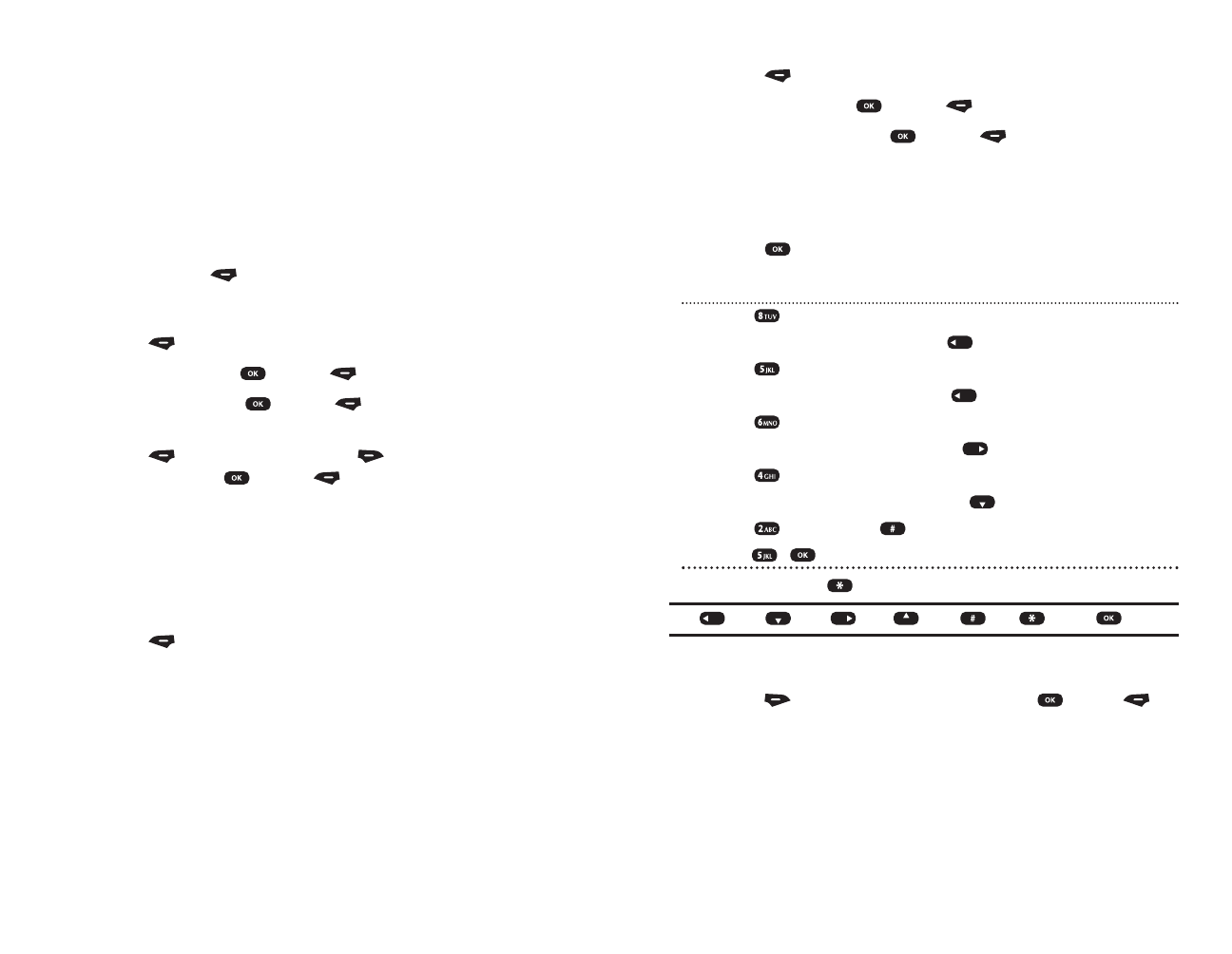
Calculator
To access the calculator:
1. Press (Menu) to access the main menu.
2. Select Tools,press (OK) or (Select).
3. Select Calculator,press (OK) or (Select).
4. Enter a number.
5. To select an arithmetic option,press the navigation key in the
direction indicated on the display.
6. Press (OK) to calculate the equation.
Follow the instructions below to calculate (8+5*6)/4-2.5
Input .
Move the Navigation key upward .
Input .
Move the Navigation key leftward .
Input .
Move the Navigation key rightward .
Input .
Move the Navigation key downward .
Input and press the to input (.).
Press , .
7. To reset,press (CE).
Tip: :X:--- :/ :+ :. :CE :=.
Calculator Options
Press (Options) to select submenu,press (OK) or
(Select).
+/- to change the entry’s sign (positive/negative).
$ to calculate the exchange rate.
MS to store the value in memory.
MC to clear the value stored in memory.
MR to replace the displayed value with the value stored
in memory.
Section 2: Understanding Your PCS Phone
2H: Personal Organizer 89
Navigation Key (Up/Down) :Select Hour / Minute /
am,pm,24hr.
7. Scroll to other fields and enter information as necessary.
You can set ring,volume,repeat interval,and reminder alarm.
Ring :Badineri / Big Ben / Blues Riff / Bumblebee / Dance /
Falling / Flying Carpet / Gliss / Invention / Pop / Rag Tag /
Rock It / Rock-a-billy / Samba / Smooth Music / Irumpet Call
/ Vibrate.
Volume :Adjust the ringer volume with the Navigation key.
(Level 0~7)
Repeat :Once / Daily.
8. To save,press (Done).
Changing Alarm Information
1. Press (Menu) to access the main menu.
2. Select Tools,press (OK) or (Select).
3. Select Alarm,press (OK) or (Select).
4. Scroll to the you want to change
Press (Enable/Disable) or Press (Options) to select
submenu,press (OK) or (Select).
New
Edit
Delete
Delete All
Auto Snooze
5. Press (Done) to store the alarm.
Section 2: Understanding Your PCS Phone
2H: Personal Organizer 88
SPRINT-motorola8/27 2003.8.27 2:17 PM Page 88
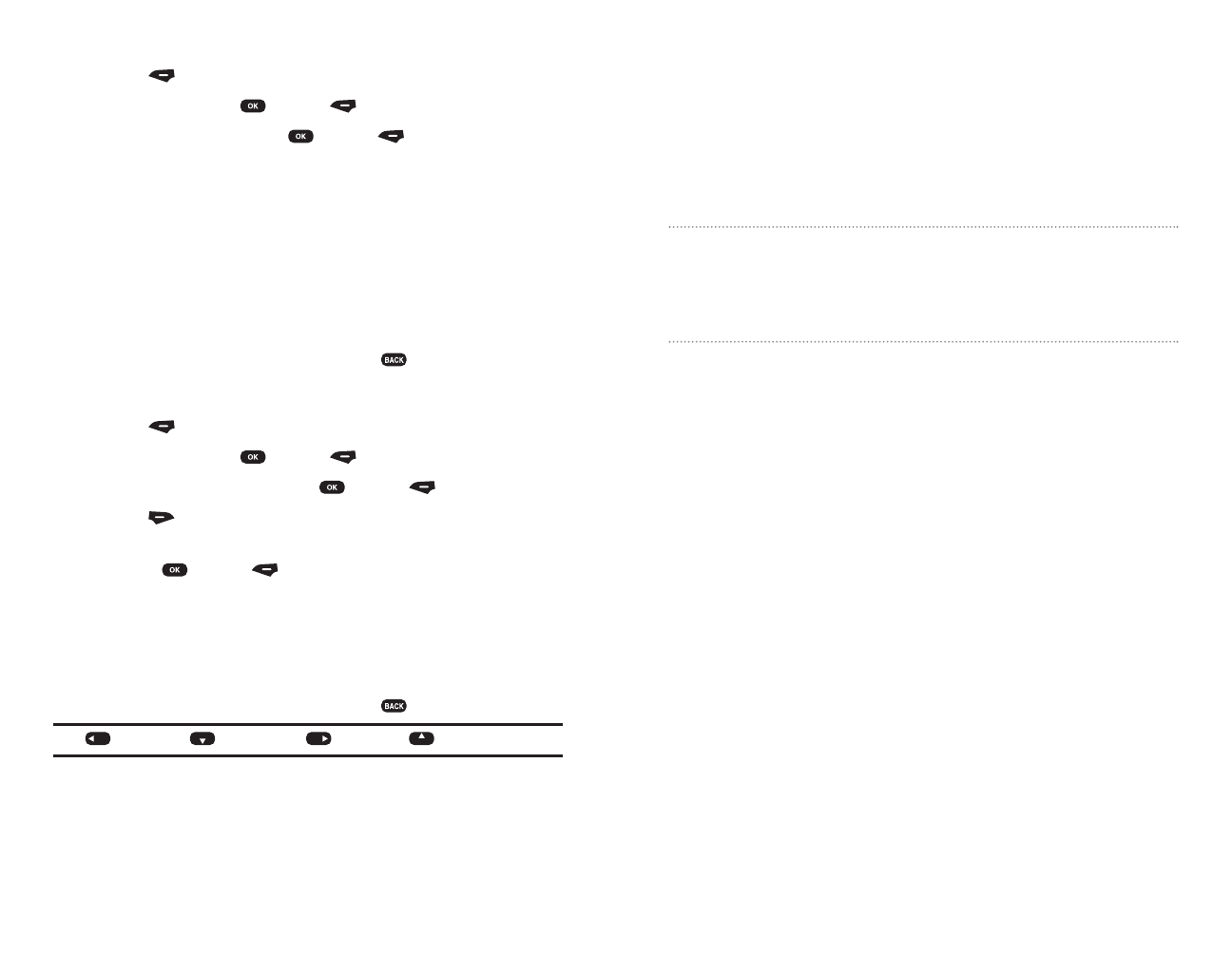
Section 2I
Using Your Phone’s
Voice Services
In This Section
Recording Voice Memos
Play Voice Memo
Erasing Voice Memos
This section explains the features associated with your phone’s
Voice Services.The easy-to-follow instructions explain how to use
voice-activated dialing and how to record and manage voice memos.
Section 2: Understanding Your PCS Phone
2I: Using Your Phone’s Voice Services 91
World Clock
Notifies you of the time in a specific preprogrammed city.
1. Press (Menu) to access the main menu.
2. Select Tools,press (OK) or (Select).
3. Select World Clock,press (OK) or (Select).
4. The world map is to be displays with the city,its date and time
and summer time.
5. Use the Navigation key to select another city.
Samoa, Honolulu, Anchorage, San Francisco/LA, Denver,
Chicago, New York, Caracas/La Paz, Sao Paulo, Reykjavik,
London, Paris/Berlin, Athens, Moscow, Kabul, New Dehli,
Bangkok, Hong Kong, Seoul/Tokyo, Sydney, Solomon,
Wellington.
6. To return to the previous page,press .
Stopwatch/Timer
1. Press (Menu) to access the main menu.
2. Select Tools,press (OK) or (Select).
3. Select Stopwatch/Timer,press (OK) or (Select).
4. Press select “Stopwatch” or “Timer” .
5. Enter a “Timer”to display the time editor and enter a time.
Press (OK) or (Done) to store the time.
Navigation Key (Left/Right) :Move input area.
Navigation Key (Up/Down) :Select hh / mm / ss.
6. To select an “Stopwatch/Timer”option,press the navigation
key in the direction indicated on the display.
7. To return to the previous page,press .
Tip: :Reset :Pause :Stop :Start
Section 2: Understanding Your PCS Phone
2H: Personal Organizer 90
SPRINT-motorola8/27 2003.8.27 2:17 PM Page 90

Section 2J
Using Your Phone’s
Games
In This Section
Bejeweled
Bowling
Football
This section explains the features associated with your phone’s
Game.You can play games on your phone between phone calls.An
incoming call,message,alarm,or alert automatically ends the game.
Section 2: Understanding Your PCS Phone
2J: Using Your Phone’s Game 93
Recording Voice Memos
To record a voice memo:
1. Press (Menu) to access the main menu.
2. Select Voice Memo,press (OK) or (Select).
3. To select “New Voice Memo”,press (OK) or (Select).
4. Read the message,and press and hold voice key while to
recording voice memo.After the beep,starts recording.
5. To release the voice key,automatically save voice memo.
Play Voice Memo
To play the voice memos you have recorded:
1. Press (Menu) to access the main menu.
2. Select Voice Memo,press (OK) or (Select).
3. To select you want to play voice memo,press (OK) or
(Play).
4. To return to the previous page,press (OK) or (OK).
Erasing Voice Memos
To erase all voice memos:
1. Press (Menu) to access the main menu.
2. Select Voice Memo,press (OK) or (Select).
3. To select you want to erase voice memo,Press (Options)
to select submenu,press (OK) or (Select).
New
Delete
Delete All
Play Again
Save
4. Select Delete or Delete All,press (OK) or (Select).
5. Select “Yes”or “No”with the Navigation key.
6. To save,press (OK) or (Yes).
Section 2: Understanding Your PCS Phone
2I: Using Your Phone’s Voice Services 92
SPRINT-motorola8/27 2003.8.27 2:17 PM Page 92

Bowling
Play a Game
1. Press (Menu) to access the main menu.
2. Select Games,press (OK) or (Select).
3. Select Bowling,press (OK) or (Select).
4. Start Bejeweled game and select “Game”or “Series”.
Controls :Press L/R navigation key to choose the starting
position of your shot.You may also use 4 to move left and
6 to move right.Press the (OK) or 5 to operate the
shot meters.
Power Meter :The power meter appears on the right side
of the screen.Press (OK) or 5 to start the meter,and
press again to set the power.For optimum power,stop
the power meter between the two guide arrows.To
overpower,stop the meter near the very top.
Aim Meter :After setting your power,the aim meter will
move back and forth across the lane.Press (OK) or 5
to stop the aim meter in the direction you want your
shot to roll.
Spin Meter :The spin meter moves back and forth at the
top of the screen.To spin left,press (OK) or 5 when
the meter is left of the middle mark.To spin right,press
when the meter is right of the middle mark.For no spin,
press when the meter is on the middle mark.
5. To end the game,press or .
Game Menus
Game
Series
Help
Reset
Turn Effects
Turn Effects ON
Turn Effects OFF
Exit
Section 2: Understanding Your PCS Phone
2J: Using Your Phone’s Game 95
Bejeweled
Play a Game
Swap adjacent gems to create row of 3 or more identical gems.
1. Press (Menu) to access the main menu.
2. Select Games,press (OK) or (Select).
3. Select Bejeweled,press (OK) or (Select).
4. Start Bejeweled game and select game level ~ key.
Select jewel, press (OK).
Move jewel, press navigation key.
5. Press (Game Pause) to access the main game menu.
6. To end the game,press .
Game Menus
1.Normal
2.Advanced
3.Expert
4.Help
5.Options
Sound is ON/OFF
Vibrate is ON/OFF
Exit
6.Exit
Section 2: Understanding Your PCS Phone
2J: Using Your Phone’s Game 94
SPRINT-motorola8/27 2003.8.27 2:17 PM Page 94

Section 2K
Using Your Phone’s
Shortcuts
In This Section
Creating a Shortcut
Editing a Shortcut
Using Shortcuts
Delete a Shortcut
This section explains the features associated with your phone’s
Shortcuts.Your phone includes several pre-programmed shortcuts.
You can create additional shortcuts,if you like,to mark frequently used
menu items.
Section 2: Understanding Your PCS Phone
2K: Using Your Phone’s Shortcuts 97
Football
Play a Game
1. Press (Menu) to access the main menu.
2. Select Games,press (OK) or (Select).
3. Select Football,press (OK) or (Select).
4. Start Football game and select “1-Player”or “2-Player”.
How To Play :Use the navigation keys to move your player
and avoid the defenders to score.You may also use the
“2”,“4”,“6”,and “8”keys to move.On 4th down,press “5”
to punt or kick a field goal.To pass,press “5”.Passing can
be enabled by turning the feature “On”from the
“Options”screen.
5. To end the game,press or .
Game Menus
1-Player
Select CPU Level 1~10
Start Game
Main Menu
2-Player
Select Game Level Hard/Easy
Start Game
Main Menu
Options
Sound is ON/OFF
Passing is ON/OFF
High Score
Credits
Main Menu
How To Play
Exit
Section 2: Understanding Your PCS Phone
2J: Using Your Phone’s Game 96
SPRINT-motorola8/27 2003.8.27 2:17 PM Page 96

Using Shortcuts
1. Press (Menu) to access the main menu.
2. Select Shortcuts,press (OK) or (Select).
3. To select shortcut,press (Go To).
Delete a Shortcut
1. Press (Menu) to access the main menu.
2. Select Shortcuts,press (OK) or (Select).
3. To select you want to delete shortcut,press (Options) to
select submenu,press (OK) or (Select).
New
Edit
Reorder List
Delete
Delete All
4. Select Delete or Delete All,press (OK) or (Select).
5. Select “Yes”or “No”with the Navigation key.
6. To save,press (OK) or (Yes).
Section 2: Understanding Your PCS Phone
2K: Using Your Phone’s Shortcuts 99
Creating a Shortcut
The following shortcuts are pre-programmed in your phone.You
cannot edit or delete these shortcuts.
1. Press (Menu) to access the main menu.
2. Select Shortcuts,press (OK) or (Select).
3. To select “New Shortcuts”,press (OK) or (Select).
4. Read the message.
To assign a new Shortcut...(STEP1) Scroll to the item you
want as a shortcut.(STEP2) Press&hold when item is
highlighted.(STEP3) To access shortcuts...press&hold
from idle screen.
5. Scroll to the item you want as a shortcut.
6. Press&hold when item is highlighted.
7. Display “Assign shortcut for:...”.
8. Select “Yes”or “No”with the Navigation key,press (OK)
or (Yes).
9. To enter shortcut name and key number,press (Done) to
save it.
Editing a Shortcut
1. Press (Menu) to access the main menu.
2. Select Shortcuts,press (OK) or (Select).
3. To select you want to edit shortcut,press (Options) to
select submenu,press (OK) or (Select).
New
Edit
Reorder List
Delete
Delete All
4. Select Edit,press (OK) or (Select).
5. To re-enter shortcut name and key number,press (Done) to
save it.
Section 2: Understanding Your PCS Phone
2K: Using Your Phone’s Shortcuts 98
SPRINT-motorola8/27 2003.8.27 2:17 PM Page 98

Using PCS
Service Features
Section 3
SPRINT-motorola8/27 2003.8.27 2:17 PM Page 100

Section 3A
PCS Service Features:
The Basics
In This Section
Using Voicemail
Using Caller ID
Responding to Call Waiting
Making a Three-Way Call
Using Call Forwarding
Now that you’ve mastered your phone’s fundamentals,it’s time to
explore the calling features that enhance your PCS Service.
Section 3: Using PCS Service Features
3A: PCS Service Features – The Basics 103
Section 3: Using PCS Service Features
3A: PCS Service Features – The Basics 102
SPRINT-motorola8/27 2003.8.27 2:17 PM Page 102
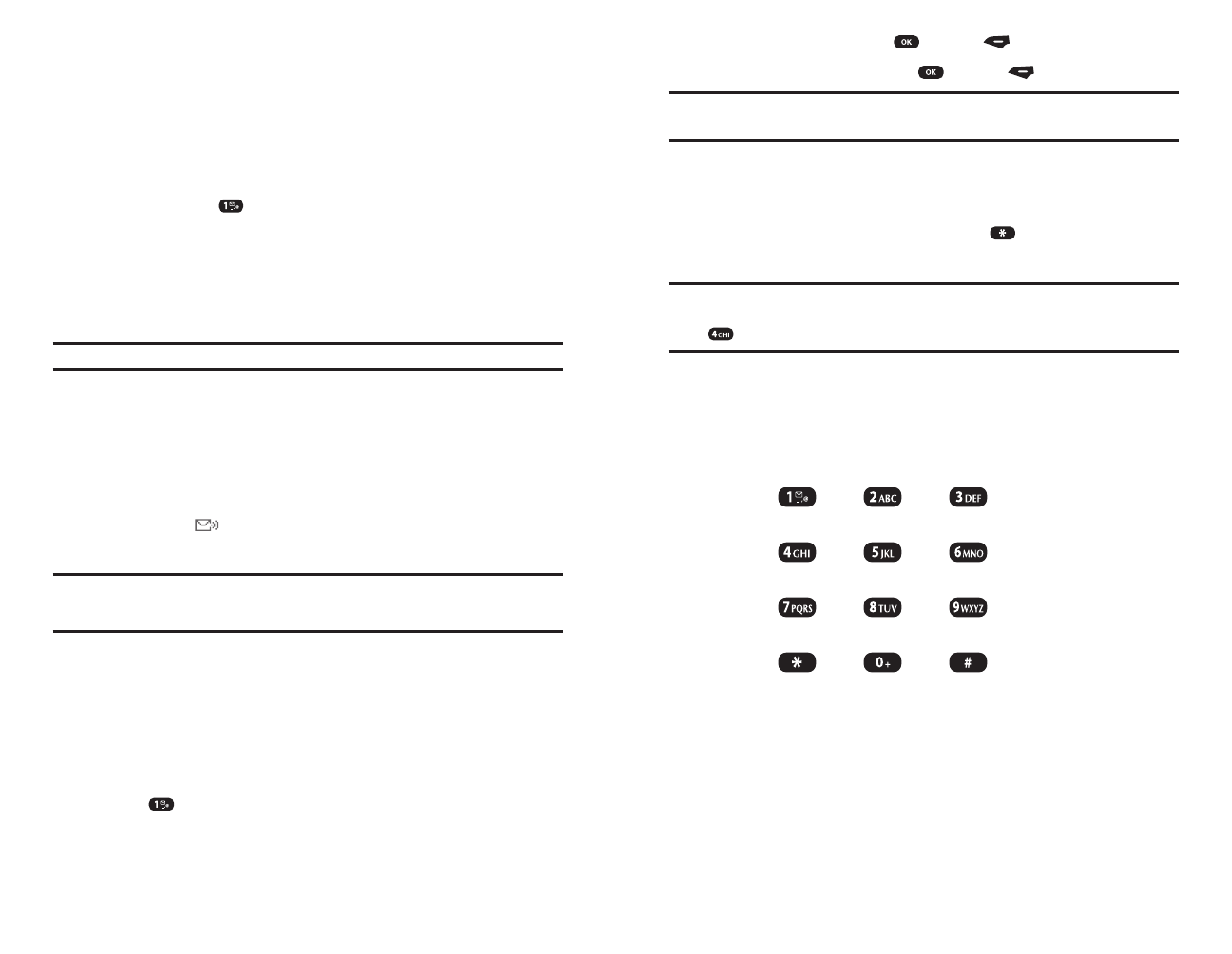
1. Press (Menu) to access the main menu.
2. Select Voice Mail,press (OK) or (Select).
3. Select Call Voicemail,press (OK) or (Select).
Note: You are charged for airtime minutes when you are accessing your
voicemail from your PCS Phone.
Using a Phone Other Than Your PCS Phone to Access Messages:
1. Dial your PCS Phone Number.
2. When your voicemail answers,press .
3. Enter your pass code.
Tip: When you call into voicemail you first hear the header information (date,
time, and sender information) for the message.To skip directly to the message,
press during the header.
Voicemail Button Guide
Here’s a quick guide to your keypad functions while listening to
voicemail messages.For further details and menu options,see
“Voicemail Menu Key”on page 109.
Date/Time Send Reply Advance
Replay Rewind Forward
Erase Call Back Save
Voicemail Options
Your PCS Phone offers several options for organizing and accessing
your voicemail.
Using Expert Mode
Using the Expert Mode setting for your personal voicemail box helps
you navigate through the voicemail system more quickly by
shortening the voice prompts you hear at each level.
Section 3: Using PCS Service Features
3A: PCS Service Features – The Basics 105
Section 3: Using PCS Service Features
3A: PCS Service Features – The Basics 104
Using Voicemail
Setting Up Your Voicemail
All unanswered calls to your PCS Phone are automatically transferred
to voicemail,even if your phone is in use or turned off.Therefore,you
will want to set up your PCS Voicemail and personal greeting as soon
as your PCS Phone is activated.
To set up voicemail:
1. Press and hold .
2. Follow the system prompts to create your pass code,record
your greeting,record your name announcement,and choose
whether to activate One-Touch Message Access (a feature that
lets you press one key to access messages and bypasses the
need for you to enter your pass code).
Note: The voicemail setup process may vary in certain Affiliate areas.
Voicemail Notification
There are several ways your PCS Phone alerts you:
By displaying a message on the screen.
By sounding the assigned ringer type.
By the LED blinking red.
By displaying at the top of your screen for voicemail
messages.
Note: Your phone accepts messages even when it is turned off. However, you
are only notified of new messages when your phone is turned on and you are
in a PCS Service Area.
Retrieving Your Voicemail Messages
You can review your messages directly from your PCS Phone or from
any other touch-tone phone.To dial from your PCS Phone,you can
either speed dial your voicemail or use the menu keys.
Using One-Touch Message Access:
Press .Follow the system prompts.
Using the Menu Keys on Your PCS Phone to Access Your Messages:
SPRINT-motorola8/27 2003.8.27 2:17 PM Page 104

Voicemail-to-Voicemail Message Reply
Reply to a voice message received from any other PCS Voicemail user.
1. After listening to a voice message,press .
2. Follow the voice prompts to record and send your reply.
Voicemail-to-Voicemail Message Forwarding
Forward a voice message,except those marked “Private,”to other PCS
Voicemail users.
1. After listening to a message,press .
2. Follow the voice prompts to enter the phone number.
3. Follow the voice prompts to record your introduction and
forward the voice message.
Voicemail-to-Voicemail Receipt Request
Receive confirmation that your voice message has been
listened to when you send,forward,or reply to other PCS users.
1. After you have recorded a message,press to indicate
you are satisfied with the message you recorded.
2. Press to mark receipt requested.
3. Press to send your voicemail message.
Continue Recording
Before pressing to indicate you are satisfied with the
message you recorded,press to continue recording.
Extended Absence Greeting
When your phone is turned off or you are off the enhanced Sprint
Nationwide PCS Network for an extended period,this greeting can
be played instead of your normal personal greeting.
1. From the main voicemail menu,press for
Personal Options.
2. Press for Greetings.
3. Press to record an Extended Absence Greeting.
Section 3: Using PCS Service Features
3A: PCS Service Features – The Basics 107
To turn Expert Mode on or off:
1. Press and hold to access your voicemail.If your voicemail
box contains any new or saved messages,press to access
the main voicemail menu.
2. Following the system prompts,press to change your
Personal Options.
3. Press for Expert Mode.
4. Press to turn Expert Mode on or off.
Setting Up Group Distribution Lists
Create up to 20 separate group lists,each with up to 50 customers.
1. Press and hold to access your voicemail.If your voicemail
box contains any new or saved messages,
press to access the main voicemail menu.
2. Following the system prompts,press to change your
Personal Options.
3. Press for Administrative Options.
4. Press for Group Distribution Lists.
5. Follow the voice prompts to create,edit,rename,or delete
group lists.
PCS Callback
Return a call after listening to a message without disconnecting
from voicemail.
1. After listening to a message,press .
2. Once the call is complete,you’re returned to the voicemail main
menu.
Voicemail-to-Voicemail Message
Record and send a voice message to other PCS Voicemail users.
1. From the main voicemail menu,press to send a message.
2. Follow the voice prompts to enter the phone number.
3. Follow the voice prompts to record and send your voice
message.
Section 3: Using PCS Service Features
3A: PCS Service Features – The Basics 106
SPRINT-motorola8/27 2003.8.27 2:17 PM Page 106

Voicemail Menu Key
Listen
Envelope Information
Reply
Advance 8 Seconds
Replay
Rewind
Forward Message
Erase
Callback
Save
Options
Send a Message
Personal Options
Notification Options
Phone Notification
Numeric Paging to a PCS Phone
Return to Personal Options Menu
Administrative Options
Skip Passcode
Autoplay
Message Date & Time On/Off
Change Passcode
Group Distribution List
Return to Personal Options Menu
Greetings
Personal Greetings
Name Announcement
Extended Absence Greeting
Return to Personal Options Menu
Expert Mode
Place a Call
Disconnect
Section 3: Using PCS Service Features
3A: PCS Service Features – The Basics 109
Clearing the Message Icon
Your phone may temporarily continue to display the message icon
after you have checked your voice and text messages.
To clear the icon from the display screen:
1. Press (Menu) to access the main menu.
2. Select Voice Mail,press (OK) or (Select).
3. Select Clear Icon,press (OK) or (Select).
4. Select “Yes”or “No”with the Navigation key.
5. To save,press (OK) or (Yes).
Section 3: Using PCS Service Features
3A: PCS Service Features – The Basics 108
SPRINT-motorola8/27 2003.8.27 2:17 PM Page 108
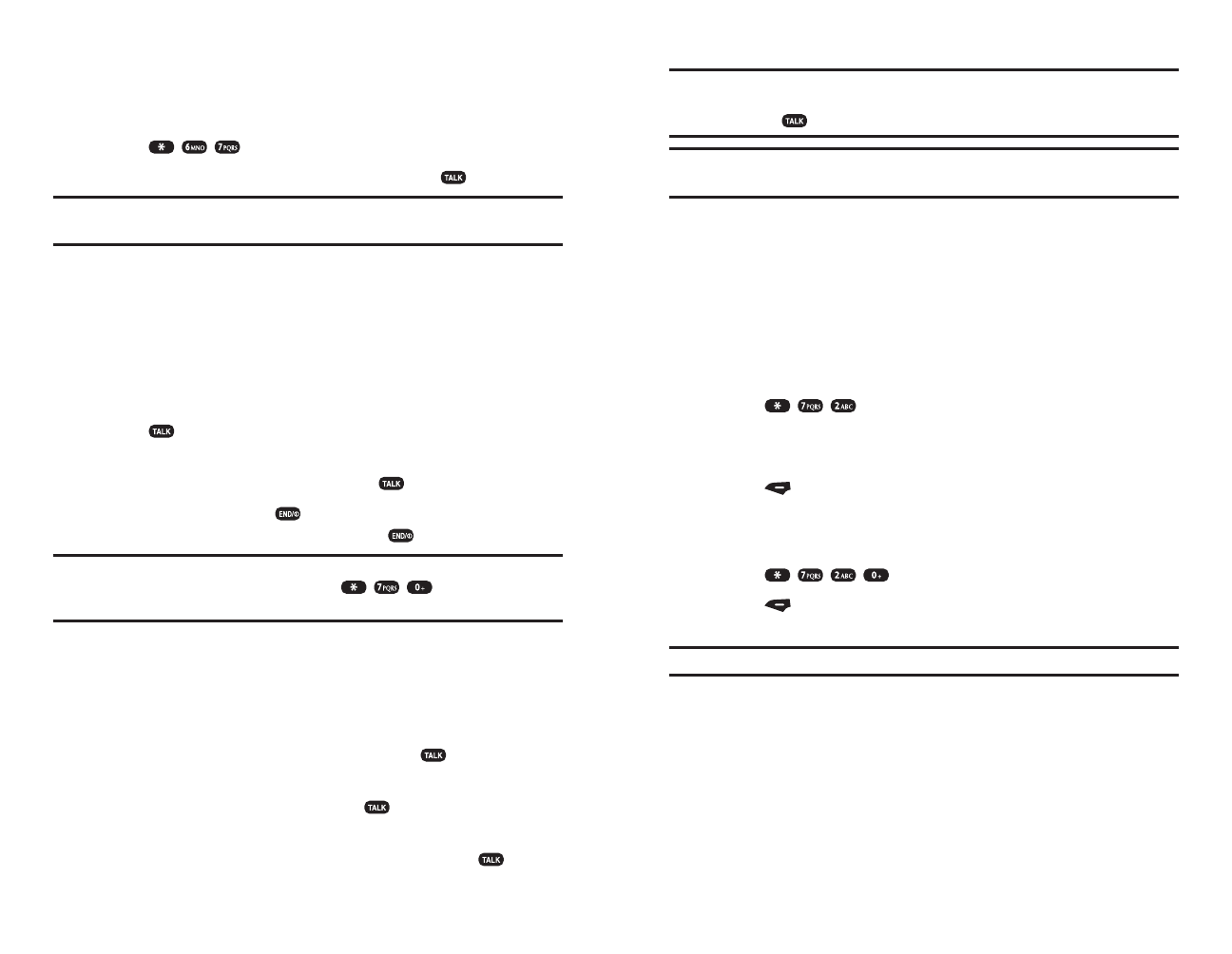
If one of the people you called hangs up during your call,you and
the remaining caller stay connected.If you initiated the call and
are the first to hang up,all three callers are disconnected.
Tip: You can also begin a Three-Way Call by displaying a phone number
stored in your Internal Phone Book, Call History, or Messaging. To call the
third party, press .
Note: Call Waiting and Three-Way Calling are not available while roaming off
the enhanced Sprint Nationwide PCS Network.
Using Call Forwarding
Call Forwarding lets you forward all your incoming calls to another
phone number – even when your phone is turned off.
You can continue to make calls from your phone when Call
Forwarding is activated.
To Activate Call Forwarding
1. Press .
2. Enter the area code and phone number to which your future
calls should be forwarded.
3. Press .You will see a message and hear a tone to confirm the
activation of Call Forwarding.
To Deactivate Call Forwarding
1. Press .
2. Press .You will see a message and hear a tone to confirm the
deactivation.
Note: You are charged a higher rate for calls you have forwarded.
Section 3: Using PCS Service Features
3A: PCS Service Features – The Basics 111
Section 3: Using PCS Service Features
3A: PCS Service Features – The Basics 110
Using Caller ID
Caller ID lets people know who’s calling by displaying the number of
the person calling.
To block your phone number from being displayed for a specific
outgoing call:
1. Press .
2. Enter the number you want to call,and press .
Note: To permanently block your number, call Sprint PCS Customer Service
Solutions.
Responding to Call Waiting
When you’re on a call,Call Waiting alerts you to incoming calls by
sounding two beeps.Your phone’s screen informs you that another
call is coming in and displays the caller’s phone number (if it is
available and you are in digital mode).
To respond to an incoming call while you ’re on a call:
Press to put the first caller on hold and answer the second
call.
To switch back to the first caller,press again.
To end both calls,press to end the first call,wait for the
second call to ring you back,then press again.
Tip: For those calls where you don’t want to be interrupted, you can
temporarily disable Call Waiting by pressing before placing
your call. Call Waiting is automatically reactivated once you end the call.
Making a Three-Way Call
With Three-Way Calling,you can talk to two people at the same
time.When using this feature,the normal airtime rates will be
charged for each of the two calls.
1. Enter a number you wish to call and press .
2. Once you have established the connection,enter the second
number you wish to call and press .This puts the first
caller on hold and dials the second number.
3. When you’re connected to the second party,press again
to begin your three-way call.
SPRINT-motorola8/27 2003.8.27 2:17 PM Page 110

Section 3B
PCS VisionSM
In This Section
Messaging
PCS Business ConnectionSMPersonal Edition
PCS VisionSM brings you clarity you can see and hear with always-on,
advanced multimedia services.These features,including,are easy to
learn and use and the rich,colorful graphic experience is visually
comparable to your home or office computer.Clearly,it’s a whole new
way to look at wireless.
Section 3: Using PCS Service Features
3B: PCS Vision 113
Section 3: Using PCS Service Features
3A: PCS Service Features – The Basics 112
SPRINT-motorola8/27 2003.8.27 2:17 PM Page 112
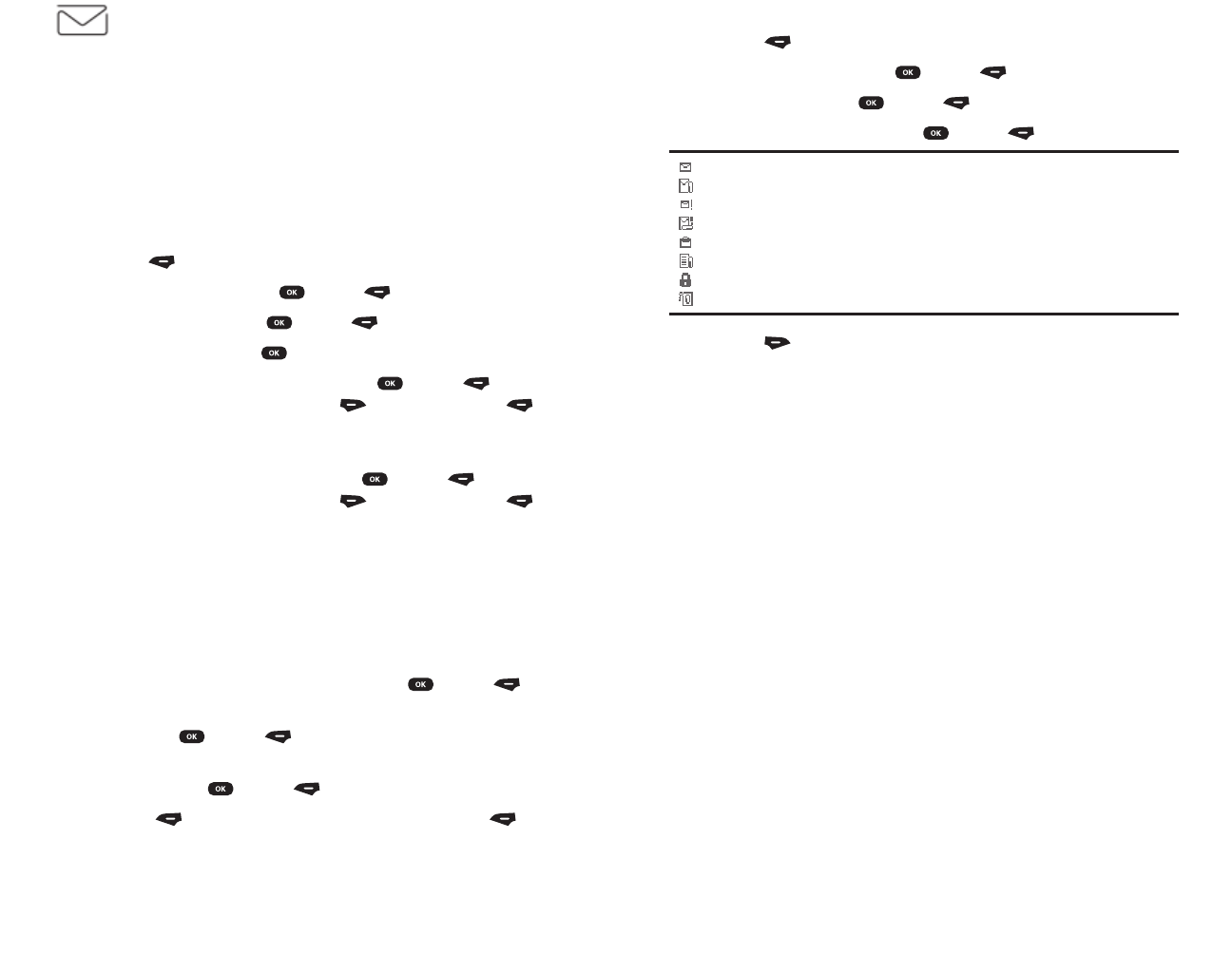
Section 3: Using PCS Service Features
3B: PCS Vision 115
Messaging
Now you can send and receive email and text messages and
participate in Web-based chatrooms right from your PCS Phone.
Messaging allows you to stay connected to friends,family,and
co-workers 24 hours a day with always-on text capabilities anywhere
on the enhanced Sprint Nationwide PCS Network.(PCS Voicemail
provides voicemail-to-mailbox messaging.For information on using
your phone’s voicemail feature,see “Using Voicemail”on page 90)
Compose
1. Press (Menu) to access the main menu.
2. Select Messaging,press (OK) or (Select).
3. Select Compose,press (OK) or (Select).
4. To select “To:”,press (OK).
5. Input a new phone number and press (OK) or (OK).
To change the input mode,press (Options) and Press
(Browse) search the phone number from “Phonebook”,
“Incoming Calls”,“Outgoing Calls”or “Missed Calls”.
6. Input a new text message and press (OK) or (OK).
To change the input mode,press (Options) and Press
(Browse) search the message from “Quicknotes”.
Quickotes :Crazy 4 you / Party / Anniversary / Too funny! /
Hugs and kisses - OK.../ I love you! / Tag,you’r it! / What time
does it .../ I’ll be there at / I’m on a conference.../ I have to
work late./ The meeting has be.../ I sent this from my.../ Let’s
get lunch./ Meet me at / Thanks! / Can you pick up / Don’t
forget to / Where are you? / Call me.
7. Input a default callback number and press (OK) or (OK).
8. Select the priority (Normal/Urgent) by using the navigation key
and press (OK) or (Select).
9. Select the Delivery Receipt (On/Off) by using the navigation
key and press (OK) or (Select).
10. Press (Done) and to send the text message select (Yes).
Section 3: Using PCS Service Features
3B: PCS Vision 114
Inbox
1. Press (Menu) to access the main menu.
2. Select Messaging,press (OK) or (Select).
3. Select Inbox,press (OK) or (Select).
4. Select a message and press (OK) or (Select).
: Unread
: Unread (with attachment)
: Unread and urgent
: Unread and urgent (with attachment)
: Read
: Read (with attachment)
: Read and Locked
: Read and Locked (with attachment)
5. Press (Options) to select inbox menu
Create Message
1.
Open a new text message.
Call Back
1.
Call the number in the message header or embedded in the
message.
Go To
1.
Launch the micro-browser and go to a Web address (URL)
embedded in the message.
Reply
1.
Open a new text message,with the sender’s Reply To number or
email address in the To field.
Forward
1.
Open a copy of the text message,with an empty To field.
Play
1.
Play a sound file in the message.
Lock/Unlock
1.
Lock or unlock the message.
SPRINT-motorola8/27 2003.8.27 2:17 PM Page 114
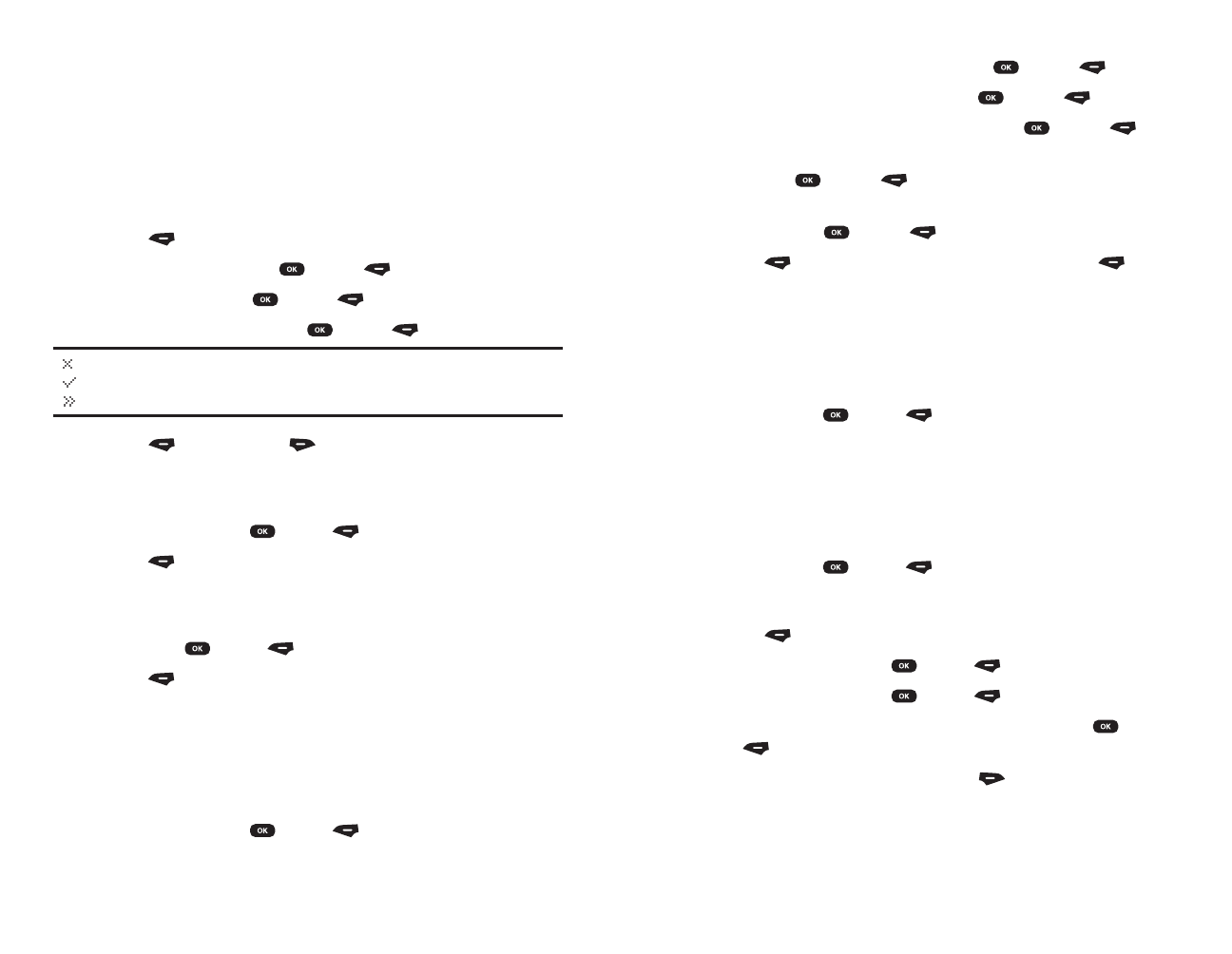
Compose New
To send a message to another person.
1. Input a new phone number and press (OK) or (OK).
2. Input a new text message and press (OK) or (OK).
3. Input a default callback number and press (OK) or (OK).
4. Select the priority (Normal/Urgent) by using the navigation key
and press (OK) or (Select).
5. Select the Delivery Receipt (On/Off) by using the navigation
key and press (OK) or (Select).
6. Press (Done) and to send the text message select (Yes).
Delete
To delete a text message.
1.
When you see “Delete Message?”
.
2. Select “Yes”or “No”with the Navigation key.
3. To save,press (OK) or (Yes).
Delete All
To delete all text messages.
1.
When you see “Delete All Messages?”
.
2. Select “Yes”or “No”with the Navigation key.
3. To save,press (OK) or (Yes).
Sent Folder
1. Press (Menu) to access the main menu.
2. Select Messaging,press (OK) or (Select).
3. Select Sent Folder,press (OK) or (Select).
4. Select a text message using the navigation key.Press (OK)
or (Select).
5. The text message is displayed,press (Options) to select
menu.
6. If the text message is saved from the “Inbox”menu,this screen
will be displayed.If the text message is saved from the “Outbox”
menu,this screen will be displayed.
Section 3: Using PCS Service Features
3B: PCS Vision 117
Delete
1.
Delete the message.
Delete All
1.
Delete all inbox messages.
Inbox Setup
1.
Open the text message inbox setup menu.
Outbox
1. Press (Menu) to access the main menu.
2. Select Messaging,press (OK) or (Select).
3. Select Outbox,press (OK) or (Select).
4. Select a message and press (OK) or (Select).
: Sending failed
: Outbos Sent
: Sending in progress
5. Press (FWD) or press (Options) to select outbox menu.
Forward
1.
Enter the phone number of the person you are sending the
message,then press
(OK) or (OK).
2.
Press
(Done).
Edit
1.
Enter any text message to go along with the forwarded message,
then press
(OK) or (OK).
2.
Press
(Done).
Send
1.
To resend the text message
.
Lock/Unlock
1.
Select “Lock”to lock the message or “Unlock”to unlock the
message,then press
(OK) or (Select).
Section 3: Using PCS Service Features
3B: PCS Vision 116
SPRINT-motorola8/27 2003.8.27 2:17 PM Page 116

1.
Edit the quick note text and
press (OK) or (OK) to save
your changes.
Send
1.
Open a new message,with the selected quick note text in the
Msg field.
2.
Complete the other fields in the message.
3.
To send the quick note to multiple recipients,enter multiple
phone numbers in the To field as described in step 2 of the
procedure for “Sending a Text Message”.
Delete
1.
Delete the selected quick note.
Settings
1. Press (Menu) to access the main menu.
2. Select Messaging,press (OK) or (Select).
3. Select Settings,press (OK) or (Select).
Display Pop-up
1. Select “On”or “Off”with the Navigation key.
2. To save,press (OK) or (Select).
Delivery Receipt
1. Select “On”or “Off”with the Navigation key.
2. To save,press (OK) or (Select).
Overwrite
1. Select “On”or “Off”with the Navigation key.
2. To save,press (OK) or (Select).
Messaging Alerts
1. Select “Once”,“Repeat”or “Off”with the Navigation key.
2. To save,press (OK) or (Select).
Delete All Messages
1.
When you see “Delete All Messages?”
.
Section 3: Using PCS Service Features
3B: PCS Vision 119
7. Press (OK) or (Select).
Drafts Folder
1. Press (Menu) to access the main menu.
2. Select Messaging,press (OK) or (Select).
3. Select Drafts Folder,press (OK) or (Select).
4. Select a text message using the navigation key.Press (OK)
or (Select).
5. The text message is displayed,press (Options) to select
menu.
6. If the text message is saved from the “Inbox”menu,this screen
will be displayed.
If the text message is saved from the “Outbox”menu,this screen
will be displayed.
7. Press (OK) or (Select).
Quick Notes
Quick notes are short,pre-written text messages that you can select,
edit,and send quickly (for example,Meet me at ...).You can also
create new quick note messages and store them for later use.
1. Press (Menu) to access the main menu.
2. Select Messaging,press (OK) or (Select).
3. Select Quick Notes,press (OK) or (Select).
4. Select a
quick note text
using the navigation key.Press (OK)
or (Edit).
5. Enter new
quick note text
,press (OK) or (OK).
6. Press (Options) to quick notes menu.
Add New
Open an editor where you can create a new quick note.
1. Enter new
quick note text
,press (OK) or (OK) to save
it.
Edit
Open an editor where you can edit the selected quick note.
Section 3: Using PCS Service Features
3B: PCS Vision 118
SPRINT-motorola8/27 2003.8.27 2:17 PM Page 118

Section 3C
PCS Voice CommandSM
In This Section
Getting Started with PCS Voice CommandSM
Creating Your Own Address Book
Making a Call with PCS Voice Command
With Sprint,the first wireless provider to offer innovative
PCS Voice Command technology,reaching your friends,family,and co-
workers has never been easier – especially when you’re on the go.Your
voice does it all with PCS Voice Command.
Section 3: Using PCS Service Features
3C: PCS Voice Command 121
2. Select “Yes”or “No”with the Navigation key.
3. To save,press (OK) or (Yes).
PCS Business ConnectionSM
Personal Edition
PCS Business ConnectionSM Personal Edition is designed to
offer secure wireless access to both Microsoft®Outlook®and Lotus
Notes®.
PCS Business Connection Personal Edition delivers the
following features:
Business email access:Read,reply to,forward,delete,and
compose your company email.
Company directory and contacts:Search,view,call,and email
contacts from your company's
directory.Do all this and add/edit
your personal contacts.
Work calendar: Accept and decline meetings,view daily
summaries and details,and navigate to various
dates.
Files/information on your PC:Browse folders,download,and view
documents from any device using a PC
browser or Pocket Internet Explorer.
To use PCS Business Connection Personal Edition,install PCS
Business Connection Personal Edition software on your work PC.This
allows data to be securely retrieved in real-time by your wireless
device when connected to the enhanced Sprint Nationwide PCS
Network.There is a monthly charge for PCS Business Connection and
usage charges will also apply.
When your work PC isn't on,you can share connections with your
co-workers so that you always have access to your email,calendar,
and contacts.Your data remains secure behind the corporate firewall
and any changes you make on your wireless device are instantly
updated on your company server without the need to synchronize.
Additional PCS Business Connection solutions are available for your
company.For more details,visit businessconnection.sprintpcs.com.
Section 3: Using PCS Service Features
3B: PCS Vision 120
SPRINT-motorola8/27 2003.8.27 2:17 PM Page 120

Call Directory Assistance: If you don’t have a computer or Internet
access handy,you can have PCS Directory Assistance look up
phone numbers for you and automatically add them to your
address book.Just say “Call operator”and we’ll add two names
and numbers to your address book for our standard directory
assistance charge.
Making a Call With PCS Voice Command
1. Once you’ve signed up for PCS Voice Command and created
your address book,all you do is press .
You’ll hear a tone followed by the prompt “Ready.”
2. After the “Ready”prompt,simply say in a natural voice
“Call”and the name of the person or the number you’d like to
call.For example,you can say,“Call Jane Smith at work,”
“Call John Baker on the mobile phone,”“Call 555-1234,”or
“Call Bob Miller.”
3. Your request will be repeated and you will be asked to verify.Say
“Yes”to call the number or person.Say “No”if you wish
to cancel.
4. The number will automatically be dialed.Keep in mind that PCS
Voice Command recognizes not only your voice,but any voice,
so that others can experience the same convenience if they use
your phone.
For more helpful hints on PCS Voice Command,including a list of
recognized commands and an interactive tutorial,visit
www.talk.sprintpcs.com.
Note: PCS Voice Command is not available while roaming off the enhanced
Sprint Nationwide PCS Network.
Getting Started With PCS Voice CommandTM
With PCS Voice Command:
You can store all your contacts’phone numbers,so you can simply
say the name of the person you want to call.
There’s no need to punch in a lot of numbers,memorizevoicemail
passwords,or try to dial while you’re driving.
You can call anyone in your address book – even if you don’t
remember their phone number.
It’s Easy to Get Started
Just dial from your PCS Phoneto activate the service
and listen to brief instructions directly from your phone.There
is a monthly charge for PCS Voice Command.
Creating Your Own Address Book
You can program up to 300 names into your personal address book
with each name having up to five phone numbers.That’s 1,500 phone
numbers – and with the advanced technology of PCS Voice
Command – you can have instant access to all of them.
There are four ways to update your address book:
Use Voice Recordings:Simply dial and say,“Add name.”You
will then be asked to say the name and number you want to add to
your personal address book.Your address book can store up to 20
voice recorded names at once.
On the Web: Go to www.talk.sprintpcs.comand receive a fully
functional Web-based address book to create and update
your contacts.
Use an Existing Address Book:Automatically merge address books
from desktop software applications with Sprint SyncSM Services for
no additional charge.Simply click on the “Click to synchronize”
button within your PCS Voice Command personal address book at
www.talk.sprintpcs.com.
Section 3: Using PCS Service Features
3C: PCS Voice Command 123
Section 3: Using PCS Service Features
3C: PCS Voice Command 122
SPRINT-motorola8/27 2003.8.27 2:17 PM Page 122

Safety Guidelines and
Warranty Information
Section 4
SPRINT-motorola8/27 2003.8.27 2:17 PM Page 124

Section 4A
Safety
In This Section
Getting the Most Out of Your Reception
Maintaining Safe Use of and Access to Your Phone
Caring for the Battery
Acknowledging Special Precautions and the FCC Notice
Consumer Information on Wireless Phones
Owner’s Record
User Guide Proprietary Notice
Part of getting the most out of your PCS Phone is learning how the
phone works and how to care for it.This section outlines
performance and safety guidelines that help you understand the basic
features of your phone’s operation.
Section 4: Safety Guidelines and Warranty Information
4A: Safety 127
SPRINT-motorola8/27 2003.8.27 2:17 PM Page 126

Maintaining Your Phone’s Peak Performance
There are several simple guidelines to operating your phone properly
and maintaining safe,satisfactory service.
Hold the phone with the antenna raised,fully-extended,and over
your shoulder.
Try not to hold,bend,or twist the phone’s antenna.
Don’t use the phone if the antenna is damaged.
Speak directly into the mouthpiece.
Avoid exposing your phone and accessories to rain or liquid
spills.If your phone does get wet,immediately turn the power off
and remove the battery.If it’s inoperable,return it to a SprintStore
or call PCS Customer Service SolutionsSM for service.
Note: For the best care of your phone, only Sprint authorized personnel
should service your phone and accessories. Faulty service may void
the warranty.
Maintaining Safe Use of and Access to
Your Phone
FAILURE TO FOLLOW THE INSTRUCTIONS OUTLINED MAY LEAD
TO SERIOUS PERSONAL INJURY AND POSSIBLE PROPERTY
DAMAGE
Using Your Phone While Driving
Talking on your phone while driving (or operating the phone
without a hands-free device) is prohibited in some jurisdictions.
Laws vary as to specific restrictions.Remember that safety always
comes first.
When using your phone in the car:
Get to know your phone and its features,such as speed dial
and redial.
When available,use a hands-free device.
Position your phone within easy reach.
Let the person you are speaking to know you are driving;
if necessary,suspend the call in heavy traffic or hazardous
weather conditions.
Do not take notes or look up phone numbers while driving.
Getting the Most Out of Your Reception
Keeping Tabs on Signal Strength
The quality of each call you make or receive depends on the signal
strength in your area.Your phone informs you of the current signal
strength by displaying a number of bars next to the signal strength
icon.The more bars displayed,the stronger the signal.If you’re inside
a building,being near a window may give you better reception.
Understanding the Power Save Feature
If your phone is unable to find a signal after 15 minutes of searching,a
Power Save feature is automatically activated.If your phone is active,it
periodically rechecks service availability or you can check it yourself
by pressing any key.Anytime the Power Save feature is activated,a
message displays on the screen.When a signal is found,your phone
returns to standby mode.
Understanding How Your Phone Operates
Your phone is basically a radio transmitter and receiver.When it’s
turned on,it receives and transmits radiofrequency (RF) signals.
When you use your phone,the system handling your call controls the
power level.This power can range from 0.006 watts to 0.2 watts in
digital mode.
Knowing Radiofrequency Safety
The design of your PCS Phone complies with updated NCRP
standards described below.
In 1991-92,the Institute of Electrical and Electronics Engineers (IEEE)
and the American National Standards Institute (ANSI) joined in
updating ANSI’s 1982 standard for safety levels with respect to
human exposure to RF signals.More than 120 scientists,engineers
and physicians from universities,government health agencies and
industries developed this updated standard after reviewing the
available body of research.In 1993,the Federal Communications
Commission (FCC) adopted this updated standard in a regulation.In
August 1996,the FCC adopted hybrid standard consisting of the
existing ANSI/IEEE standard and the guidelines published by the
National Council of Radiation Protection and Measurements (NCRP).
Section 4: Safety Guidelines and Warranty Information
4A: Safety 129
Section 4: Safety Guidelines and Warranty Information
4A: Safety 128
SPRINT-motorola8/27 2003.8.27 2:17 PM Page 128
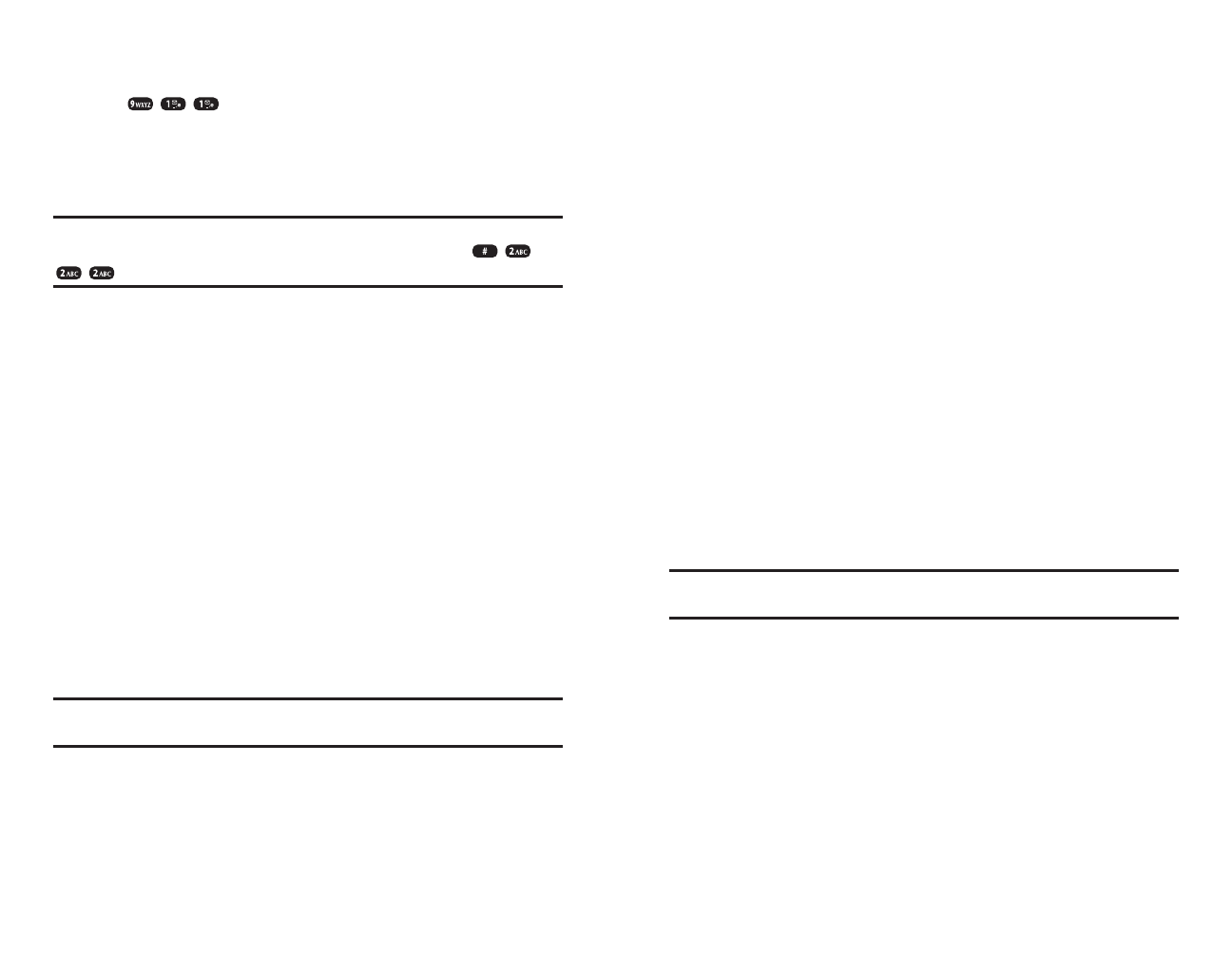
Turning Off Your Phone Before Flying
Turn off your phone before boarding any aircraft.To prevent possible
interference with aircraft systems,the U.S.Federal Aviation
Administration (FAA) regulations require you to have permission
from a crew member to use your phone while the plane is on the
ground.To prevent any risk of interference,FCC regulations prohibit
using your phone while the plane is in the air.
Turning Off Your Phone in Dangerous Areas
To avoid interfering with blasting operations,turn off your phone
when in a blasting area or in other areas with signs indicating that
two-way radios should be turned off.Construction crews often use
remote-control RF devices to set off explosives.
Turn off your phone when you’re in any area that has a potentially
explosive atmosphere.Although it’s rare,your phone or its
accessories could generate sparks.Sparks could cause an explosion
or a fire resulting in bodily injury or even death.These areas are often,
but not always,clearly marked.They include:
Fueling areas such as gas stations.
Below deck on boats.
Fuel or chemical transfer or storage facilities.
Areas where the air contains chemicals or particles such as grain,
dust or metal powders.
Any other area where you would normally be advised to turn off
your vehicle’s engine.
Note: Never transport or store flammable gas, liquid, or explosives in the
compartment of your vehicle that contains your phone or accessories.
Restricting Children’s Access to your Phone
Your PCS Phone is not a toy.Children should not be allowed to play
with it because they could hurt themselves and others,damage the
phone or make calls that increase your phone bill.
Dial sensibly and assess the traffic;if possible,place calls when
stationary or before pulling into traffic.
Do not engage in stressful or emotional conversations that may
divert your attention from the road.
Dial to report serious emergencies.It’s free from
your wireless phone.
Use your phone to help others in emergencies.
Call roadside assistance or a special non-emergency wireless
number when necessary.
Tip:Purchase an optional hands-free car kit at your local Sprint Store. You may
also call the PCS Accessory Hotline at 1-800-974-2221 or by dialing
on your PCS Phone.
Following Safety Guidelines
To operate your phone safely and efficiently,always follow any
special regulations in a given area.Turn your phone off in areas
where use is forbidden or when it may cause interference or danger.
Using Your Phone Near Other Electronic Devices
Most modern electronic equipment is shielded from radiofrequency
(RF) signals.However,RF signals from wireless phones may affect
inadequately shielded electronic equipment.
RF signals may affect improperly installed or inadequately shielded
electronic operating systems and/or entertainment systems in motor
vehicles.Check with the manufacturer or their representative to
determine if these systems are adequately shielded from external RF
signals.Also check with the manufacturer regarding any equipment
that has been added to your vehicle.
Consult the manufacturer of any personal medical devices,such as
pacemakers and hearing aids,to determine if they are adequately
shielded from external RF signals.
Note: Always turn off the phone in health care facilities and request
permission before using the phone near medical equipment.
Section 4: Safety Guidelines and Warranty Information
4A: Safety 131
Section 4: Safety Guidelines and Warranty Information
4A: Safety 130
SPRINT-motorola8/27 2003.8.27 2:17 PM Page 130

Acknowledging Special Precautions and the FCC
Notice
FCC Notice
The phone may cause TV or radio interference if used in close
proximity to receiving equipment.The FCC can require you to stop
using the phone if such interference cannot be eliminated.
Vehicles using liquefied petroleum gas (such as propane or butane)
must comply with the National Fire Protection Standard (NFPA-58).
For a copy of this standard,contact the National Fire Protection
Association,One Batterymarch Park,Quincy,MA 02269,Attn:
Publication Sales Division.
Cautions
Any changes or modifications to your phone not expressly approved
in this document could void your warranty for this equipment,and
void your authority to operate this equipment.Only use approved
batteries,antennas and chargers.The use of any unauthorized
accessories may be dangerous and void the phone warranty if said
accessories cause damage or a defect to the phone.
Although your phone is quite sturdy,it is a complex piece of
equipment and can be broken.Avoid dropping,hitting,bending or
sitting on it.
Body-Worn Operation
To maintain compliance with FCC RF exposure guidelines,if you
wear a handset on your body,use the Sprint supplied or approved
carrying case,holster or other body-worn accessory.If you do not use
a body-worn accessory,ensure that the antenna is at least 7/16 inch
(1.5 centimeters) from your body when transmitting.Use of non-
Sprint approved accessories may violate FCC RF exposure guidelines.
For more information about RF exposure,please visit the FCC Web site
at
www.fcc.gov
.
Caring for the Battery
Protecting Your Battery
The guidelines listed below help you get the most out of your
battery’s performance.
Use only Sprint-approved batteries and desktop chargers.
These chargers are designed to maximize battery life.
Using other batteries or chargers voids your warranty and may
cause damage.
In order to avoid damage,charge the battery only in temperatures
that range from 32º F to 113º F (0º C to 45º C).
Don’t use the battery charger in direct sunlight or in high
humidity areas,such as the bathroom.
Never dispose of the battery by incineration.
Keep the metal contacts on top of the battery clean.
Don’t attempt to disassemble or short-circuit the battery.
The battery may need recharging if it has not been used for a long
period of time.
It’s best to replace the battery when it no longer provides
acceptable performance.It can be recharged hundreds of times
before it needs replacing.
Don’t store the battery in high temperature areas for long periods
of time.It’s best to follow these storage rules:
Less than one month:
4º F to 140º F (-20º C to 60º C)
More than one month:
4º F to 113º F (-20º C to 45º C)
Disposal of Lithium Ion (Li-Ion) Batteries
For safe disposal options of your Li-Ion batteries,contact your nearest
Sprint-authorized service center.
Special Note: Be sure to dispose of your battery properly.In some
areas,the disposal of batteries in household or business trash may be
prohibited.
Note: For safety, do not handle a damaged or leaking Li-Ion battery.
Section 4: Safety Guidelines and Warranty Information
4A: Safety 133
Section 4: Safety Guidelines and Warranty Information
4A: Safety 132
SPRINT-motorola8/27 2003.8.27 2:17 PM Page 132

Consumer Information on Wireless Phones
(The following information comes from a consumer information
Web site jointly sponsored by the U.S.Food and Drug Administration
(FDA) and the Federal Communications Commission (FCC),entitled
“Cell Phone Facts:Consumer Information on Wireless Phones.”The
information reproduced herein is dated April 3,2002.For further
updates,please visit the Web site:http://www.fda.gov/cellphones/.)
1. What is radiofrequency energy (RF)?
Radiofrequency (RF) energy is another name for radio waves.It is one
form of electromagnetic energy that makes up the electromagnetic
spectrum.Some of the other forms of energy in the electromagnetic
spectrum are gamma rays,x-rays and light.Electromagnetic energy
(or electromagnetic radiation) consists of waves of electric and
magnetic energy moving together (radiating) through space.The area
where these waves are found is called an electromagnetic field.
Radio waves are created due to the movement of electrical charges in
antennas.As they are created,these waves radiate away from the
antenna.All electromagnetic waves travel at the speed of light.The
major differences between the different types of waves are the
distances covered by one cycle of the wave and the number of waves
that pass a certain point during a set time period.The wavelength is
the distance covered by one cycle of a wave.The frequency is the
number of waves passing a given point in one second.For any
electromagnetic wave,the wavelength multiplied by the frequency
equals the speed of light.The frequency of an RF signal is usually
expressed in units called hertz (Hz).One Hz equals one wave per
second.One kilohertz (kHz) equals one thousand waves per second,
one megahertz (MHz) equals one million waves per second,and one
gigahertz (GHz) equals one billion waves per second.
RF energy includes waves with frequencies ranging from about 3000
waves per second (3 kHz) to 300 billion waves per second (300 GHz).
Microwaves are a subset of radio waves that have frequencies ranging
from around 300 million waves per second (300 MHz) to three billion
waves per second (3 GHz).
Specific Absorption Rates (SAR) for Wireless Phones
The SAR is a value that corresponds to the relative amount of RF
energy absorbed in the head of a user of a wireless handset.
The SAR value of a phone is the result of an extensive testing,
measuring and calculation process.It does not represent how much
RF the phone emits.All phone models are tested at their highest value
in strict laboratory settings.But when in operation,the SAR of a
phone can be substantially less than the level reported to the FCC.
This is because of a variety of factors including its proximity to a base
station antenna,phone design and other factors.What is important to
remember is that each phone meets strict federal guidelines.
Variations in SARs do not represent a variation in safety.
All phones must meet the federal standard,which incorporates a
substantial margin of safety.As stated above,variations in SAR values
between different model phones do not mean variations in safety.
SAR values at or below the federal standard of 1.6 W/kg are
considered safe for use by the public.
The highest reported SAR values of the [model xx]are:
AMPS mode (Part 22) - Head:[x.xx]W/kg;Body-worn:[x.xx]W/kg
PCS mode (Part 24) - Head:[x.xx]W/kg;Body-worn:[x.xx]W/kg
FCC Radiofrequency Emission
This phone meets the FCC Radiofrequency Emission Guidelines.FCC
ID number:[manufacturer needs to provide #].More information on the
phone's SAR can be found from the following FCC Web site:
http://www.fcc.gov/oet/fccid.
Section 4: Safety Guidelines and Warranty Information
4A: Safety 135
Section 4: Safety Guidelines and Warranty Information
4A: Safety 134
SPRINT-motorola8/27 2003.8.27 2:17 PM Page 134

including DNA,the genetic material.Ionization only occurs with very
high levels of electromagnetic energy such as X-rays and gamma rays.
Often the term radiation is used when discussing ionizing radiation
(such as that associated with nuclear power plants).
The energy levels associated with radiofrequency energy,including
both radio waves and microwaves,are not great enough to cause the
ionization of atoms and molecules.Therefore,RF energy is a type of
non-ionizing radiation.Other types of non-ionizing radiation include
visible light,infrared radiation (heat) and other forms of
electromagnetic radiation with relatively low frequencies.
Large amounts of RF energy can heat tissue.This can damage tissues
and increase body temperatures.Two areas of the body,the eyes and
the testes,are particularly vulnerable to RF heating because there is
relatively little blood flow in them to carry away excess heat.
The amount of RF radiation routinely encountered by the general
public is too low to produce significant heating or increased body
temperature.Still,some people have questions about the possible
health effects of low levels of RF energy.It is generally agreed that
further research is needed to determine what effects actually occur
and whether they are dangerous to people.In the meantime,
standards-setting organizations and government agencies are
continuing to monitor the latest scientific findings to determine
whether changes in safety limits are needed to protect human health.
FDA,EPA and other US government agencies responsible for public
health and safety have worked together and in connection with WHO
to monitor developments and identify research needs related to RF
biological effects.
5. What levels of RF energy are considered safe?
Various organizations and countries have developed standards for
exposure to radiofrequency energy.These standards recommend safe
levels of exposure for both the general public and for workers.In the
United States,the FCC has used safety guidelines for RF
environmental exposure since 1985.
The FCC guidelines for human exposure to RF electromagnetic fields
are derived from the recommendations of two expert organizations,
the National Council on Radiation Protection and Measurements
(NCRP) and the Institute of Electrical and Electronics Engineers
(IEEE).In both cases,the recommendations were developed by
scientific and engineering experts drawn from industry,government,
2. How is radiofrequency energy used?
Probably the most important use of RF energy is for
telecommunications.Radio and TV broadcasting,wireless phones,
pagers,cordless phones,police and fire department radios,point-to-
point links and satellite communications all rely on RF energy.
Other uses of RF energy include microwave ovens,radar,industrial
heaters and sealers,and medical treatments.RF energy,especially at
microwave frequencies,can heat water.Since most food has a high
water content,microwaves can cook food quickly.Radar relies on RF
energy to track cars and airplanes as well as for military applications.
Industrial heaters and sealers use RF energy to mold plastic materials,
glue wood products,seal leather items such as shoes and
pocketbooks,and process food.Medical uses of RF energy include
pacemaker monitoring and programming.
3. How is radiofrequency radiation measured?
RF waves and RF fields have both electrical and magnetic
components.It is often convenient to express the strength of the RF
field in terms of each component.For example,the unit "volts per
meter" (V/m) is used to measure the electric field strength,and the
unit "amperes per meter" (A/m) is used to express the magnetic field
strength.Another common way to characterize an RF field is by
means of the power density.Power density is defined as power per
unit area.For example,power density can be expressed in terms of
milliwatts (one thousandth of a watt) per square centimeter
(mW/cm2 or microwatts (one millionth of a watt) per square
centimeter (µW/cm2).
The quantity used to measure how much RF energy is actually
absorbed by the body is called the Specific Absorption Rate or SAR.
The SAR is a measure of the rate of absorption of RF energy.It is
usually expressed in units of watts per kilogram (W/kg) or milliwatts
per gram (mW/g).
4. What biological effects can be caused by RF energy?
The biological effects of radiofrequency energy should not be
confused with the effects from other types of electromagnetic
energy.
Very high levels of electromagnetic energy,such as is found in X-rays
and gamma rays can ionize biological tissues.Ionization is a process
where electrons are stripped away from their normal locations in
atoms and molecules.It can permanently damage biological tissues
Section 4: Safety Guidelines and Warranty Information
4A: Safety 137
Section 4: Safety Guidelines and Warranty Information
4A: Safety 136
SPRINT-motorola8/27 2003.8.27 2:17 PM Page 136

Under the National Environmental Policy Act of 1969 (NEPA),the
FCC has certain responsibilities to consider whether its actions will
significantly affect the quality of the human environment.Therefore,
FCC approval and licensing of transmitters and facilities must be
evaluated for significant impact on the environment.Human
exposure to RF radiation emitted by FCC-regulated transmitters is
one of several factors that must be considered in such environmental
evaluations.In 1996,the FCC revised its guidelines for RF exposure as
a result of a multi-year proceeding and as required by the
Telecommunications Act of 1996.
Radio and television broadcast stations,satellite-earth stations,
experimental radio stations and certain wireless communication
facilities are required to undergo routine evaluation for RF
compliance when they submit an application to the FCC for
construction or modification of a transmitting facility or renewal of a
license.Failure to comply with the FCC's RF exposure guidelines
could lead to the preparation of a formal Environmental Assessment,
possible Environmental Impact Statement and eventual rejection of
an application.Technical guidelines for evaluating compliance with
the FCC RF safety requirements can be found in the FCC's OET
Bulletin 65.http://www.fcc.gov/oet/info/documents/bulletins/#65
Low-powered,intermittent,or inaccessible RF transmitters and
facilities are normally excluded from the requirement for routine
evaluation for RF exposure.These exclusions are based on standard
calculations and measurement data indicating that a transmitting
station or equipment operating under the conditions prescribed is
unlikely to cause exposures in excess of the guidelines under normal
conditions of use.Such exclusions are not exclusions from
compliance,but,rather,exclusions from routine evaluation.The FCC's
policies on RF exposure and categorical exclusion can be found in
Section 1.1307(b) of the FCC's Rules and Regulations [(47 CFR
1.1307(b)].
7. How can I obtain the Specific Absorption Rate (SAR) value for my
wireless phone?
The FCC requires that wireless phones sold in the United States
demonstrate compliance with human exposure limits adopted by the
FCC in 1996.The relative amount of RF energy absorbed in the head
of a wireless telephone-user is given by the Specific Absorption Rate
(SAR),as explained above.The FCC requires wireless phones to
comply with a safety limit of 1.6 watts per kilogram (1.6 W/kg) in
terms of SAR.
and academia after extensive reviews of the scientific literature
related to the biological effects of RF energy.
Many countries in Europe and elsewhere use exposure guidelines
developed by the International Commission on Non-Ionizing
Radiation Protection (ICNIRP).The ICNIRP safety limits are generally
similar to those of the NCRP and IEEE,with a few exceptions.For
example,ICNIRP recommends different exposure levels in the lower
and upper frequency ranges and for localized exposure from certain
products such as hand-held wireless telephones.Currently,the World
Health Organization is working to provide a framework for
international harmonization of RF safety standards.
The NCRP,IEEE,and ICNIRP all have identified a whole-body Specific
Absorption Rate (SAR) value of 4 watts per kilogram (4 W/kg) as a
threshold level of exposure at which harmful biological effects may
occur.Exposure guidelines in terms of field strength,power density
and localized SAR were then derived from this threshold value.In
addition,the NCRP,IEEE,and ICNIRP guidelines vary depending on
the frequency of the RF exposure.This is due to the finding that
whole-body human absorption of RF energy varies with the
frequency of the RF signal.The most restrictive limits on whole-body
exposure are in the frequency range of 30-300 MHz where the human
body absorbs RF energy most efficiently.For products that only
expose part of the body,such as wireless phones,exposure limits in
terms of SAR only are specified.
The exposure limits used by the FCC are expressed in terms of SAR,
electric and magnetic field strength,and power density for
transmitters operating at frequencies from 300 kHz to 100 GHz.The
specific values can be found in two FCC bulletins,OET Bulletins 56
and 65:http://www.fcc.gov/oet/info/documents/bulletins/#56;
http://www.fcc.gov/oet/info/documents/bulletins/#65
6. Why has the FCC adopted guidelines for RF exposure?
The FCC authorizes and licenses products,transmitters,and facilities
that generate RF and microwave radiation.It has jurisdiction over all
transmitting services in the U.S.except those specifically operated by
the Federal Government.While the FCC does not have the expertise
to determine radiation exposure guidelines on its own,it does have
the expertise and authority to recognize and adopt technically sound
standards promulgated by other expert agencies and organizations,
and has done so .(Our joint efforts with the FDA in developing this
website is illustrative of the kind of inter-agency efforts and
consultation we engage in regarding this health and safety issue.)
Section 4: Safety Guidelines and Warranty Information
4A: Safety 139
Section 4: Safety Guidelines and Warranty Information
4A: Safety 138
SPRINT-motorola8/27 2003.8.27 2:17 PM Page 138

emissions,will not be placed against the head.On the other hand,if
the phone is mounted against the waist or other part of the body
during use,then that part of the body will absorb more RF energy.
Wireless phones marketed in the U.S.are required to meet safety
requirements regardless of whether they are used against the head or
against the body.Either configuration should result in compliance
with the safety limit.
9. Do wireless phone accessories that claim to shield the head
from RF radiation work?
Since there are no known risks from exposure to RF emissions from
wireless phones,there is no reason to believe that accessories that
claim to shield the head from those emissions reduce risks.Some
products that claim to shield the user from RF absorption use special
phone cases,while others involve nothing more than a metallic
accessory attached to the phone.Studies have shown that these
products generally do not work as advertised.Unlike "hand-free" kits,
these so-called "shields" may interfere with proper operation of the
phone.The phone may be forced to boost its power to compensate,
leading to an increase in RF absorption.In February 2002,the Federal
trade Commission (FTC) charged two companies that sold devices
that claimed to protect wireless phone users from radiation with
making false and unsubstantiated claims.According to FTC,these
defendants lacked a reasonable basis to substantiate their claim.
10. What are wireless telephone base stations?
Fixed antennas used for wireless telecommunications are referred to
as cellular base stations,cell stations,PCS ("Personal Communications
Service") stations or telephone transmission towers.These base
stations consist of antennas and electronic equipment.Because the
antennas need to be high in the air,they are often located on towers,
poles,water tanks,or rooftops.Typical heights for freestanding base
station towers are 50-200 feet.
Some base stations use antennas that look like poles,10 to 15 feet in
length,that are referred to as "omni-directional" antennas.These types
of antennas are usually found in rural areas.In urban and suburban
areas,wireless providers now more commonly use panel or sector
antennas for their base stations.These antennas consist of rectangular
panels,about 1 by 4 feet in dimension.The antennas are usually
arranged in three groups of three antennas each.One antenna in each
group is used to transmit signals to wireless phones,and the other
Information on SAR for a specific phone model can be obtained for
many recently manufactured phones using the FCC identification
(ID) number for that model.The FCC ID number is usually printed
somewhere on the case of the phone.Sometimes it may be necessary
to remove the battery pack to find the number.Once you have the ID
number,go to the following Web address:www.fcc.gov/oet/fccid.On
this page,you will see instructions for entering the FCC ID number.
Type the FCC ID number exactly as requested (the Grantee Code is
the first three characters,the Equipment Product Code is the rest of
the FCC ID number).Then click on "Start Search." The "Grant of
Equipment Authorization" for your telephone should appear.Read
through the grant for the section on "SAR Compliance," "Certification
of Compliance with FCC Rules for RF Exposure" or similar language.
This section should contain the value(s) for typical or maximum SAR
for your phone.
Phones and other products authorized since June 2,2000,should
have the maximum SAR levels noted directly on the "Grant of
Equipment Authorization." For phones and products authorized
between about mid-1998 and June 2000,detailed information on SAR
levels is typically found in the exhibits associated with the grant.
Once a grant is accessed,the exhibits can be viewed by clicking on
"View Exhibit." Grants authorized prior to 1998 are not part of the
electronic database but,rather,have been documented in the form of
paper records.
The FCC database does not list phones by model number.However,
consumers may find SAR information from other sources as well.
Some wireless phone manufacturers make SAR information available
on their own Web sites.In addition,some non-government Web sites
provide SARs for specific models of wireless phones.However,the
FCC has not reviewed these sites and makes no guarantees of their
accuracy.Finally,phones certified by the Cellular
Telecommunications and Internet Association (CTIA) are required to
provide SAR information to consumers in the instructional materials
that come with the phones.
8. Do hands-free kits for wireless phones reduce risks from
exposure to RF emissions?
Since there are no known risks from exposure to RF emissions from
wireless phones,there is no reason to believe that hands-free kits
reduce risks.Hands-free kits can be used with wireless phones for
convenience and comfort.These systems reduce the absorption of RF
energy in the head because the phone,which is the source of the RF
Section 4: Safety Guidelines and Warranty Information
4A: Safety 141
Section 4: Safety Guidelines and Warranty Information
4A: Safety 140
SPRINT-motorola8/27 2003.8.27 2:17 PM Page 140

When cellular and PCS antennas are mounted on rooftops,RF levels
on that roof or on others near by would probably be greater than
those typically encountered on the ground.However,exposure levels
approaching or exceeding safety guidelines should be encountered
only very close to or directly in front of the antennas.In addition,for
sector-type antennas,typically used for such rooftop base stations,RF
levels to the side and in back of these antennas are insignificant.
General guidelines on antenna installations and circumstances that
might give rise to a concern about an facility's conformance with
FCC regulations can be found in A Local Government Official's Guide
to Transmitting Antenna RF Emission Safety:Rules,Procedures,and
Practical Guidance.This Guide can be accessed at:
http://www.fcc.gov/oet/rfsafety.
12. Who regulates exposure to radiation from microwave ovens,
television sets and computer monitors?
The Food and Drug Administration is responsible for protecting the
public from harmful radiation emissions from these consumer
products.
13. Does the FCC routinely monitor radiofrequency radiation from
antennas?
The FCC does not have the resources or the personnel to routinely
monitor the emissions for all the thousands of transmitters that are
subject to FCC jurisdiction.However,the FCC does have
measurement instrumentation for evaluating RF levels in areas that
may be accessible to the public or to workers.If there is evidence for
potential non-compliance with FCC exposure guidelines for a FCC-
regulated facility,staff from the FCC's Office of Engineering and
Technology or the FCC Enforcement Bureau can conduct and
investigation,and,if appropriate,perform actual measurements.
Circumstances that could give rise to a concern about an facility's
conformance with FCC regulations can be found in in A Local
Government Official's Guide to Transmitting Antenna RF Emission
Safety:Rules,Procedures,and Practical Guidance.This Guide can be
accessed at:http://www.fcc.gov/oet/rfsafety.Potential exposure
problems should be brought to the FCC's attention by contacting the
FCC RF Safety Program at:202-418-2464 or by e-mail:rfsafety@fcc.gov.
two antennas in each group are used to receive signals from wireless
phones.
At any base station site,the amount of RF energy produced depends
on the number of radio channels (transmitters) per antenna and the
power of each transmitter.Typically,21 channels per antenna sector
are available.For a typical cell site using sector antennas,each of the
three transmitting antennas could be connected to up to 21
transmitters for a total of 63 transmitters.However,it is unlikely that
all of the transmitters would be transmitting at the same time.When
omni-directional antennas are used,a cellular base station could
theoretically use up to 96 transmitters,but this would be very
unusual,and,once again,it is unlikely that all transmitters would be in
operation simultaneously.Base stations used for PCS communications
generally require fewer transmitters than those used for cellular radio
transmissions,since PCS carriers usually have a higher density of base
station antenna sites.
11. Are wireless telephone base stations safe?
The electromagnetic RF signals transmitted from base station
antennas stations travel toward the horizon in relatively narrow
paths.For example,the radiation pattern for an antenna array
mounted on a tower can be likened to a thin pancake centered
around the antenna system.The individual pattern for a single array of
sector antennas is wedge-shaped,like a piece of pie.As with all forms
of electromagnetic energy,the power decreases rapidly as one moves
away from the antenna.Therefore,RF exposure on the ground is
much less than exposure very close to the antenna and in the path of
the transmitted radio signal.In fact,ground-level exposure from such
antennas is typically thousands of times less than the exposure levels
recommended as safe by expert organizations.So exposure to nearby
residents would be well within safety margins.
Cellular and PCS base stations in the United States are required to
comply with limits for exposure recommended by expert
organizations and endorsed by government agencies responsible for
health and safety.Measurements made near cellular and PCS base
station antennas mounted on towers have confirmed that ground-
level exposures are typically thousands of times less than the
exposure limits adopted by the FCC.In fact,in order to be exposed to
levels at or near the FCC limits for cellular or PCS frequencies an
individual would essentially have to remain in the main transmitted
radio signal (at the height of the antenna) and within a few feet from
the antenna.This is,of course,very unlikely to occur.
Section 4: Safety Guidelines and Warranty Information
4A: Safety 143
Section 4: Safety Guidelines and Warranty Information
4A: Safety 142
SPRINT-motorola8/27 2003.8.27 2:17 PM Page 142

policy is available in a fact sheet from the FCC's Wireless
Telecommunications Bureau at www.fcc.gov/wtb.
16. Do wireless phones pose a health hazard?
The available scientific evidence does not show that any health
problems are associated with using wireless phones.There is no
proof,however,that wireless phones are absolutely safe.Wireless
phones emit low levels of radiofrequency energy (RF) in the
microwave range while being used.They also emit very low levels
of RF when in the stand-by mode.Whereas high levels of RF can
produce health effects (by heating tissue),exposure to low level RF
that does not produce heating effects causes no known adverse
health effects.Many studies of low level RF exposures have not found
any biological effects.Some studies have suggested that some
biological effects may occur,but such findings have not been
confirmed by additional research.In some cases,other researchers
have had difficulty in reproducing those studies,or in determining
the reasons for inconsistent results.
17. What is FDA's role concerning the safety of wireless phones?
Under the law,FDA does not review the safety of radiation-emitting
consumer products such as wireless phones before they can be sold,
as it does with new drugs or medical devices.However,the agency
has authority to take action if wireless phones are shown to emit
radiofrequency energy (RF) at a level that is hazardous to the user.In
such a case,FDA could require the manufacturers of wireless phones
to notify users of the health hazard and to repair,replace or recall the
phones so that the hazard no longer exists.
Although the existing scientific data do not justify FDA regulatory
actions,FDA has urged the wireless phone industry to take a number
of steps,including the following:
Support needed research into possible biological effects of RF of
the type emitted by wireless phones;
Design wireless phones in a way that minimizes any RF exposure
to the user that is not necessary for device function;and
Cooperate in providing users of wireless phones with the best
possible information on possible effects of wireless phone use on
human health
FDA belongs to an interagency working group of the federal agencies
that have responsibility for different aspects of RF safety to ensure
14. Does the FCC maintain a database that includes information on
the location and technical parameters of all the transmitting
towers it regulates?
Each of the FCC Bureaus maintains its own licensing database system
for the service(s) it regulates (e.g.,television,cellular service,satellite
earth stations).The FCC issues two types of licenses:site specific and
market based.In the case of site specific licensed facilities,technical
operating information is collected from the licensee as part of the
licensing process.However,in the case of market based licensing
(e.g.,PCS,cellular),the licensee is granted the authority to operate a
radio communications system in a geographic area using as many
facilities as are required,and the licensee is not required to provide
the FCC with specific location and operating parameters of these
facilities.
Information on site specific licensed facilities can be found the
"General Menu Reports" (GenMen) at
http://gullfoss2.fcc.gov/cgi-bin/ws.exe/genmen/index.hts.
The various FCC Bureaus also publish on at least a weekly basis,bulk
extracts of their licensing databases.Each licensing database has its
own unique file structure.These extracts consist of multiple,very
large files.The FCC's Office of Engineering and Technology (OET)
maintains an index to these databases at
http://www.fcc.gov/oet/info/database/fadb.html.Entry points into the
various databases include frequency,state/county,latitude/longitude,
call-sign and licensee name.For further information on the
Commission's existing databases,you can contact Donald Campbell
at dcampbel@fcc.govor 202-418-2405.
15. Can local and state governmental bodies establish limits for RF
exposure?
Although some local and state governments have enacted rules and
regulations about human exposure to RF energy in the past,the
Telecommunications Act of 1996 requires the Federal Government to
control human exposure to RF emissions.In particular,Section 704 of
the Act states that,"No State or local government or instrumentality
thereof may regulate the placement,construction,and modification
of personal wireless service facilities on the basis of the
environmental effects of radio frequency emissions to the extent that
such facilities comply with the Commission's regulations concerning
such emissions." Further information on federal authority and FCC
Section 4: Safety Guidelines and Warranty Information
4A: Safety 145
Section 4: Safety Guidelines and Warranty Information
4A: Safety 144
SPRINT-motorola8/27 2003.8.27 2:17 PM Page 144

Animal experiments investigating the effects of radiofrequency
energy (RF) exposures characteristic of wireless phones have yielded
conflicting results that often cannot be repeated in other
laboratories.A few animal studies,however,have suggested that low
levels of RF could accelerate the development of cancer in laboratory
animals.However,many of the studies that showed increased tumor
development used animals that had been genetically engineered or
treated with cancer-causing chemicals so as to be pre-disposed to
develop cancer in the absence of RF exposure.Other studies exposed
the animals to RF for up to 22 hours per day.These conditions are not
similar to the conditions under which people use wireless phones,so
we don’t know with certainty what the results of such studies mean
for human health.
Three large epidemiology studies have been published since
December 2000.Between them,the studies investigated any possible
association between the use of wireless phones and primary brain
cancer,glioma,meningioma,or acoustic neuroma,tumors of the brain
or salivary gland,leukemia,or other cancers.None of the studies
demonstrated the existence of any harmful health effects from
wireless phone RF exposures.However,none of the studies can
answer questions about long-term exposures,since the average
period of phone use in these studies was around three years.
20. What research is needed to decide whether RF exposure from
wireless phones poses a health risk?
A combination of laboratory studies and epidemiological studies of
people actually using wireless phones would provide some of the
data that are needed.Lifetime animal exposure studies could be
completed in a few years.However,very large numbers of animals
would be needed to provide reliable proof of a cancer promoting
effect if one exists.Epidemiological studies can provide data that is
directly applicable to human populations,but 10 or more years’
follow-up may be needed to provide answers about some health
effects,such as cancer.This is because the interval between the time
of exposure to a cancer-causing agent and the time tumors develop –
if they do – may be many,many years.The interpretation of
epidemiological studies is hampered by difficulties in measuring
actual RF exposure during day-to-day use of wireless phones.Many
factors affect this measurement,such as the angle at which the phone
is held,or which model of phone is used.
coordinated efforts at the federal level.The following agencies belong
to this working group:
National Institute for Occupational Safety and Health
Environmental Protection Agency
Federal Communications Commission
Occupational Safety and Health Administration
National Telecommunications and Information Administration
The National Institutes of Health participates in some interagency
working group activities,as well.
FDA shares regulatory responsibilities for wireless phones with the
Federal Communications Commission (FCC).All phones that are sold
in the United States must comply with FCC safety guidelines that limit
RF exposure.FCC relies on FDA and other health agencies for safety
questions about wireless phones.
FCC also regulates the base stations that the wireless phone networks
rely upon.While these base stations operate at higher power than do
the wireless phones themselves,the RF exposures that people get
from these base stations are typically thousands of times lower than
those they can get from wireless phones.Base stations are thus not
the primary subject of the safety questions discussed in this
document.
18. What kinds of phones are the subject of this update?
The term “wireless phone”refers here to hand-held wireless phones
with built-in antennas,often called “cell,”“mobile,”or “PCS”phones.
These types of wireless phones can expose the user to measurable
radiofrequency energy (RF) because of the short distance between
the phone and the user’s head.These RF exposures are limited by
Federal Communications Commission safety guidelines that were
developed with the advice of FDA and other federal health and safety
agencies.When the phone is located at greater distances from the
user,the exposure to RF is drastically lower because a person's RF
exposure decreases rapidly with increasing distance from the source.
The so-called "cordless phones," which have a base unit connected to
the telephone wiring in a house,typically operate at far lower power
levels,and thus produce RF exposures well within the FCC's
compliance limits.
19. What are the results of the research done already?
The research done thus far has produced conflicting results,and
many studies have suffered from flaws in their research methods.
Section 4: Safety Guidelines and Warranty Information
4A: Safety 147
Section 4: Safety Guidelines and Warranty Information
4A: Safety 146
SPRINT-motorola8/27 2003.8.27 2:17 PM Page 146

products,you can use measures like those described above to reduce
your RF exposure from wireless phone use.
23. What about children using wireless phones?
The scientific evidence does not show a danger to users of wireless
phones,including children and teenagers.If you want to take steps to
lower exposure to radiofrequency energy (RF),the measures
described above would apply to children and teenagers using
wireless phones.Reducing the time of wireless phone use and
increasing the distance between the user and the RF source will
reduce RF exposure.
Some groups sponsored by other national governments have advised
that children be discouraged from using wireless phones at all.For
example,the government in the United Kingdom distributed leaflets
containing such a recommendation in December 2000.They noted
that no evidence exists that using a wireless phone causes brain
tumors or other ill effects.Their recommendation to limit wireless
phone use by children was strictly precautionary;it was not based on
scientific evidence that any health hazard exists.
24. What about wireless phone interference with medical
equipment?
Radiofrequency energy (RF) from wireless phones can interact with
some electronic devices.For this reason,FDA helped develop a
detailed test method to measure electromagnetic interference (EMI)
of implanted cardiac pacemakers and defibrillators from wireless
telephones.This test method is now part of a standard sponsored by
the Association for the Advancement of Medical instrumentation
(AAMI).The final draft,a joint effort by FDA,medical device
manufacturers,and many other groups,was completed in late 2000.
This standard will allow manufacturers to ensure that cardiac
pacemakers and defibrillators are safe from wireless phone EMI.
FDA has tested hearing aids for interference from handheld wireless
phones and helped develop a voluntary standard sponsored by the
Institute of Electrical and Electronic Engineers (IEEE).This standard
specifies test methods and performance requirements for hearing
aids and wireless phones so that that no interference occurs when a
person uses a “compatible”phone and a “compatible”hearing aid at
the same time.This standard was approved by the IEEE in 2000.
FDA continues to monitor the use of wireless phones for possible
interactions with other medical devices.Should harmful interference
21. What is FDA doing to find out more about the possible health
effects of wireless phone RF?
FDA is working with the U.S.National Toxicology Program and with
groups of investigators around the world to ensure that high priority
animal studies are conducted to address important questions about
the effects of exposure to radiofrequency energy (RF).
FDA has been a leading participant in the World Health Organization
International Electromagnetic Fields (EMF) Project since its
inception in 1996.An influential result of this work has been the
development of a detailed agenda of research needs that has driven
the establishment of new research programs around the world.The
Project has also helped develop a series of public information
documents on EMF issues.
FDA and the Cellular Telecommunications & Internet Association
(CTIA) have a formal Cooperative Research and Development
Agreement (CRADA) to do research on wireless phone safety.FDA
provides the scientific oversight,obtaining input from experts in
government,industry,and academic organizations.CTIA-funded
research is conducted through contracts to independent
investigators.The initial research will include both laboratory studies
and studies of wireless phone users.The CRADA will also include a
broad assessment of additional research needs in the context of the
latest research developments around the world.
22. What steps can I take to reduce my exposure to radiofrequency
energy from my wireless phone?
If there is a risk from these products – and at this point we do not
know that there is – it is probably very small.But if you are concerned
about avoiding even potential risks,you can take a few simple steps
to minimize your exposure to radiofrequency energy (RF).Since time
is a key factor in how much exposure a person receives,reducing the
amount of time spent using a wireless phone will reduce RF
exposure.
If you must conduct extended conversations by wireless phone
every day,you could place more distance between your body and the
source of the RF,since the exposure level drops off dramatically with
distance.For example,you could use a headset and carry the wireless
phone away from your body or use a wireless phone connected to a
remote antenna.
Again,the scientific data do not demonstrate that wireless phones are
harmful.But if you are concerned about the RF exposure from these
Section 4: Safety Guidelines and Warranty Information
4A: Safety 149
Section 4: Safety Guidelines and Warranty Information
4A: Safety 148
SPRINT-motorola8/27 2003.8.27 2:17 PM Page 148

among the various federal agencies with health or regulatory
responsibilities in this area.
OSHA is responsible for protecting workers from exposure to
hazardous chemical and physical agents.In 1971,OSHA issued a
protection guide for exposure of workers to RF radiation [29 CFR
1910.97].However,this guide was later ruled to be only advisory and
not mandatory.Moreover,it was based on an earlier RF exposure
standard that has now been revised.At the present time,OSHA uses
the IEEE and/or FCC exposure guidelines for enforcement purposes
under OSHA's "general duty clause" (for more information see:
http://www.osha-slc.gov/SLTC/radiofrequencyradiation/index.html).
NIOSH is part of the U.S.Department of Health and Human Services.
It conducts research and investigations into issues related to
occupational exposure to chemical and physical agents.NIOSH has,
in the past,undertaken to develop RF exposure guidelines for
workers,but final guidelines were never adopted by the agency.
NIOSH conducts safety-related RF studies through its Physical Agents
Effects Branch in Cincinnati,Ohio.
The NTIA is an agency of the U.S.Department of Commerce and is
responsible for authorizing Federal Government use of the RF
electromagnetic spectrum.Like the FCC,the NTIA also has NEPA
responsibilities and has considered adopting guidelines for
evaluating RF exposure from U.S.Government transmitters such as
radar and military facilities.
The Department of Defense (DOD) has conducted research on the
biological effects of RF energy for a number of years.This research is
now conducted primarily at the U.S.Air Force Research Laboratory
located at Brooks Air Force Base,Texas.The DOD Web site for RF
biological effects information is listed with other sites in conjunction
with a question on other sources of information,below.
26. Who funds and carries out research on the biological effects of
RF energy?
Research into possible biological effects of RF energy is carried out in
laboratories in the United States and around the world.In the U.S.,
most research has been funded by the Department of Defense,due to
the extensive military use of RF equipment such as radar and high-
powered radio transmitters.In addition,some federal agencies
responsible for health and safety,such as the Environmental
Protection Agency (EPA) and the U.S.Food and Drug Administration
(FDA),have sponsored and conducted research in this area.At the
be found to occur,FDA will conduct testing to assess the interference
and work to resolve the problem.
25. Which other federal agencies have responsibilities related to
potential RF health effects?
Certain agencies in the Federal Government have been involved in
monitoring,researching or regulating issues related to human
exposure to RF radiation.These agencies include the Food and Drug
Administration (FDA),the Environmental Protection Agency (EPA),
the Occupational Safety and Health Administration (OSHA),the
National Institute for Occupational Safety and Health (NIOSH),the
National Telecommunications and Information Administration
(NTIA) and the Department of Defense (DOD).
By authority of the Radiation Control for Health and Safety Act of
1968,the Center for Devices and Radiological Health (CDRH) of the
FDA develops performance standards for the emission of radiation
from electronic products including X-ray equipment,other medical
devices,television sets,microwave ovens,laser products and
sunlamps.The CDRH established a product performance standard for
microwave ovens in 1971 limiting the amount of RF leakage from
ovens.However,the CDRH has not adopted performance standards
for other RF-emitting products.The FDA is,however,the lead federal
health agency in monitoring the latest research developments and
advising other agencies with respect to the safety of RF-emitting
products used by the public,such as cellular and PCS phones.
The FDA's microwave oven standard is an emission standard (as
opposed to an exposure standard) that allows specific levels of
microwave leakage (measured at five centimeters from the oven
surface).The standard also requires ovens to have two independent
interlock systems that prevent the oven from generating microwaves
the moment that the latch is released or the door of the oven is
opened.The FDA has stated that ovens that meet its standards and are
used according to the manufacturer's recommendations are safe for
consumer and industrial use.More information is available from:
www.fda.gov/cdrh.
The EPA has,in the past,considered developing federal guidelines for
public exposure to RF radiation.However,EPA activities related to RF
safety and health are presently limited to advisory functions.For
example,the EPA now chairs an Inter-agency Radiofrequency
Working Group,which coordinates RF health-related activities
Section 4: Safety Guidelines and Warranty Information
4A: Safety 151
Section 4: Safety Guidelines and Warranty Information
4A: Safety 150
SPRINT-motorola8/27 2003.8.27 2:17 PM Page 150

Owner’s Record
The model number,regulatory number and serial number are located
on a nameplate inside the battery compartment.Record the serial
number in the space provided below.This will be helpful if you need
to contact us about your phone in the future.
Model:PCS Phone [model xx]
Serial No.:
User Guide Proprietary Notice
CDMA Technology is licensed by QUALCOMM Incorporated under
one or more of the following patents:
4,901,307 5,109,390 5,267,262 5,416,797
5,506,865 5,544,196 5,657,420 5,101,501
5,267,261 5,414,796 5,504,773 5,535,239
5,600,754 5,778,338 5,228,054 5,337,338
5,710,784 5,056,109 5,568,483 5,659,569
5,490,165 5,511,073
T9 Text Input is licensed by Tegic Communications and is covered by
U.S.Pat.5,818,437,U.S.Pat.5,953,541,U.S.Pat.6,011,554 and other
patents pending.
present time,most of the non-military research on biological effects
of RF energy in the U.S.is being funded by industry organizations.
More research is being carried out overseas,particularly in Europe.
In 1996,the World Health Organization (WHO) established the
International EMF Project to review the scientific literature and work
towards resolution of health concerns over the use of RF technology.
WHO maintains a Web site that provides extensive information on
this project and about RF biological effects and research
(www.who.ch/peh-emf).
FDA,EPA and other US government agencies responsible for public
health and safety have worked together and in connection with WHO
to monitor developments and identify research needs related to RF
biological effects.
Section 4: Safety Guidelines and Warranty Information
4A: Safety 153
Section 4: Safety Guidelines and Warranty Information
4A: Safety 152
SPRINT-motorola8/27 2003.8.27 2:17 PM Page 152

Section 4B
Warranty
In This Section
Manufacturer’s Warranty
This section contains the manufacturer’s warranty for your PCS
Phone.
For information about the Terms and Conditions of your PCS Service,
please see the Start Here guide included with your phone.For the most
recent version of the Terms and Conditions,please visit
www.sprintpcs.com.
Section 4: Safety Guidelines and Warranty Information
4B:Warranty 155
Section 4: Safety Guidelines and Warranty Information
4A: Safety 154
SPRINT-motorola8/27 2003.8.27 2:17 PM Page 154

Manufacturer’s Warranty
Section 4: Safety Guidelines and Warranty Information
4B:Warranty 157
Section 4: Safety Guidelines and Warranty Information
4B:Warranty 156
SPRINT-motorola8/27 2003.8.27 2:17 PM Page 156
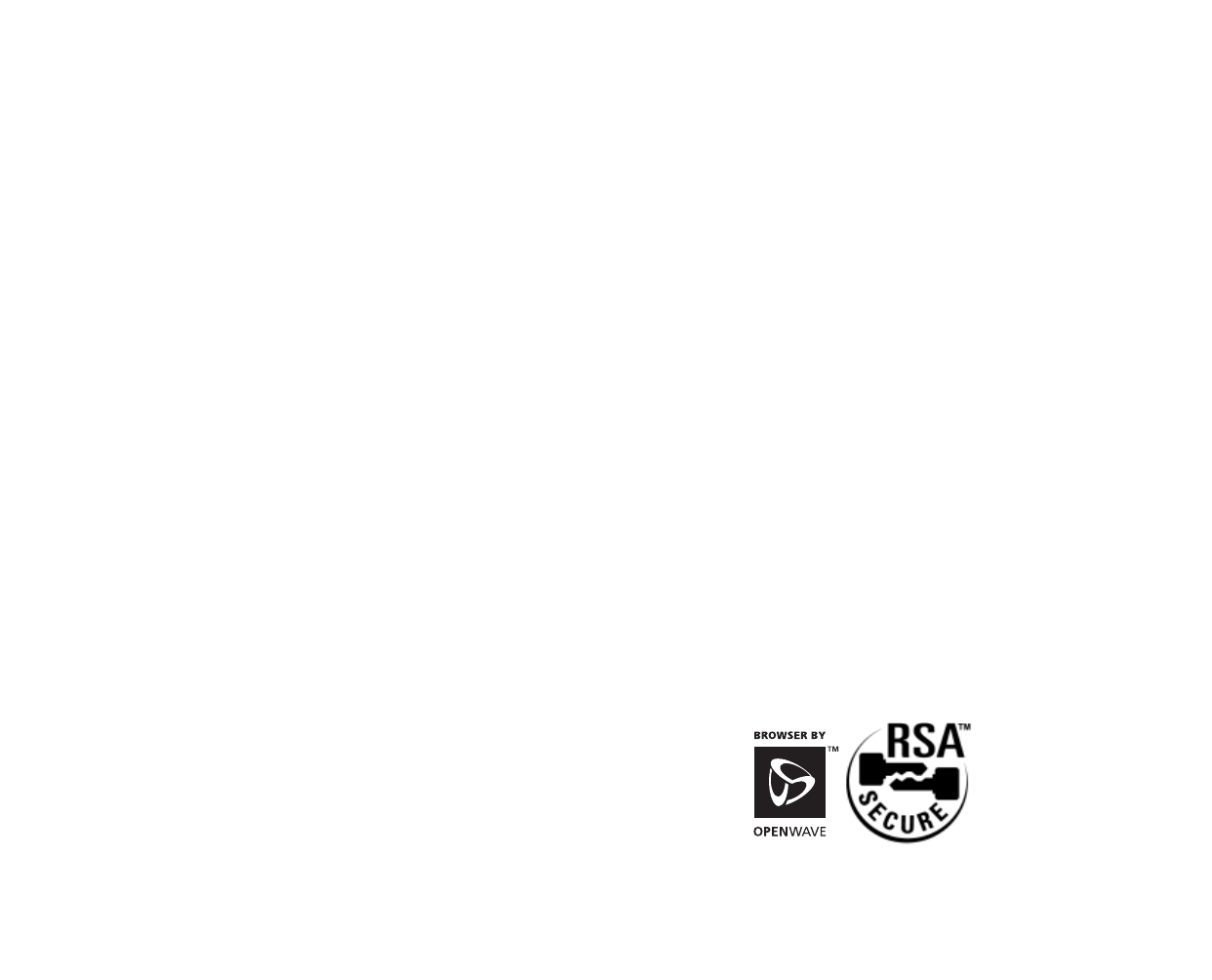
[INSERT PHONE-SPECIFIC BROWSER & SECURITY ID GRAPHICS]
[]
Copyright © 2002 Sprint Spectrum L.P.All rights reserved.No reproduction in whole or in part without prior
written approval.Sprint,PCS Vision,PCS Business Connection,and the diamond logo are trademarks of Sprint
Communications Company L.P.All other trademarks are property of their respective owners.
Section 4: Safety Guidelines and Warranty Information
4B:Warranty 158
SPRINT-motorola8/27 2003.8.27 2:17 PM Page 158

Index 161
Games 122
Messaging 107
Password 41
Pictures 118
Ringers 124
Screen Savers 126
Security Features 41
Signing In and Out 43
Web Connection 105
PCS Voice Command 131-133
Phone Number
Displaying 17
Picture Wallet 84
Pictures Password 82
Pictures Web Site 85
R
Ringer Types 26
Roaming 46
S
Security Menu 38
Sharing Pictures 86
Short Mail 109
Special Numbers 40
T
T9 Text Input 61
Three-Way Calling 97
TTY Use 32
U
Unlocking Your Phone 38
Updates 108
V
Voicemail
Clearing 94
Expert Mode 92
Menu 95
Notification 90
Options 92
Retrieving 91
Setting Up 5, 90
Volume Settings 28
W
Web 100
Browsing 101
Launching 100
Index 160
Index
[SAMPLE ONLY]
A
Airplane Mode 32
Answering Calls 18
B
Backlight 29
Battery
Capacity 15
Charging 16
Disposal 142
Installing 15
Removing 15
C
Call Guard 49
Call History
Erasing 58
Making a Call From 57
Options 56
Saving a Phone Number From
57
Viewing 56
Camera 79-86
Camera Mode Options 80
Managing Pictures 82
Review Mode Options 83
Taking Pictures 80
Chat 117
Clock 31
D
Dialing Options 19
Display Screen Symbols 12
Display Settings 29-31
E
Email 116
Entering Text
ABC Mode 62
Selecting a Character Input
Mode 60
Symbols and Numbers 62
T9 Text Input 61
F
FCC Notice 143
G
Greeting 29
I
Instant Messaging 111
Internal Phone Book
Adding an Entry 63
Editing Entries 65
Finding Entries 63
Options 60
Secret Entries 66
L
Location Settings 31
Locking Your Phone 38
M
Making Calls 17
Manufacturer’s Warranty 166
Menus
Diagram 53
Navigation 52
Structure 52
Viewing 53
Missed Call Notification 18
N
Net Guard 100
P
PCS Business Connection 128
PCS Services
Call Forwarding 98
Call Waiting 96
Caller ID 96
Customer Solutions 6
Directory Assistance 6
Operator Services 6
PCS Vision
Downloading Items 120
FAQs 129
SPRINT-motorola8/27 2003.8.27 2:17 PM Page 160

SPRINT-motorola8/27 2003.8.27 2:17 PM Page 162